The living forest
INVERTEBRATES GALLERY
We have already discovered hundreds of invertebrate species on the block, mostly spiders and insects, and identified a fair number. And we have really only just begun to get serious about surveying them!
Some invertebrates are beautiful, others bizarre but most go largely unseen. Yet, either directly or indirectly, this inconspicuous, teeming world supports the creatures which most people think of as 'animals' - creatures with a backbone. This gallery presents a brief glimpse of invertebrate life in the forest. It is a collection which we will continue to expand and refine in the coming months and years.
Scroll down for a pictorial tour.
All images were taken by us, on site, over the last few years.
Please note that some species identifications are tentative. We will continue to correct and refine these as we gather more information.

Botany Bay Diamond Weevil
Chrysolopus spectabilis
This attractive weevil has the distinction of being the first insect from Australia to be scientifically described - it was collected on Captain Cook's first voyage. Sightings here in the forest are quite common, although we usually see just a single insect at any one time.
It is no coincidence that in this image the beetle is pictured on a wattle - Acacia terminalis. Adult females bore holes into the stem of saplings of particular Acacia species, into which they lay their eggs. After the larvae hatch out, they dig into a main root and feed off the plant tissues as they continue their development.
The adults eat the wattle foliage and bore into twigs to extract the sap.
Order: Coleoptera; Family: Curculionidae (weevils or snout beetles)
Photo taken February

Elephant Weevil
Orthorhinus cylindrirostris
It's not hard to tell how this weevil got its name! Its host plants include the eucalypt Angophora floribunda, which is widespread on the block. The larvae tunnel into the wood.
Order: Coleoptera; Family: Curculionidae (weevils or snout beetles)
Photo taken in October
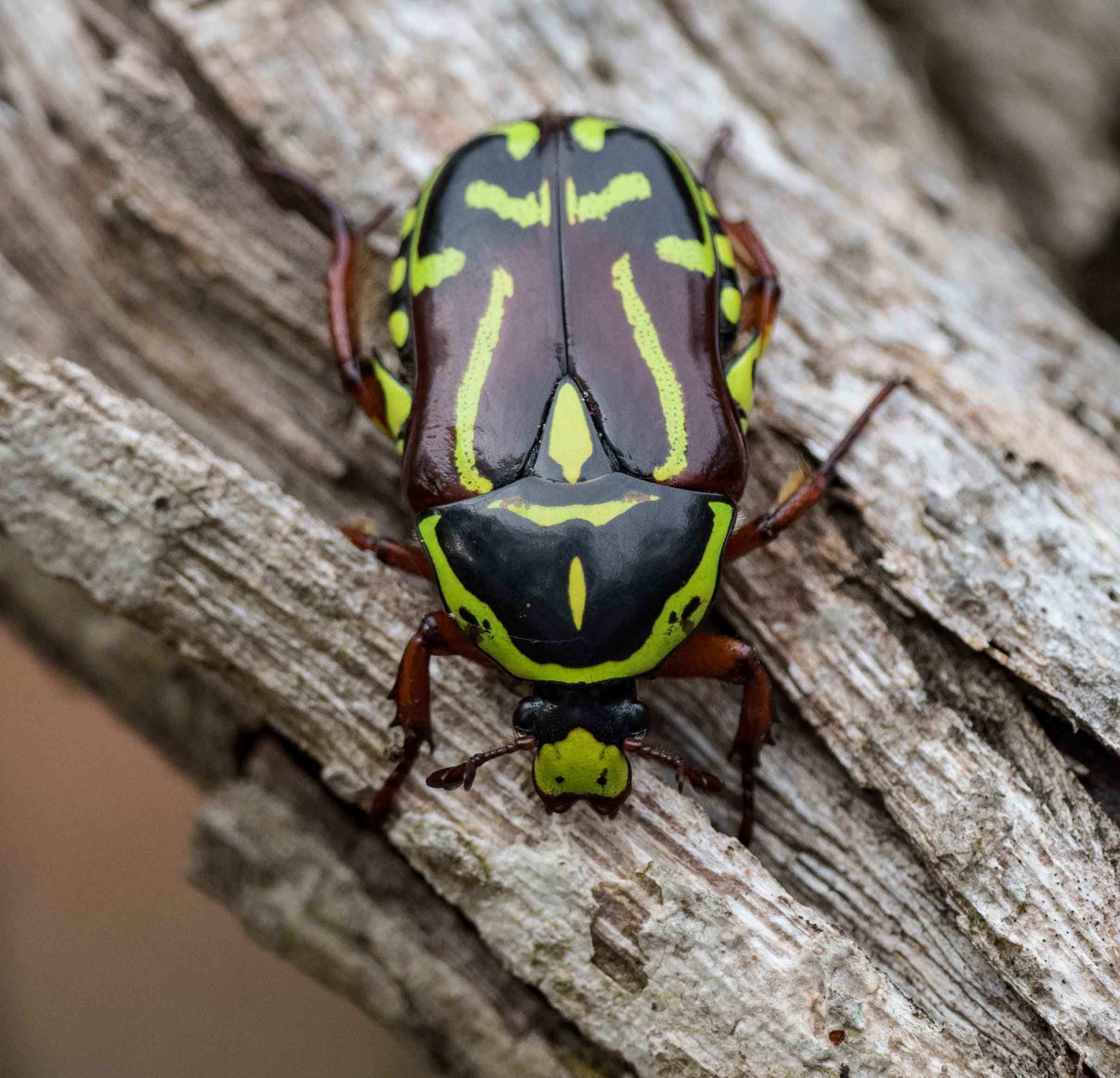
Fiddler Beetle
Eupoecila australasiae
These large and beautiful beetles are also referred to as Horseshoe Beetles. They belong to a group of scarabs called flower chafers. They are active during the day, which is rather unusual for scarabs. The adults feed on pollen and nectar - particularly that of Eucalyptus, Angophora and Leptospermum - and play an important role in pollination.
Order: Coleoptera; Family: Scarabaeidae, Subfamily: Cetoniinae (flower chafers)
Photo taken February

Fiddler Beetle
Eupoecila australasiae
The larvae feed on rotting plant material, including that found under fallen logs. Perhaps that was what this beetle was searching for. The pattern from this angle must look quite intimidating to a small predator!
Order: Coleoptera; Family: Scarabaeidae, Subfamily: Cetoniinae (flower chafers)
Photo taken February
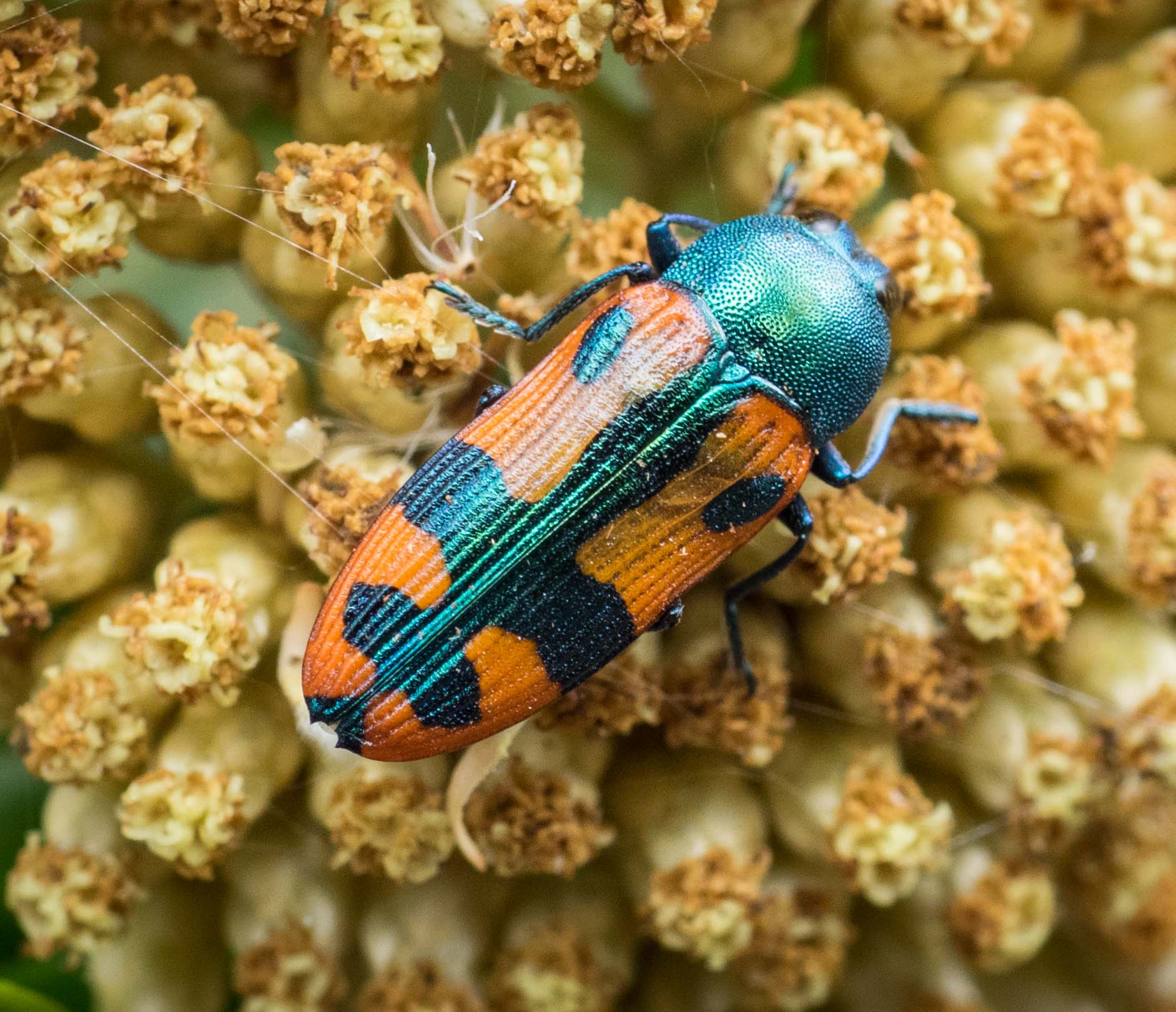
Jewel Beetle
Castiarina scalaris
The long-lasting flowers of Ozothamnus obcordatus bushes attract many insects and spiders. Jewel Beetles are among the more colourful, feeding on the nectar and petals of the flowers. These beetles may play a role in pollination. The larvae of most Jewel Beetles are wood borers.
The family Buprestidae is huge, with over 1200 Australian species described to date - and many others not yet named! We were fortunate that this species is a known one.
Order: Coleoptera: Family: Buprestidae (jewel or metallic wood-boring beetles)
Photo taken in November
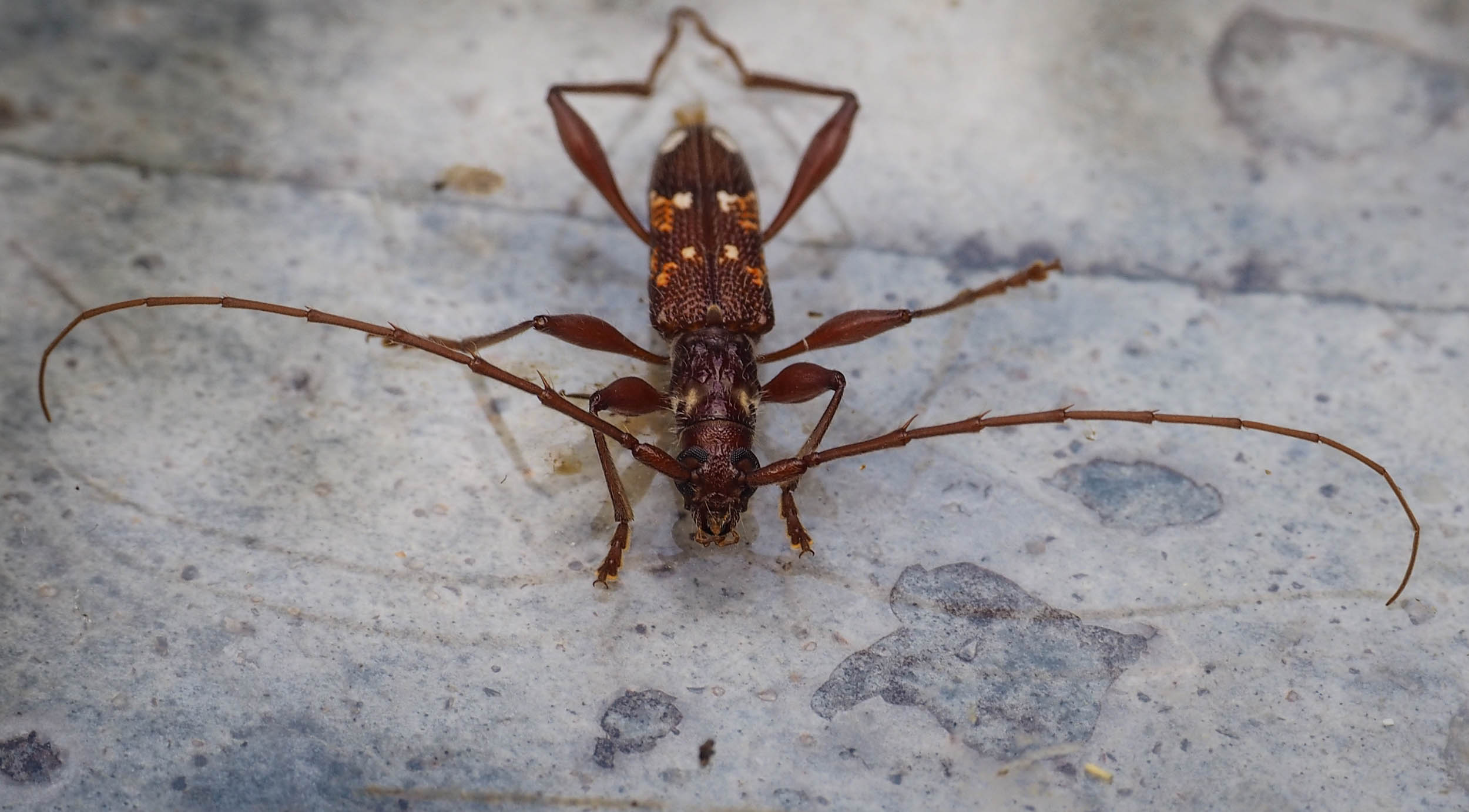
Longicorn Beetle
Coptocercus biguttatus
This image illustrates how this family of beetles was awarded its common name! The larvae of longhorn beetles are wood borers and play an important role in recycling the carbon in dead and dying trees.
Order: Coleoptera; Family: Cerambycidae (longhorn or longicorn beetles)
Photo taken in February
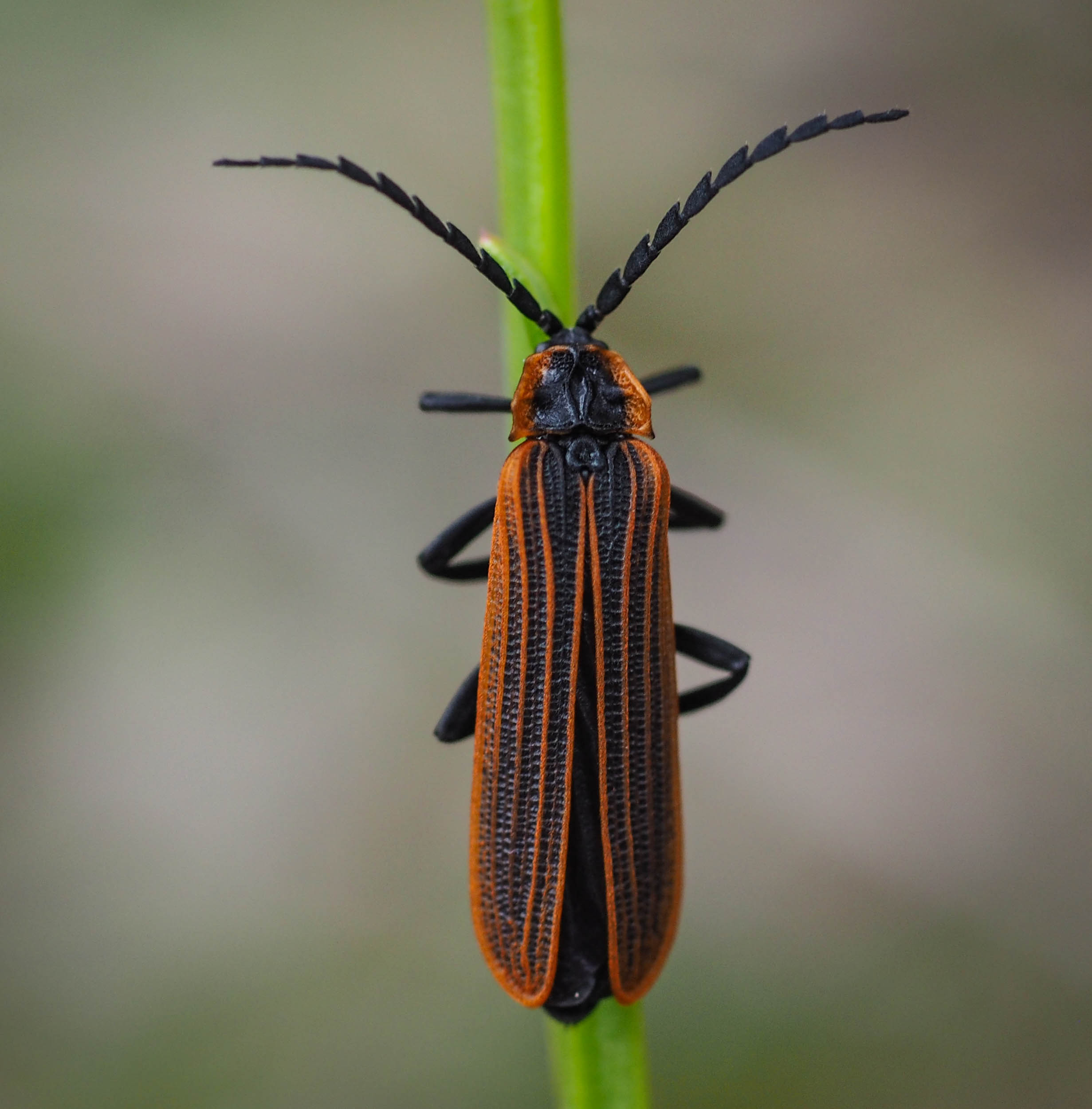
Net-winged beetle
Porrostoma sp. (?)
Occasionally in Summer, and for brief periods, these insects are a common sight in the forest. They are reasonably large and distinctive, both in colour and shape. And they often perch for extended periods on grasses and flowering shrubs.
As adults, Porrostoma are reported to feed on flowers and nectar. The larvae live and feed in the leaf litter.
Apparently this family of beetles is mimicked by various moths and other beetles. I am reasonably confident of the identification here, at least to family, but would need to examine one more closely to be confident of the genus.
Order: Coleoptera; Family: Lycidae (net-winged beetles)
Photo taken in November
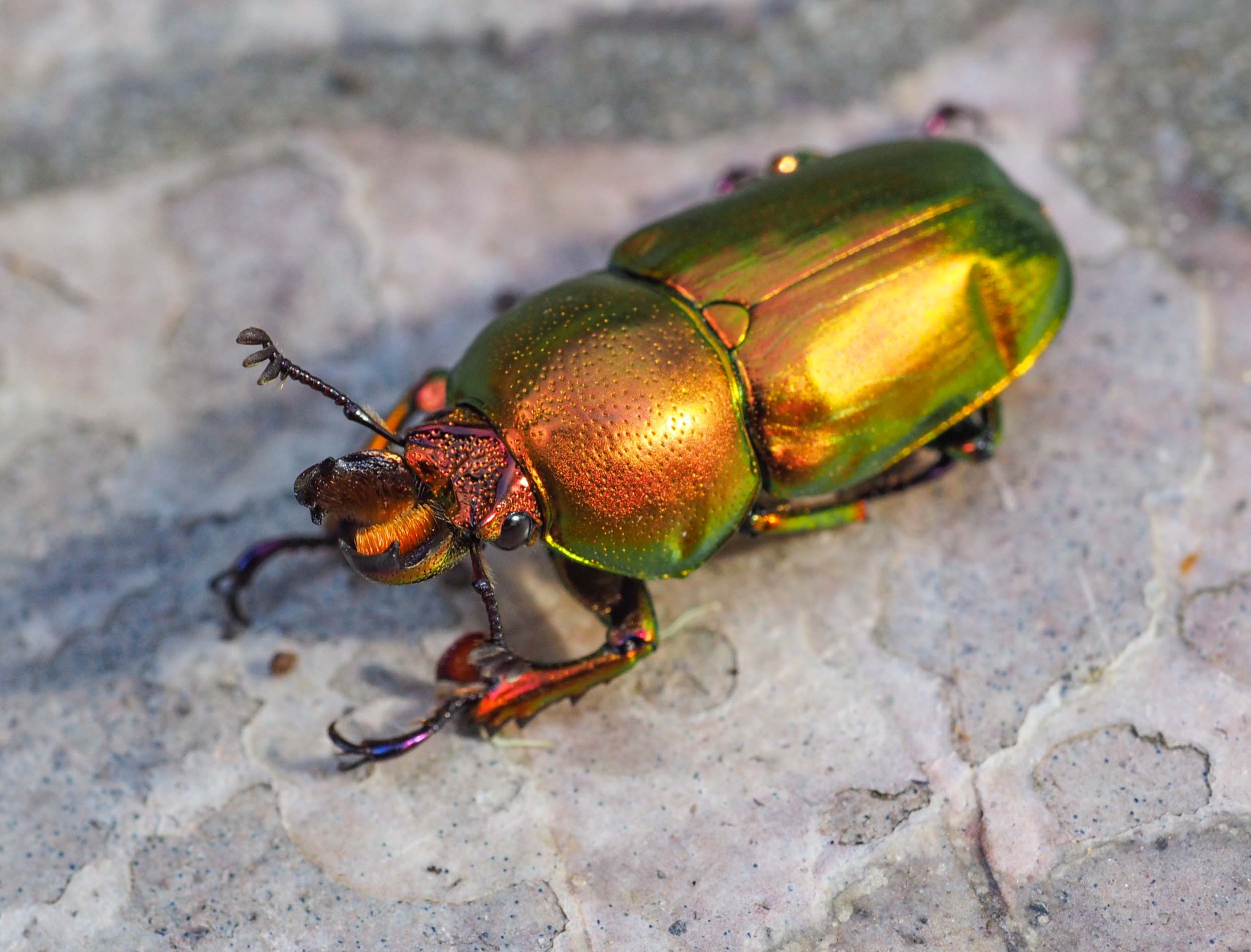
Golden Stag Beetle (male)
Lamprima aurata
This brilliantly-coloured male shows the prominent, antler-like mandibles that give the family its name. The larvae, which have the familiar "witchety grub" appearance, are wood borers. They are useful carbon-recyclers, living within sick, decaying casuarina trees, rather than healthy trees.
Order: Coleoptera; Family: Lucanidae (stag beetles)
Photo taken in January
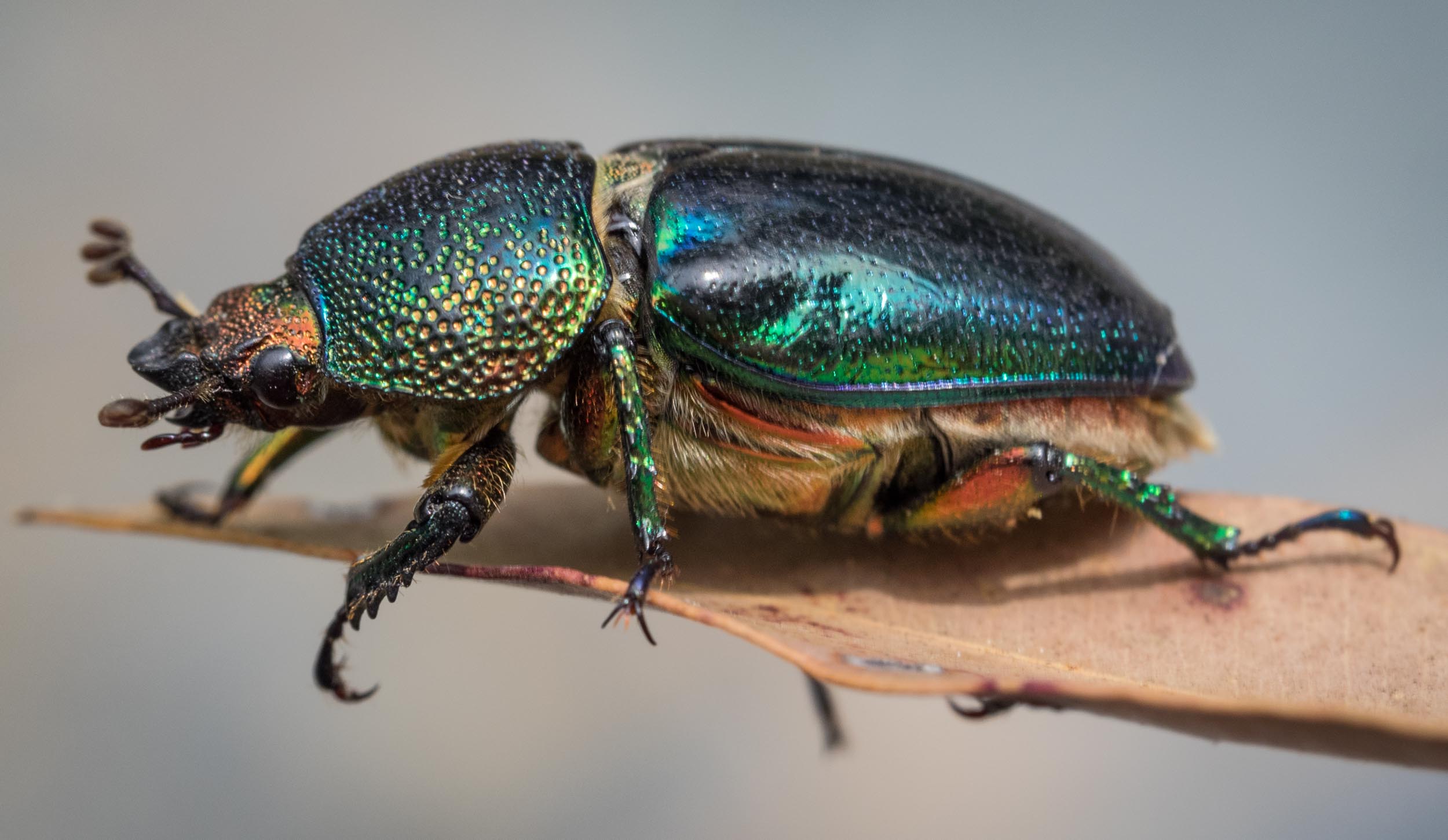
Stag Beetle (female)
Lamprima varians
This female belongs to the same genus as the Golden Stag Beetle. She lacks the impressive antler-shaped mandibles seen in the male.
Order: Coleoptera; Family: Lucanidae (stag beetles)
Photo taken in January
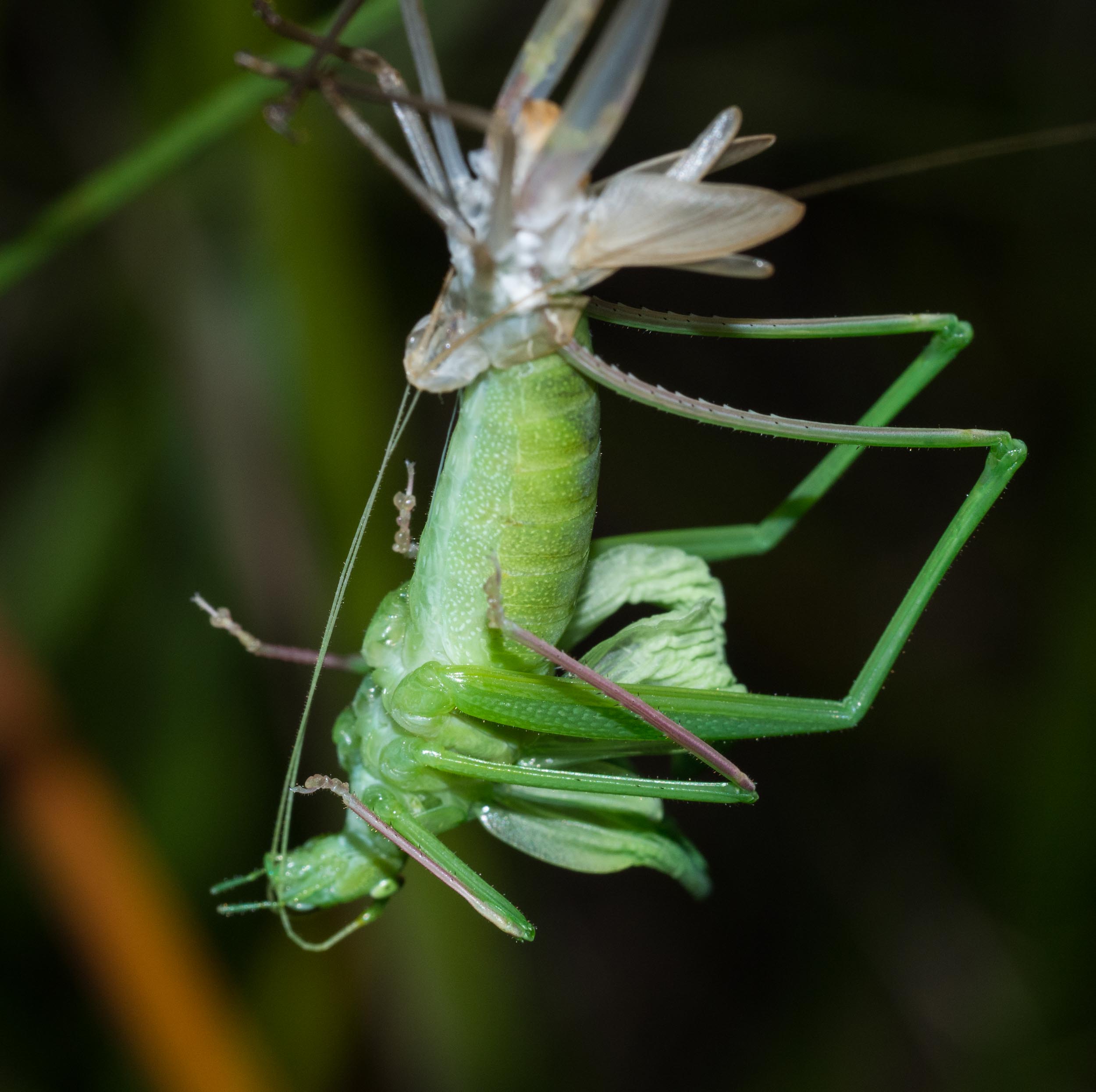
Garden Katydid
Caedicia simplex
This katydid is in the same insect order as grasshoppers and crickets, but can be readily distinguished from them by its long antennae. They go largely unnoticed during the day because they are well camouflaged within low shrubs, rushes and grasses. We see them moving around more actively on warm evenings. Katydids are herbivores, eating young foliage and petals.
This image shows an adult emerging from its nymphal skin at night. The wings will gradually inflate through blood pressure and it is likely that, before it departs the scene, the adult will consume its cast off skin - excellent recycling!
Order: Orthoptera; Family: Tettigoniidae (katydids, bush-crickets)
Photo taken in January
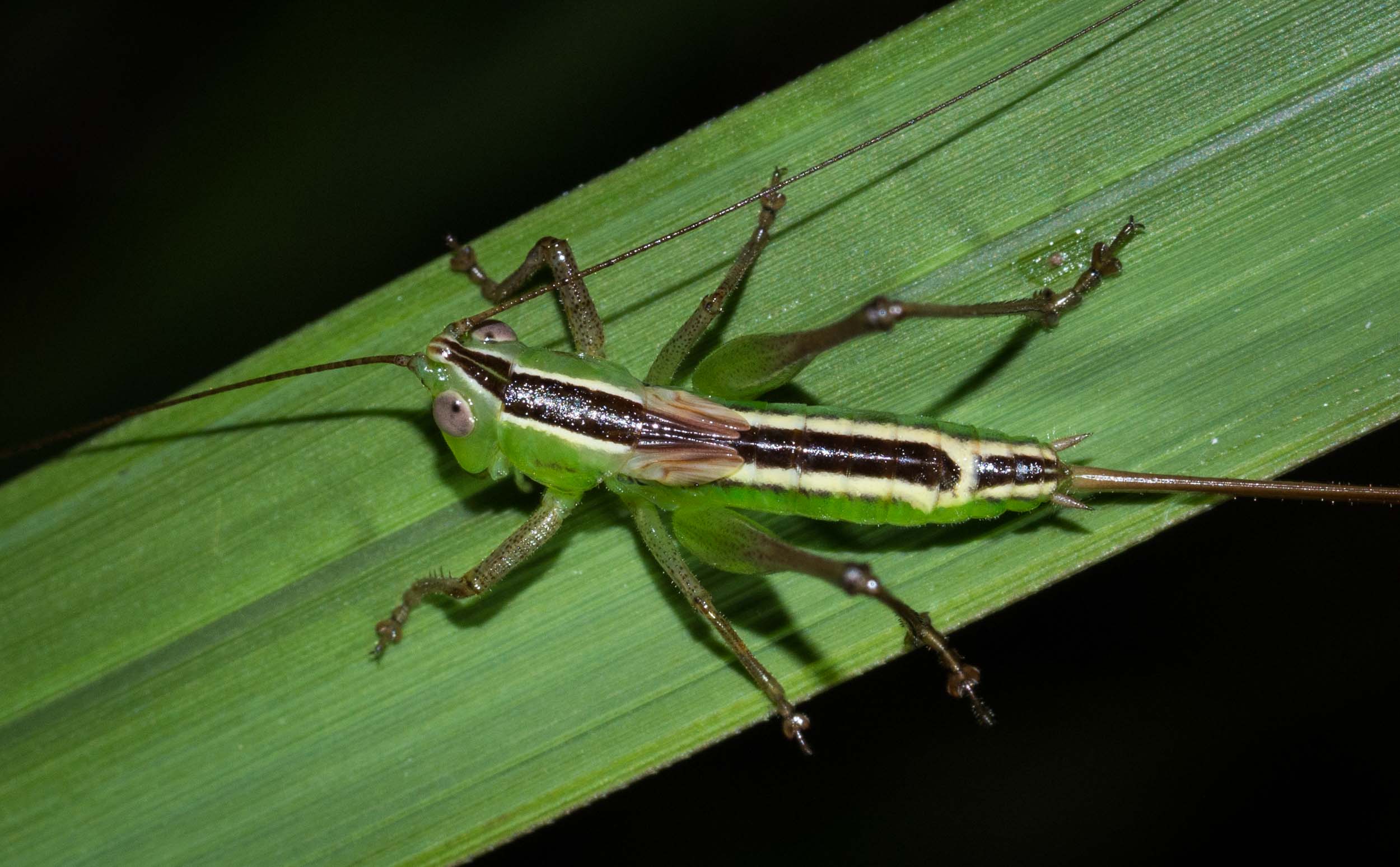
Upolo Meadow Katydid
Conocephalus upoluensis
This katydid is similar in its habits and lifestyle to the 'Garden Katydid'. Its is also a nocturnal species, searching for its food - flowers and seeds of grasses and other plants - on warm nights in Summer, when we hear its low buzzing calls. The short wing stubs of the individual in this image shows that it is a nymph.
Like other hemimetabolous insects, orthopterans go through a series of nymphal stages after hatching from the egg. The nymphs closely resemble the adult but they lack reproductive organs and have undeveloped or no wings.
Order: Orthoptera; Family: Tettigoniidae (katydids, bush-crickets)
Photo taken in January
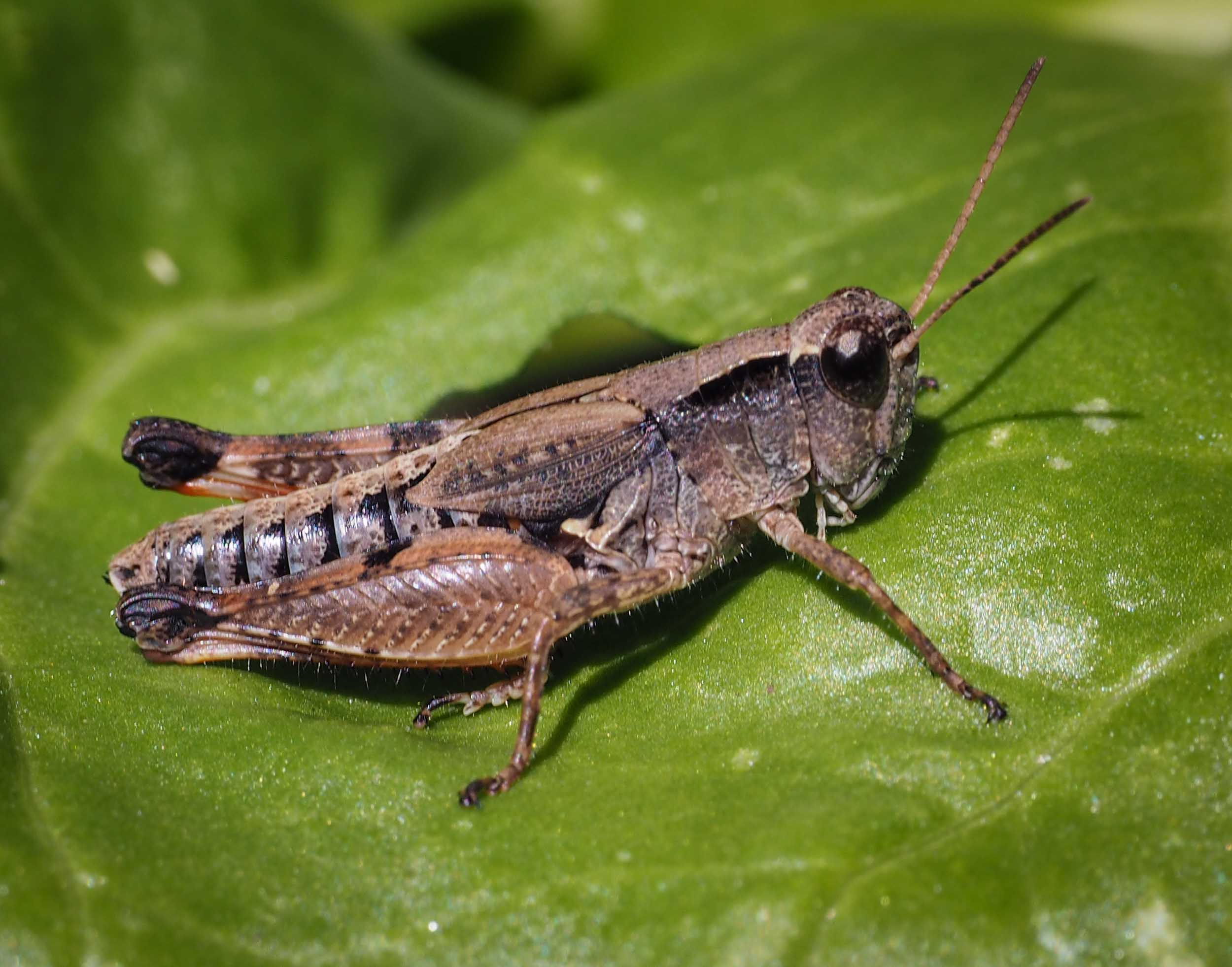
Wingless Grasshopper
Phaulacridium vittatum
The common name for this grasshopper is not entirely accurate, as it does have wings - albeit short, non-functional ones. In fact, even that is not correct - some adults do have full sized wings and can fly. Don't you love common names!! The proportion of fully winged animals in a population increases as population density increases.
We first start to see nymphs in November, and by December the area around the house is often swarming with adults. They take a toll on some plants in our vegetable garden but the native forbs don't seem to suffer too much. The grasshoppers themselves are avidly eaten by a range of birds, including Yellow-faced Honeyeaters and Spotted Quail-thrush. All good!
Order: Orthoptera; Family: Acrididae (grasshoppers, locusts)
Photo taken in January

Wingless Grasshopper
Phaulacridium vittatum
This proves that these Wingless Grasshoppers are indeed the adults of the species, and not just nymphs! A mating pair - as usual, males are smaller than females.
Order: Orthoptera; Family: Acrididae (grasshoppers, locusts)
Photo taken in February

Giant Green Slant-face
Acrida conica
We often see this grasshopper in late Summer among the long grasses and forbs. An unusual beast, with that elongated head! It would make a nice treat for a larger bird, such as a Black-faced Cuckoo Shrike, if the birds could sight it - it is superbly camouflaged. We only see them if they are disturbed and 'flush' from the vegetation.
Order: Orthoptera; Family: Acrididae (grasshoppers, locusts)
Photo taken in March

Common Psednura
Psednura sp.
This nymph belongs to a small group of grasshoppers found only in Australia.
Order: Orthoptera; Family: Pyrgomorphidae
Photo taken in October

Wood Cricket
Apotrechus unicolor
We only chance across this species occasionally, as during the day it lives in the leaf litter in a shelter constructed from leaves and twigs. And it needs to hide! Such a large and soft-bodied insect would provide a good meal for many insectivorous birds and other animals. In fact we once saw a Spider Wasp hauling a Wood Cricket, paralysed, back to the wasp's nesting burrow.
Apotrechus unicolor are large insects. The one in the photo is a nymph, and just 35mm long - we have found adult females with a body length of 50mm!
Wood Crickets become active in the evening when they climb vegetation to feed. Other individuals we have seen had much longer antennae - we presume this one was damaged.
Order: Orthoptera; Family: Gryllacrididae (wood crickets, leaf-rolling crickets)
Photo taken in March

Australian Green Mantis
Orthodera ministralis
We generally encounter this species on shrubs in the more open areas of the forest, hunting small insects. This individual was quite small - only about 15mm long. Mantids really are the most elegant of insects!
Order: Mantodea; Family: Mantidae (praying mantises)
Photo taken in December
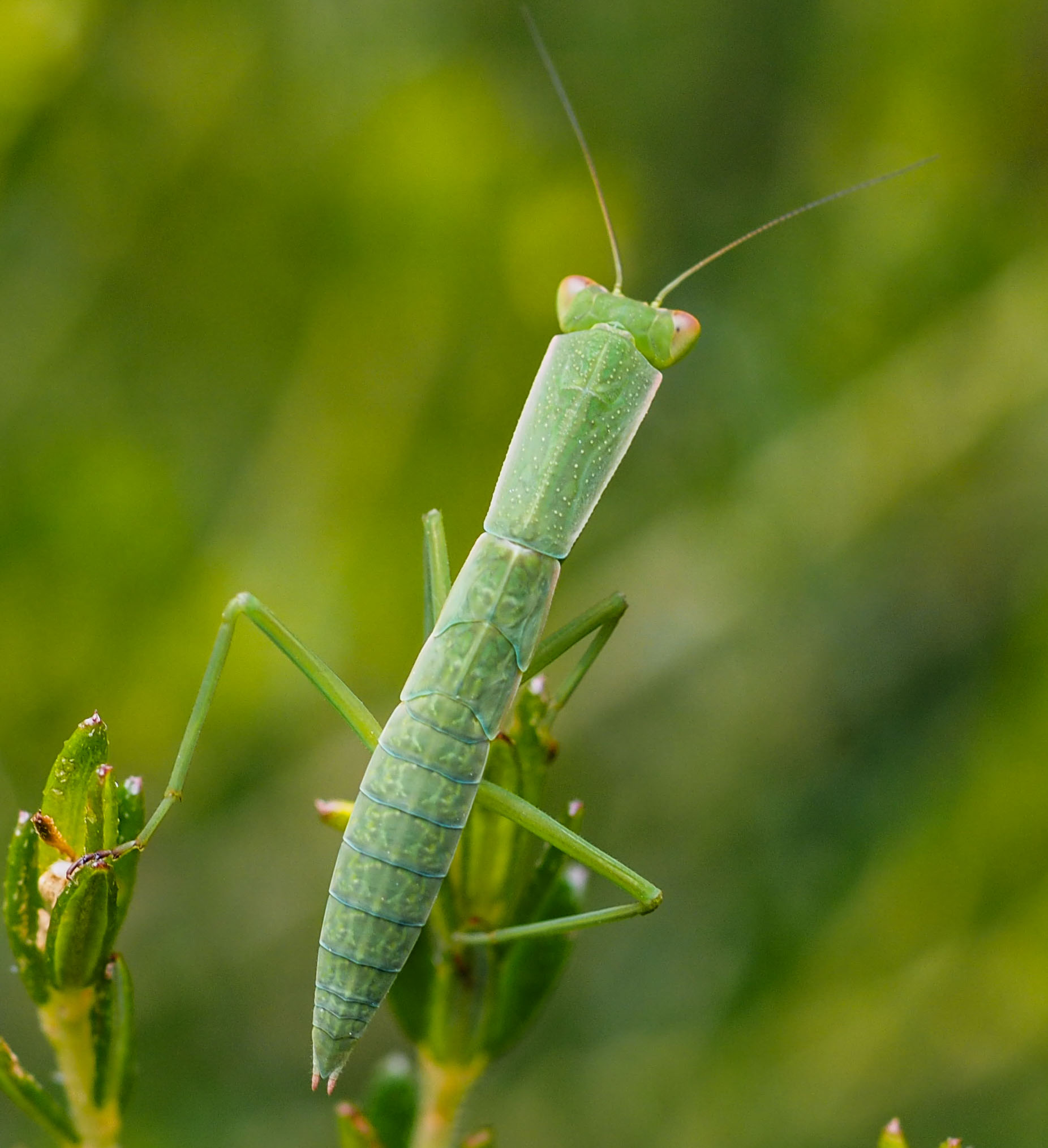
Australian Green Mantis
Orthodera ministralis
This view from above gives a sense of how well camouflaged the insect is, particularly as it moves little, just sitting, scanning, occasionally swaying. This is a nymph, still wingless. We have seen the winged adult in April.
Order: Mantodea; Family: Mantidae (praying mantises)
Photo taken in December
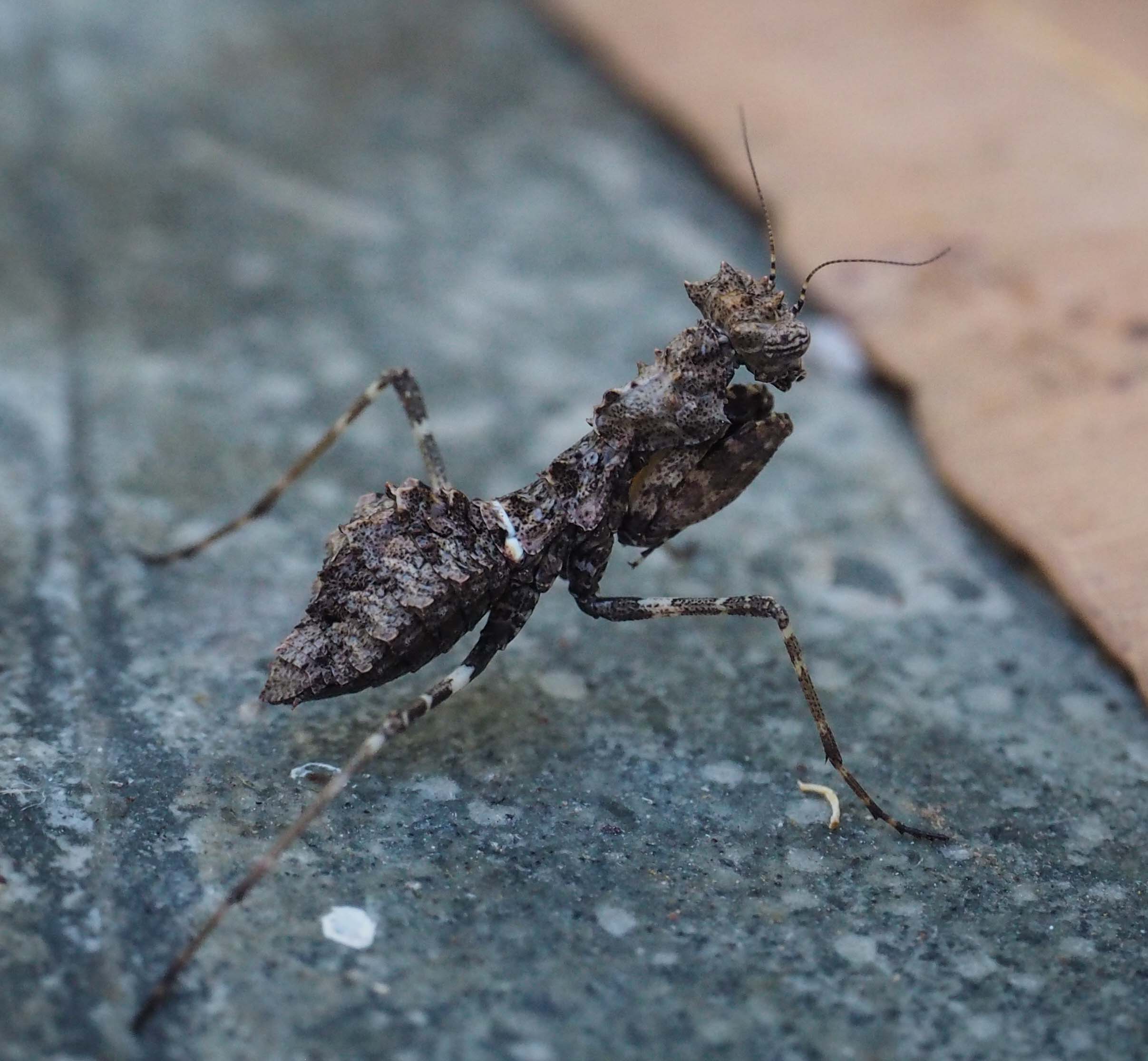
Boxer Bark Mantid
Paraoxypilus sp.
You'll have to imagine this beautiful little mantid in its natural bushland setting, on the forest floor, to appreciate how superbly well camouflaged it is. It is a tiny beast - only 20mm long. This one is a female - the male is winged.
Order: Mantodea; Family: Amorphoscelidae (praying mantises)
Photo taken in January
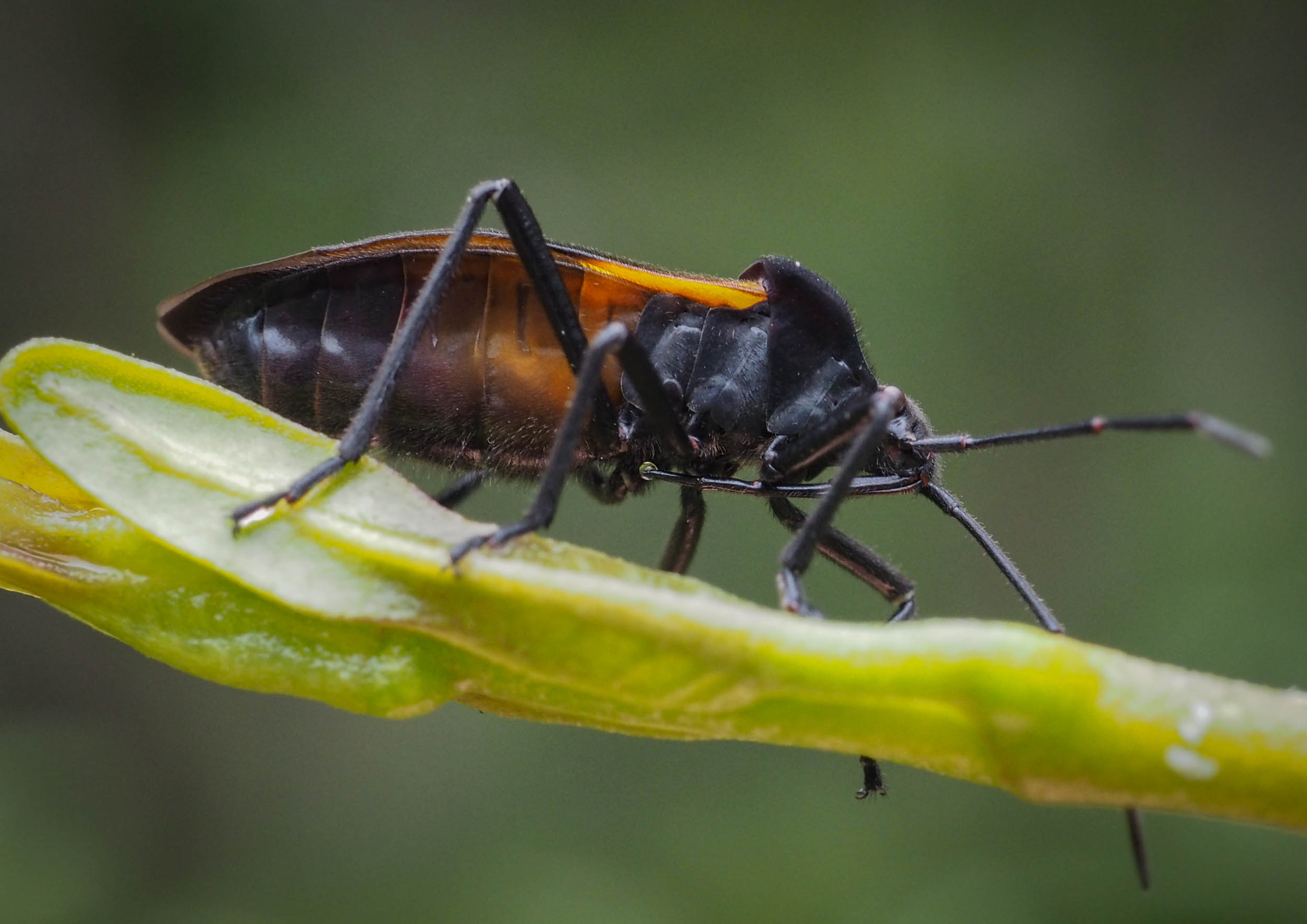
Milk Vine Bug
Oncopeltus sordidus
This "bug" is a true bug, belonging to the insect order Hemiptera. Most hemipterans feed on plant juices, penetrating the surface of a leaf or stem with their specialised mouthparts. This piercing-sucking 'stylet' is a distinctive feature of hemipteran insects.
There are two vines growing here that belong to the family Apocynaceae - Marsdenia rostrata and Tylophora barbata. And by mid Summer, both vines are covered in Oncopeltus bugs. The adults are winged and quite mobile.
Order: Hemiptera; Family: Lygaeidae (seed bugs)
Photo taken in January

Milk Vine bugs
Oncopeltus sordidus
The young nymphs clump together, gradually dispersing more independently as they grow. Like the adults, nymphs too are typical hemipterans, piercing the host plant and drawing out the sap. By late summer, the Marsdenia leaves are looking sick, with large pale blotches.
Most groups of sap-sucking insects are attended by ants. The ants drink the sugar-rich secretions of the insects. We have never seen ants attending the Oncopeltus. Perhaps the toxicity of the Marsdenia sap makes the 'honeydew' of these bugs unpalatable, or even toxic.
Order: Hemiptera; Family: Lygaeidae (seed bugs)
Photo taken in January

Psyllid and lerps
Glycaspis seriata
Perhaps the most ecologically-important hemipterans in a forest ecosystem are the psyllids, or 'lerps'. These bugs and, most notably, their nymphs, provide food for a large number of bird species. Pardalotes are lerp-feeding specialists, and lerps also feature heavily in the diets of Thornbills and Rosellas.
The 'lerp' actually refers to the cap that the larvae produce and shelter beneath. It is this sugar-rich cap that the birds are so fond of.
Explosions in psyllid numbers can also cause significant damage to trees, and for this reason they are often considered a 'pest' insect. The adults are winged and resemble plant hoppers.
In this photo, I have exposed one small nymph by removing its cap. Normally they would rarely be so exposed, but would instead enlarge the covering cap as they grow.
Order: Hemiptera; Family: Psyllidae (psyllids)
Photo taken in February
Click to read 'Exuding Abudance', an excellent 2012 Birdlife article by Tim Low, reviewing the role of lerps in Australian ecosystems.
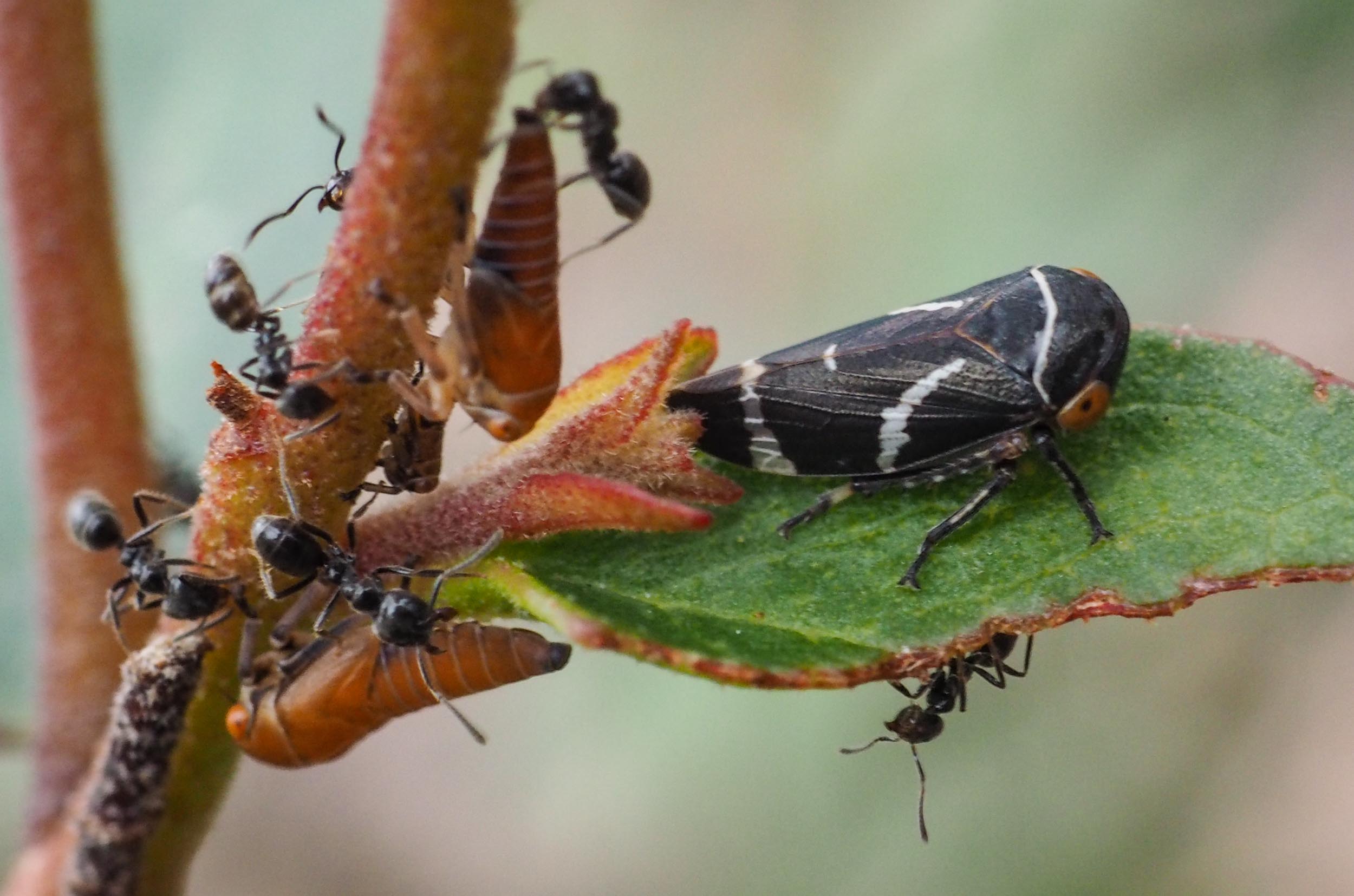
Two-lined Gumtree Leafhopper
Eurymeloides bicincta
These are the most common leafhoppers we see. Most young eucalypt saplings are colonised by the bugs - and their attending ants. Typically all stages of nymphs as well as winged adults share a branch. They appear to feed from the stems rather than the leaves.
The ants in this case are likely to be Iridiomyrmex.
Order: Hemiptera; Family: Cicadellidae (leafhoppers)
Photo taken in March
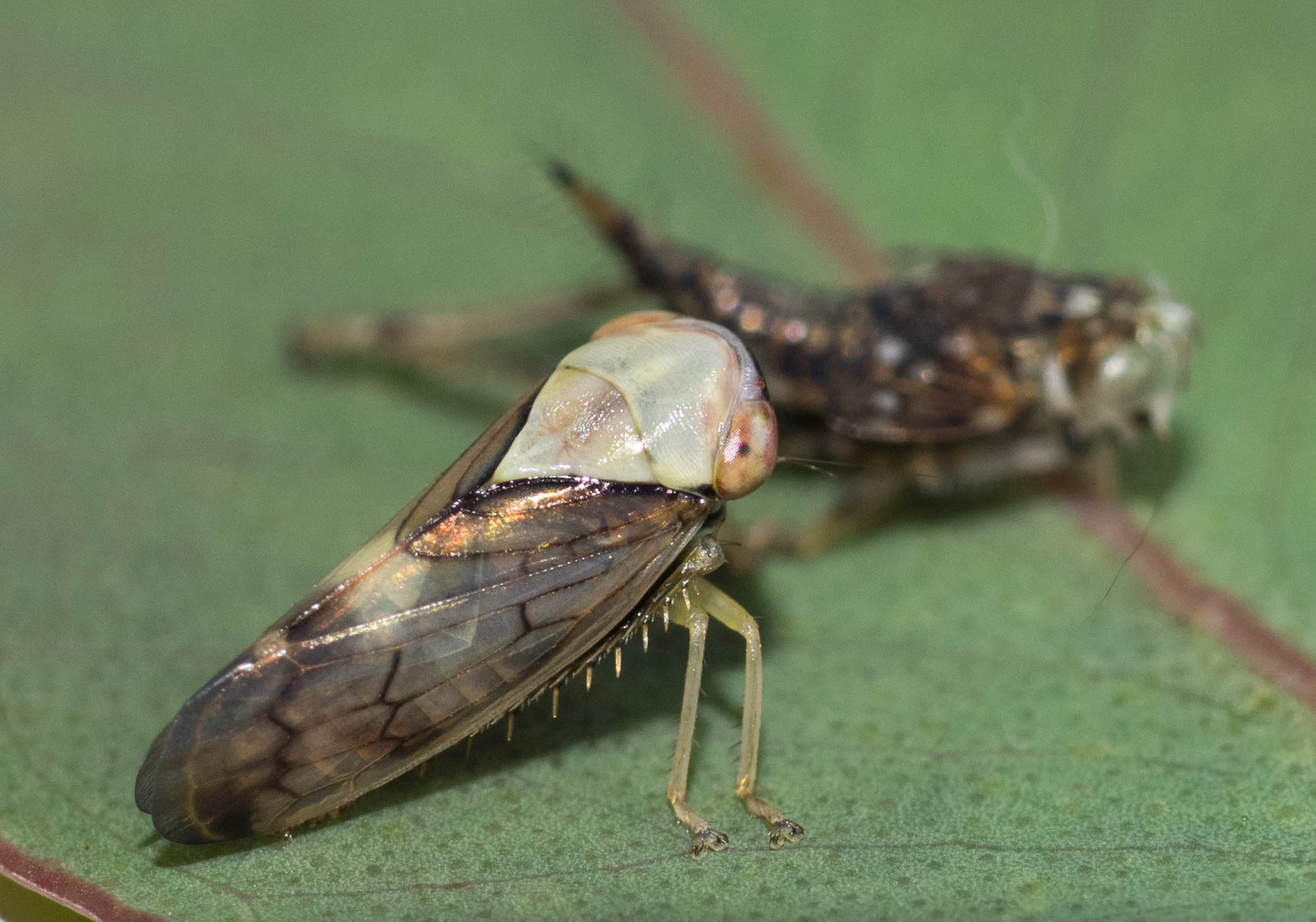
Leafhopper
Brunotartessus sp (?)
I took this photo only moments after the leafhopper had emerged from its nymphal skin. And a few hours later, the head and body of the insect had turned a beautiful blue! We commonly see the nymphs of this species on eucalypt seedlings. They are very alert, and quickly move to the hidden side of the leaf when disturbed ... making photography a tricky exercise.
Leafhopper identification can be complex. Although superficially similar to Brunotartessus fulvous, I am not confident of the identification and so need to look more closely at this species.
Order: Hemiptera; Family: Cicadellidae (leafhoppers)
Photo taken in March
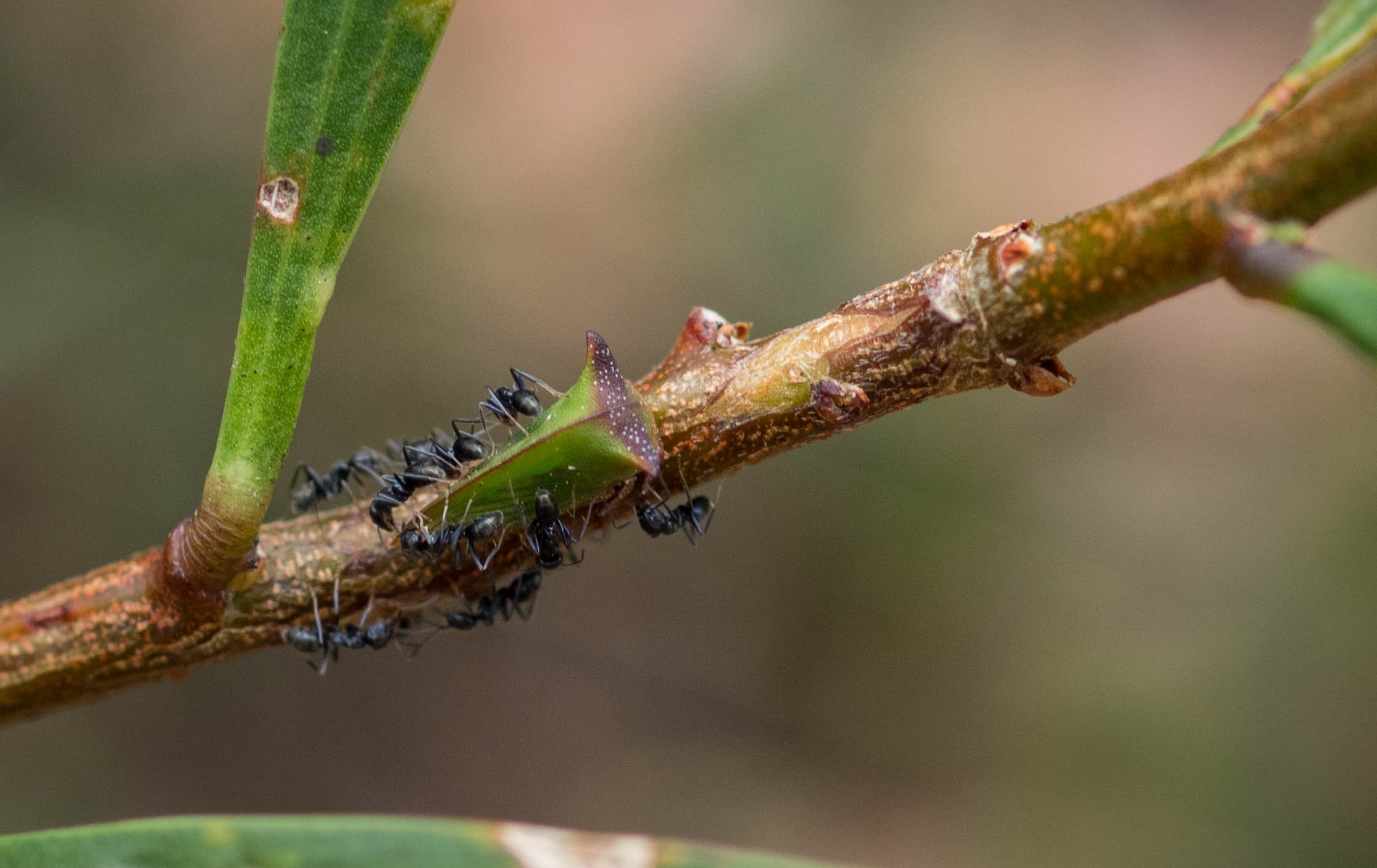
Green Treehopper
Sextius virescens
Yet another ant-attended hemipteran species. This bug is feeding on Acacia longifolia - and bears a striking resemblance to the leaf buds on the plant!
Order: Hemiptera; Family: Membracidae (horned treehoppers)
Photo taken in February
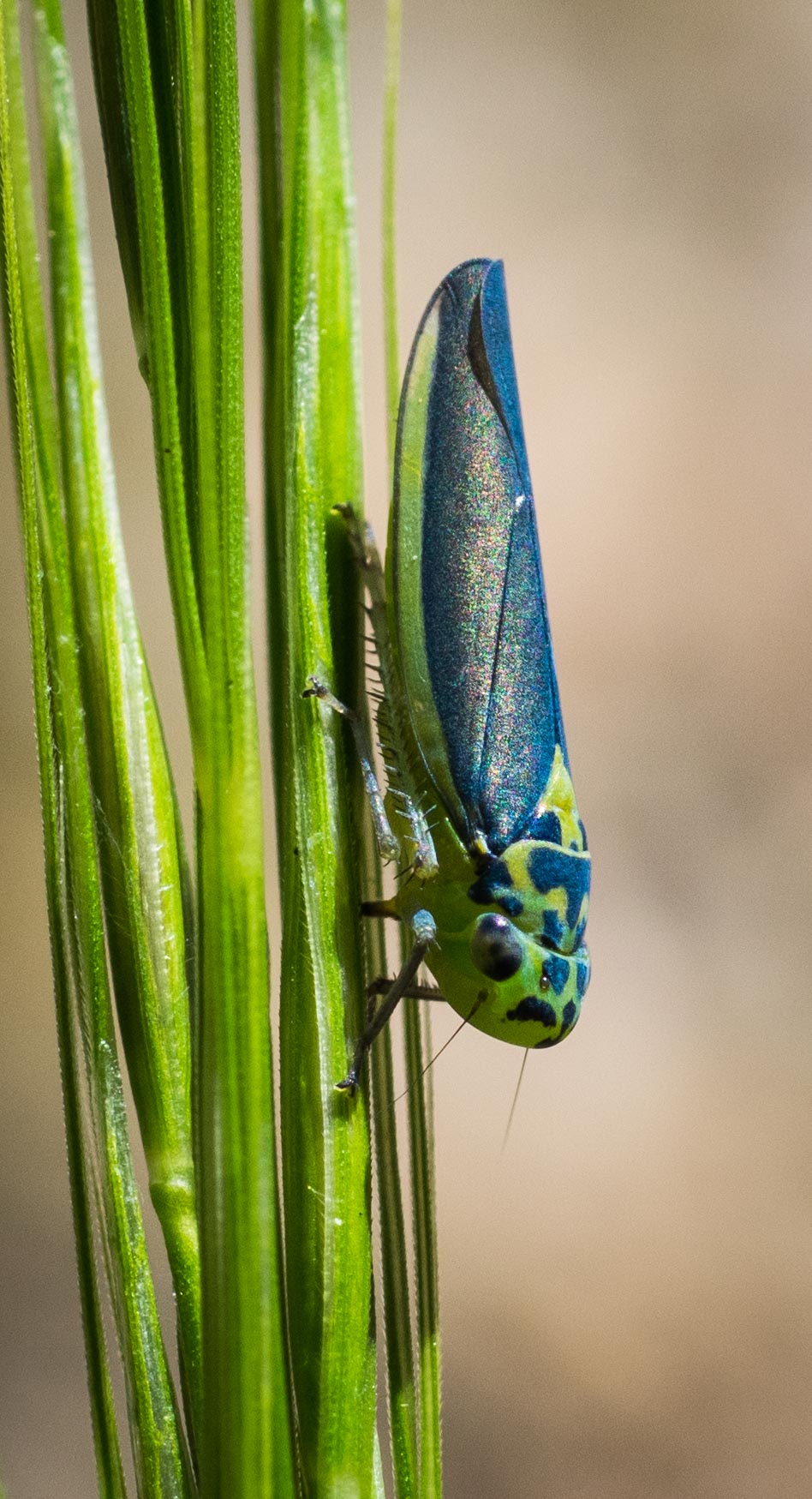
Leafhopper
Ishidaella sp.
We discovered this particularly colourful leafhopper on a flowering grass head. There was just one, which is a little unusual. Typically, leafhoppers are found in large numbers and at various stages of development. Given that this lone insect was fully winged, I assume it was in the process of dispersing and had undergone its early (flightless) development at another site.
At about 3mm, Ishidaella is larger than many of the leafhopper species we see.
Order: Hemiptera; Family: Cicadellidae (leafhoppers)
Photo taken in November
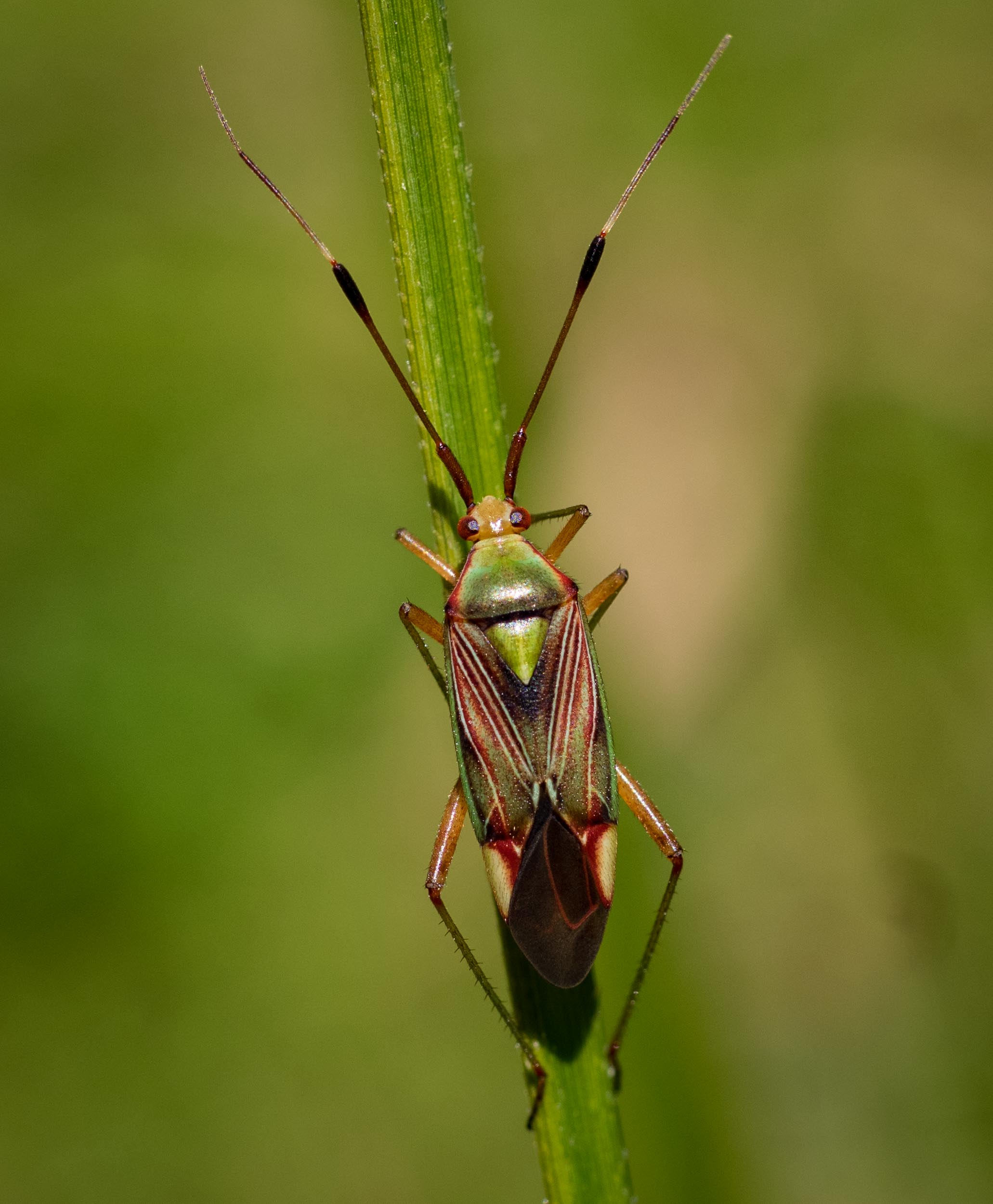
Red Mirid Bug
Pseudopantilius australis
We discovered just two of these large and beautiful bugs, one on Lomandra, the other nearby on a Leucopogon bush. Their colours are just stunning!
However, as a group, Miradae are not well-loved. Many species are sap-sucking agricultural pests.
Order: Hemiptera; Family: Miridae (mirid bugs)
Photo taken in October

Toad Bug
Nerthra sp. (?)
The plant-sucking hemipterans like the leafhoppers and aphids can be a pest in agricultural situations but, in the animal world, they are rather benign. The same cannot be said for all hemipterans, however.
This tiny Toad Bug is a predator. It hunts under the leaf litter, in sand and muddy soil. And it is nearly invisible! We had lived in the forest for several years before I noticed them for the first time, yet they are quite common. Now that I recognise them as an insect - and not just a piece of dead vegetation! - I can find them quite readily.
Order: Hemiptera; Family: Gelastocoridae (toad bugs)
Photo taken in November
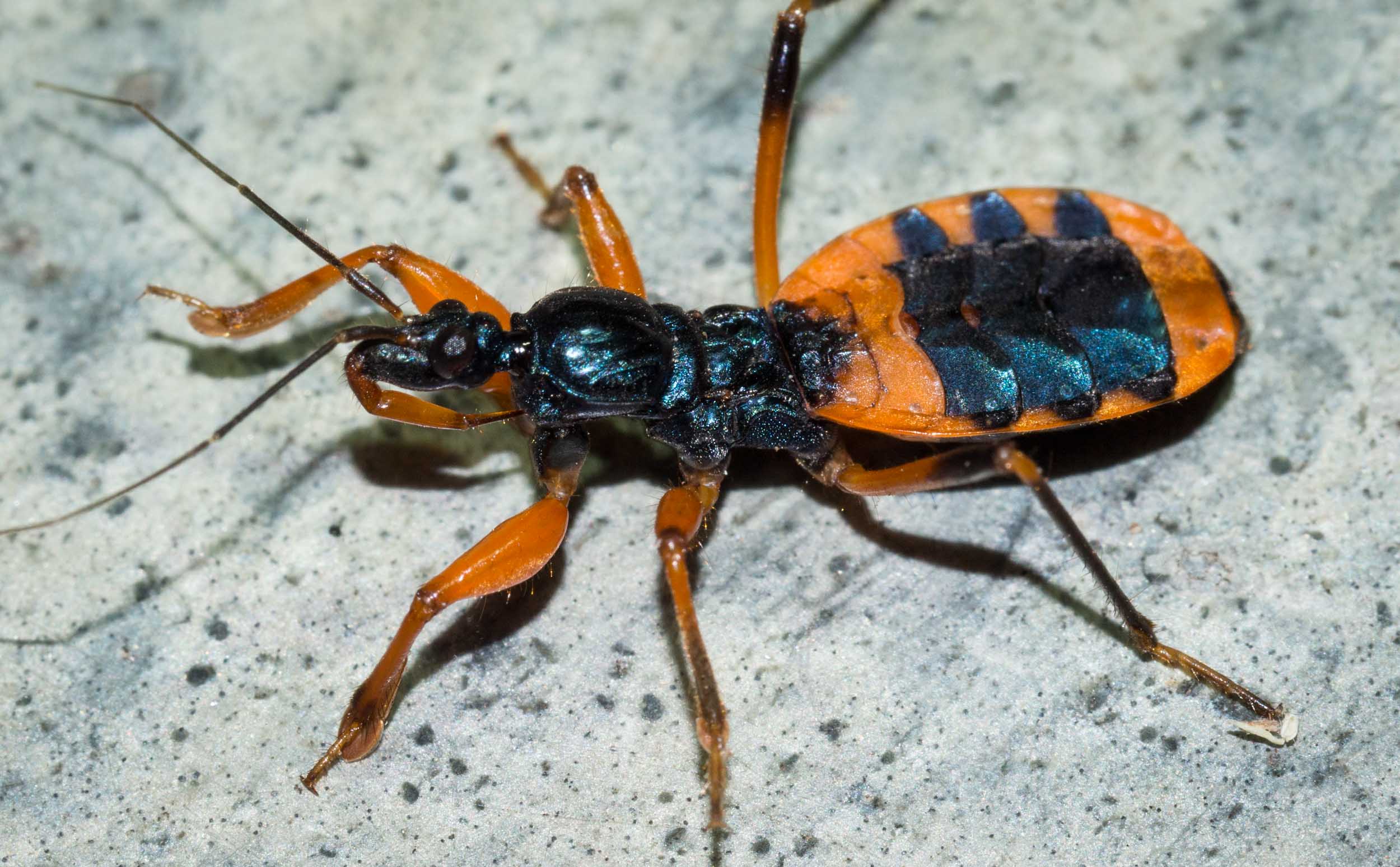
Ground Assassin Bug
Ectomocoris patricius
When it comes to predatory hemipterans, Assassin Bugs are perhaps the most ferocious. In the Reduviidae, the specialised hemipteran mouthparts have further evolved into a lethal weapon. And they are generally quite large insects!
The Assassin Bug uses its massively-enlarged stylet for both prey capture and feeding. It impales another insect, injecting it with venom and also with digestive enzymes. Finally, it sucks pre-digested tissues of the unfortunate prey back up through the stylet. Handle with caution!
To date we have identified three species of Assassins here in the forest.
Order: Hemiptera; Family: Reduviidae (assassin bugs)
Photo taken in January

Common Paper Wasps
Polistes humilis
Wasps, bees and ants belong to a single order - Hymenoptera. Some species live in colonies with complex social structures, but many others are solitary insects.
Nearly all social wasps belong to the same family - Vespidae. Polistes build their colonial, 'paper' nests from chewed wood mixed with saliva. These nests are elaborate constructions, with new cells being added even as larvae are developing in the older cells. We have discovered several nests hanging in low shrubs - in this photo, in a Geebung (Persoonia levis).
Order: Hymenoptera; Family: Vespidae (vespid wasps)
Photo taken in February
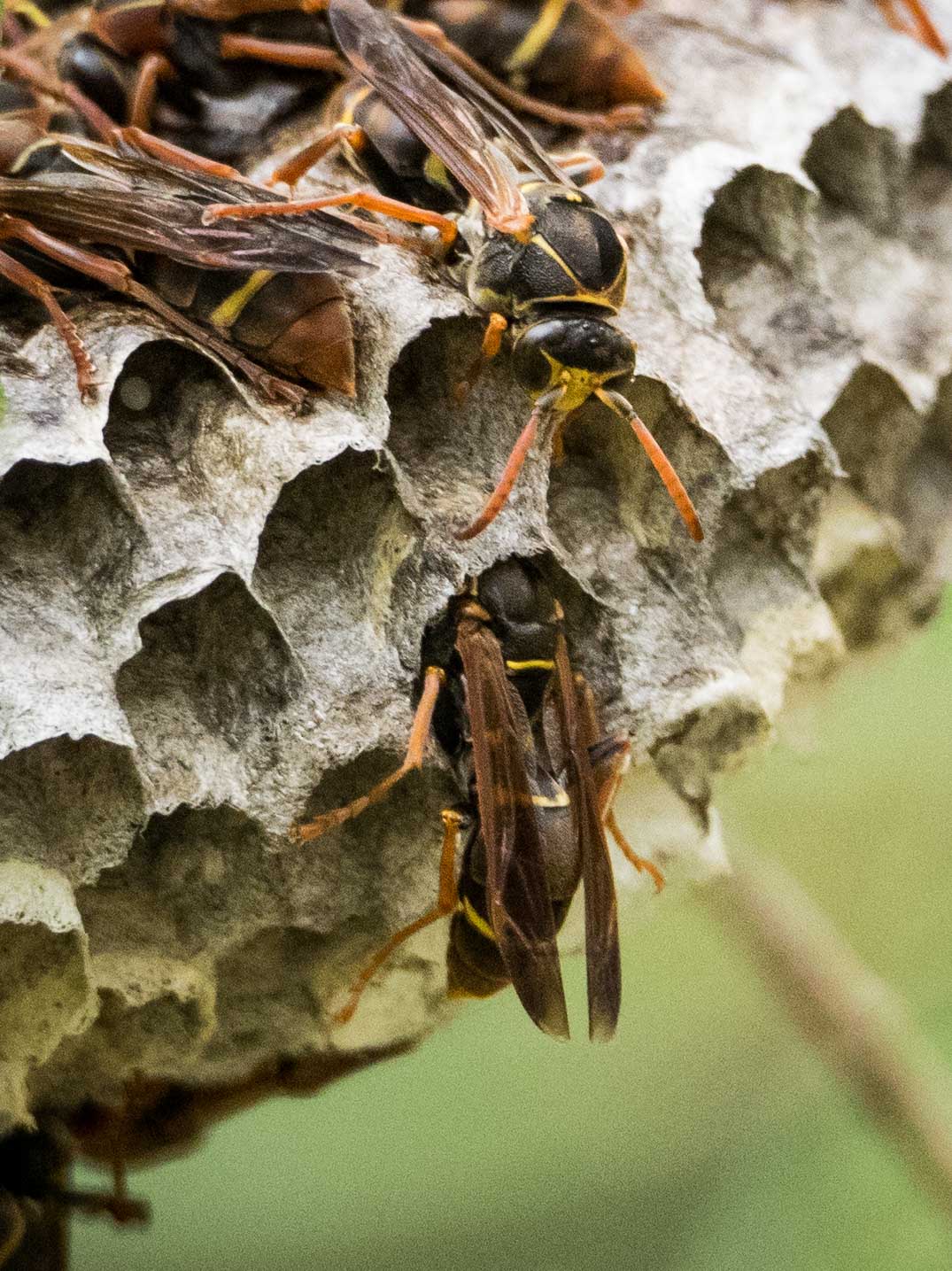
Common Paper Wasp
Polistes humilis
Polistes regurgitate collected food and feed it to their growing larvae. The nest cells are open, and a (careful!) close look inside reveals the growing young - fat, white 'grubs'. When they are fully developed, the cells are capped. The next generation of flying wasps then contribute to the colony as workers.
Order: Hymenoptera; Family: Vespidae (vespid wasps)
Photo taken in February
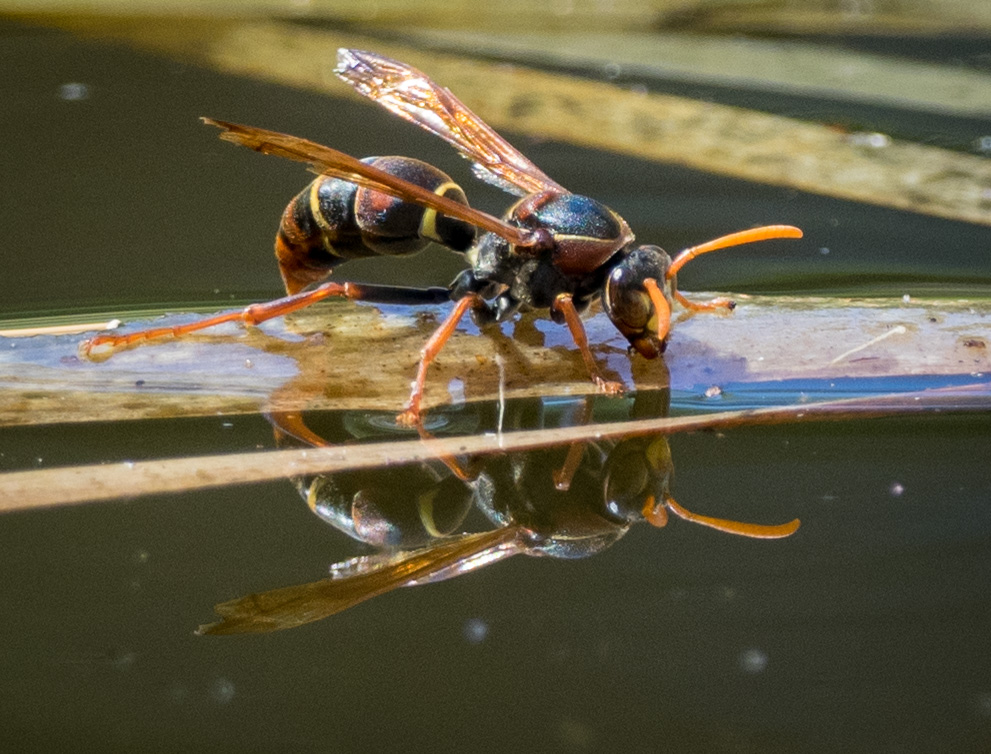
Common Paper Wasp
Polistes humilis
When it comes to stinging insects, Paper Wasps have a rather fearsome reputation. We were warned by several people that we should remove the nests they were building, particularly from anywhere in the vicinity of the house. However, they have not been a problem at all. I gather people generally get bitten when they do try to remove them! Left alone, the wasps seem to keep to themselves and apparently are efficient caterpillar hunters - very welcome when they build near to the vegetable garden!
During hot and dry weather, it is common to see large numbers of wasps and bees of various species drinking from every available water source.
Order: Hymenoptera; Family: Vespidae (vespid wasps)
Photo taken in March
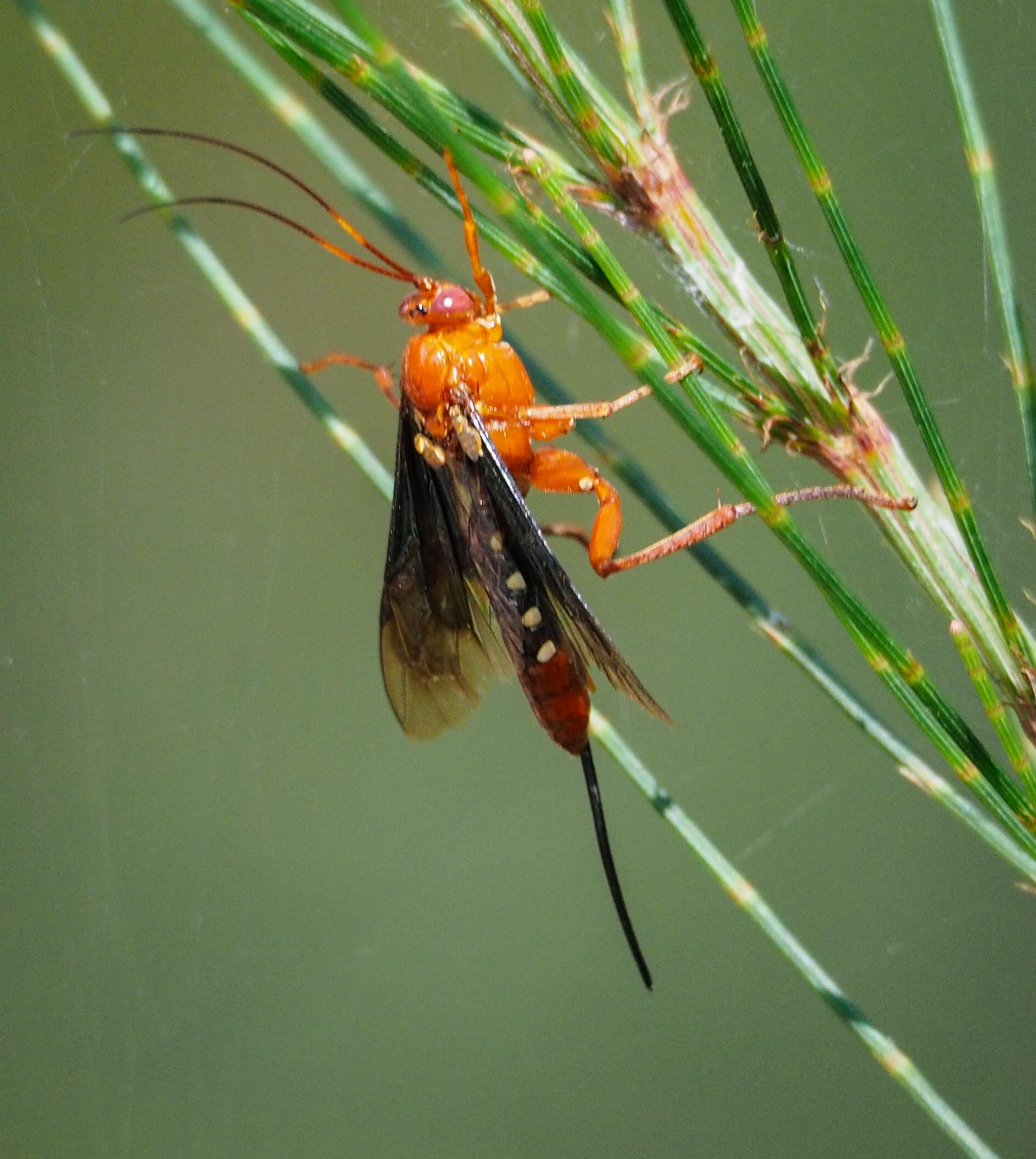
Dusky-winged Ichneumonid
Lissopimpla excelsa (?)
This is one of several, beautiful 'ichneumonid' wasp species we have sighted here in the forest. They typically appear to be searching, antennae flicking, as they rapidly walk over foliage. They are rarely large insects, always with long antennae.
The ichneumonid wasps belong to the the largest of all the hymenopteran families ... there are 24,000 described species, worldwide! Most are parasitoids, the larva developing within the body of a living, insect host and eventually killing the host. The long 'stinger' is used to pierce the host and lay the egg. The host is often a caterpillar (Lepidoptera) or beetle grub (Coleoptera).
Also called an 'orchid-dupe wasp', Lissopimpla males are reported to pollinate a number of orchid species, fooled by the flower which resembles a female wasp - at least to the male, anyway.
Order: Hymenoptera; Family: Ichneumonidae (ichneumonid wasps)
Photo taken in December
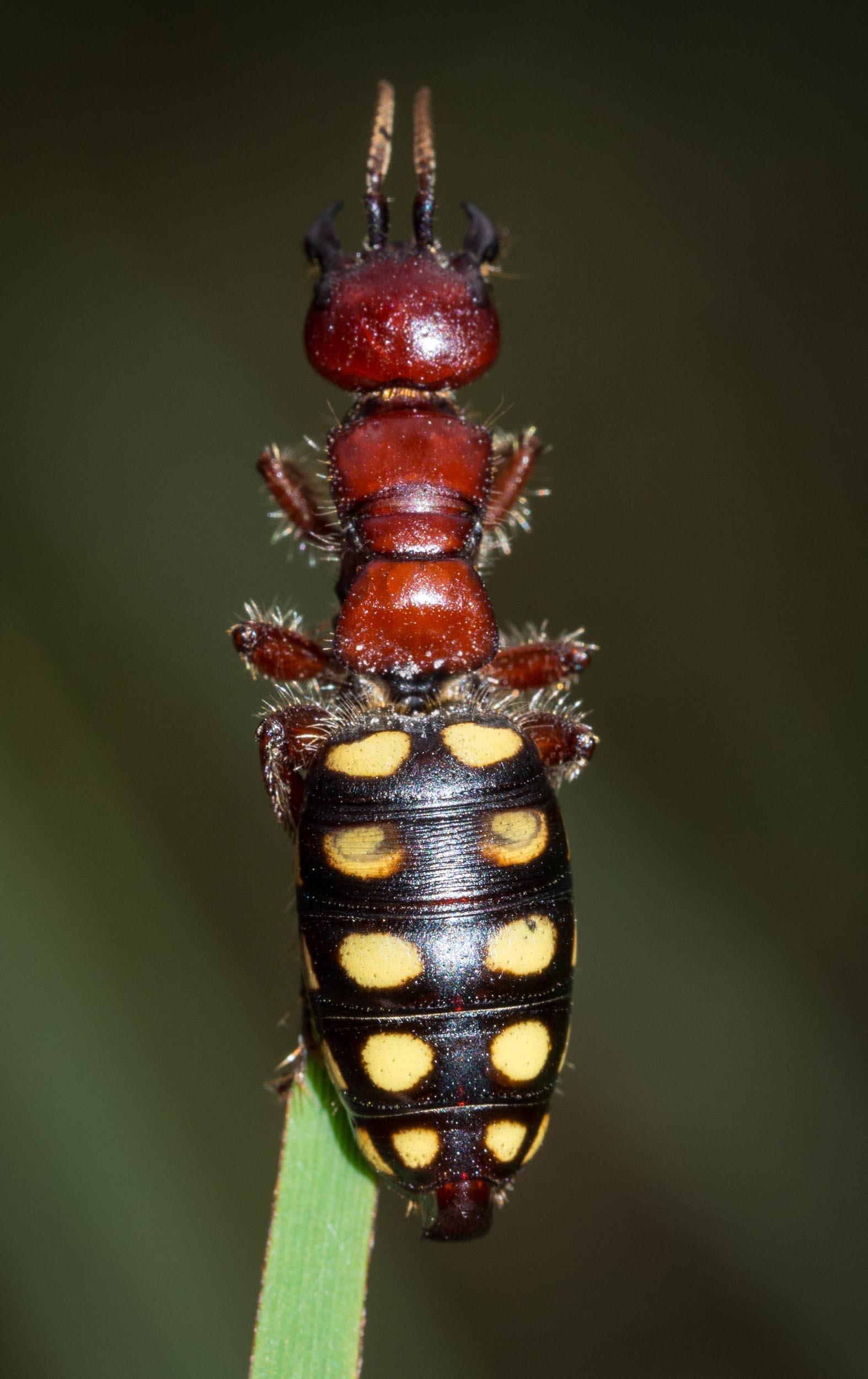
Native Flower Wasp (female)
Thynnus zonatus
Like Ichneumonid Wasps, Thynnus zonatus is a parasitoid. Species in this group target beetle larvae as hosts for their own larvae. Many species in the family Thynnidae, including Thynnus zonatus, have wingless females.
I discovered this female sitting at the top of an upright Patersonia leaf, about 300mm above the ground. She was quite motionless but dropped to the ground when disturbed. The following day she was back in place, in exactly the same spot!
According to the literature, such females release pheromones to attract flying males. After mating, the female drops to the ground and goes in search of Scarabaediae larvae on which to lay her eggs.
Order: Hymenoptera; Family: Tiphiidae (tiphid wasps. flower wasps)
Photo taken January
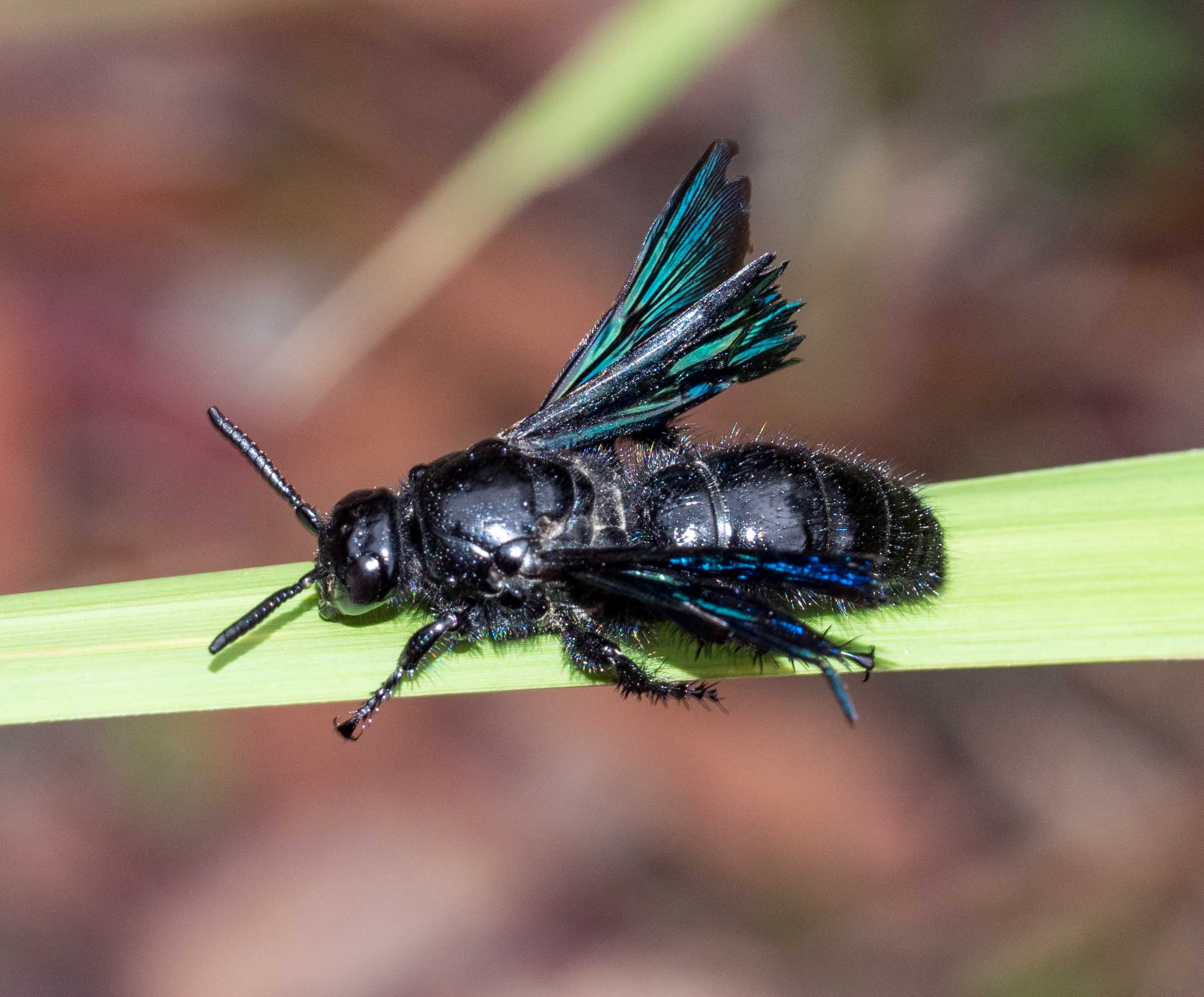
Hairy Flower Wasp
Austroscolia soror
This massive, blue-black wasp caught our attention as it rested on a Gahnia leaf. This was an unusual sighting for us. Since then we have seen the species only a couple of times, and always in late Summer.
As the name suggests, these solitary wasps feed on nectar from flowers such as tea-trees (Leptospermum spp.). Like Thynnus zonatus, their larvae are parasitoids of scarab beetle larvae.
The rather tattered-looking wings in this Austroscolia are not tattered at all - this is their normal shape!
Order: Hymenoptera; Family: Scoliidae (scoliid wasps)
Photo taken in February
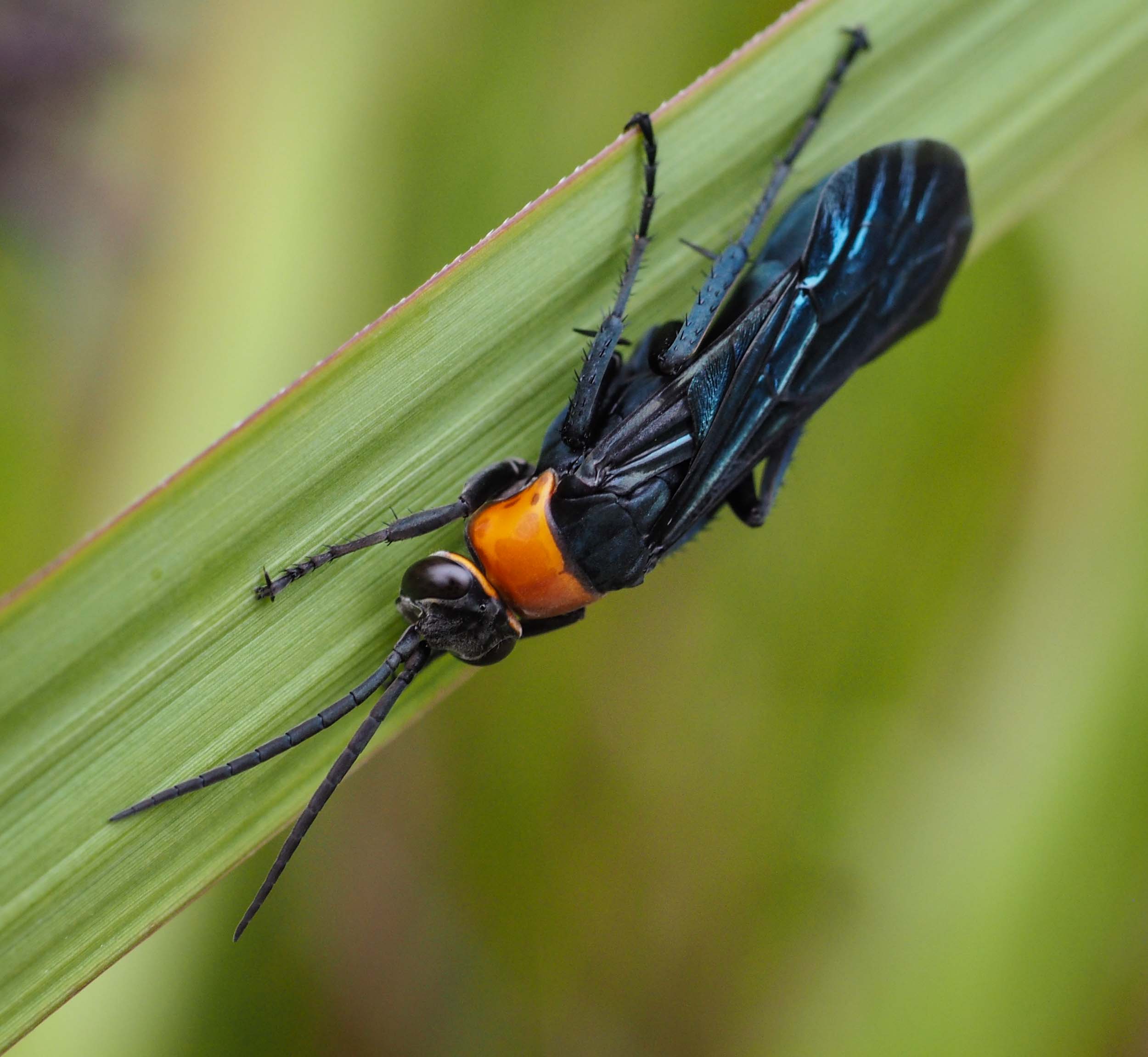
Orange-collared Spider Wasp
Ferreola handschini
A common strategy among wasps is to lock a large, paralysed prey animal away in a cell with a single larva and leave the larva to develop in isolation, well-provisioned with 'fresh' food. Spider wasps (family Pompilidae) employ such a strategy.
These large, robust wasps specialise in capturing spiders - sometimes very large spiders! - and have developed potent poisons and strong stings for the purpose. They are solitary wasps and usually have strikingly beautiful, 'warning' colouration.
From mid to late summer we see numerous Pompilidae species hauling stunned spiders. It is no coincidence, I suspect, that the peak breeding activity of spider wasps coincides with the time of the year when spiders are most abundant.
Order: Hymenoptera; Family: Pompilidae (spider wasps)
Photo taken in January
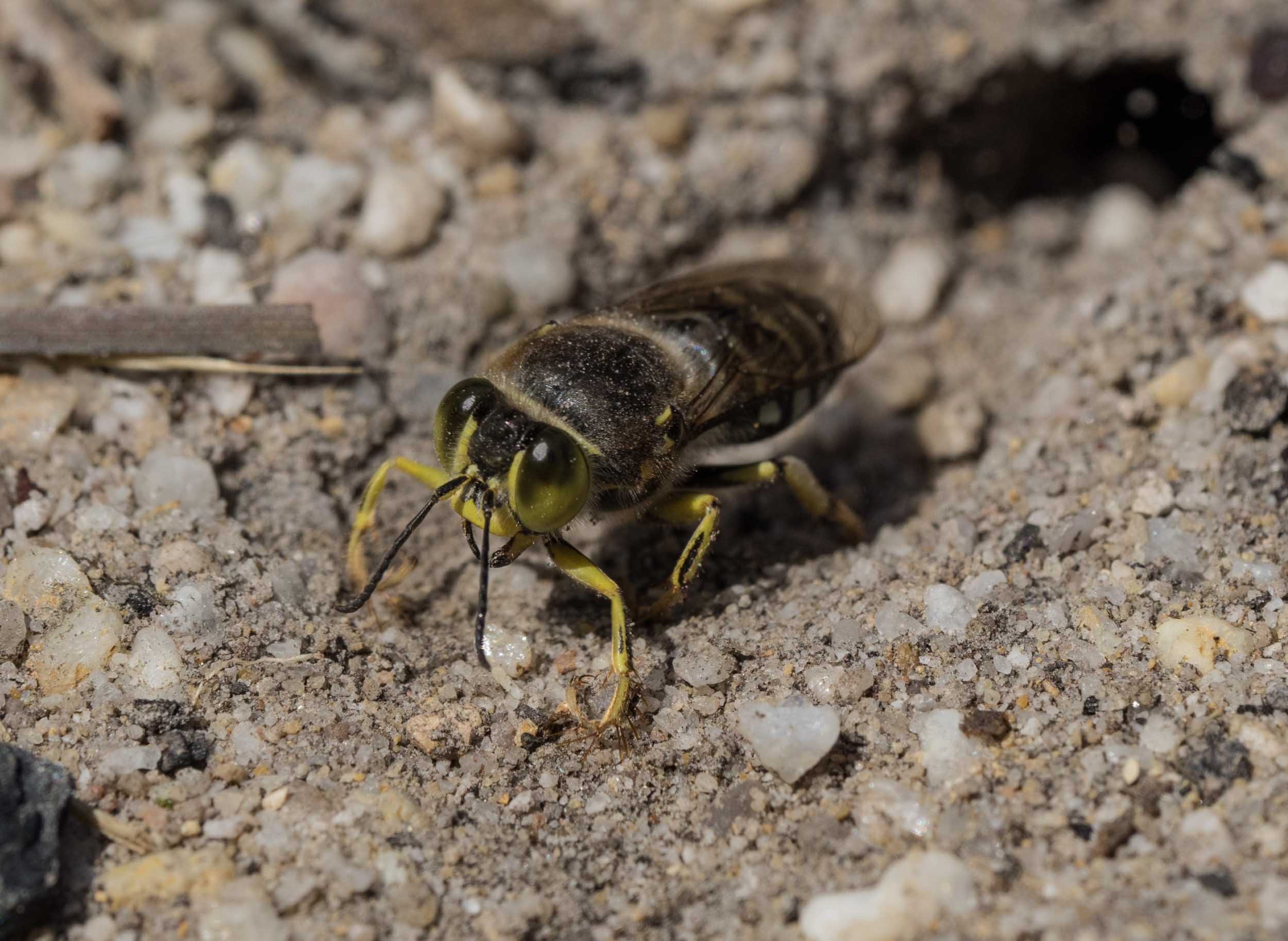
Sand Wasp
Bembix sp.
Bembix are solitary insects - although we never see just one. Throughout Summer, sandy areas of the forest floor are abuzz with these Sand Wasps. They seem to be everywhere, having appeared from nowhere!
In a manner similar to the Spider Wasps, Sand Wasps lay each of their eggs in a separate burrow, provisioned with dead or paralysed insects. Once developed, the larva will pupate in the soil.
We surmise that the species here may overwinter as pupae, emerging as adults in Spring. This could account for the adults' sudden appearance - in large numbers - in November.
Order: Hymenoptera; Family: Crabronidae (sand wasps, mud-daubers)
Photo taken in December
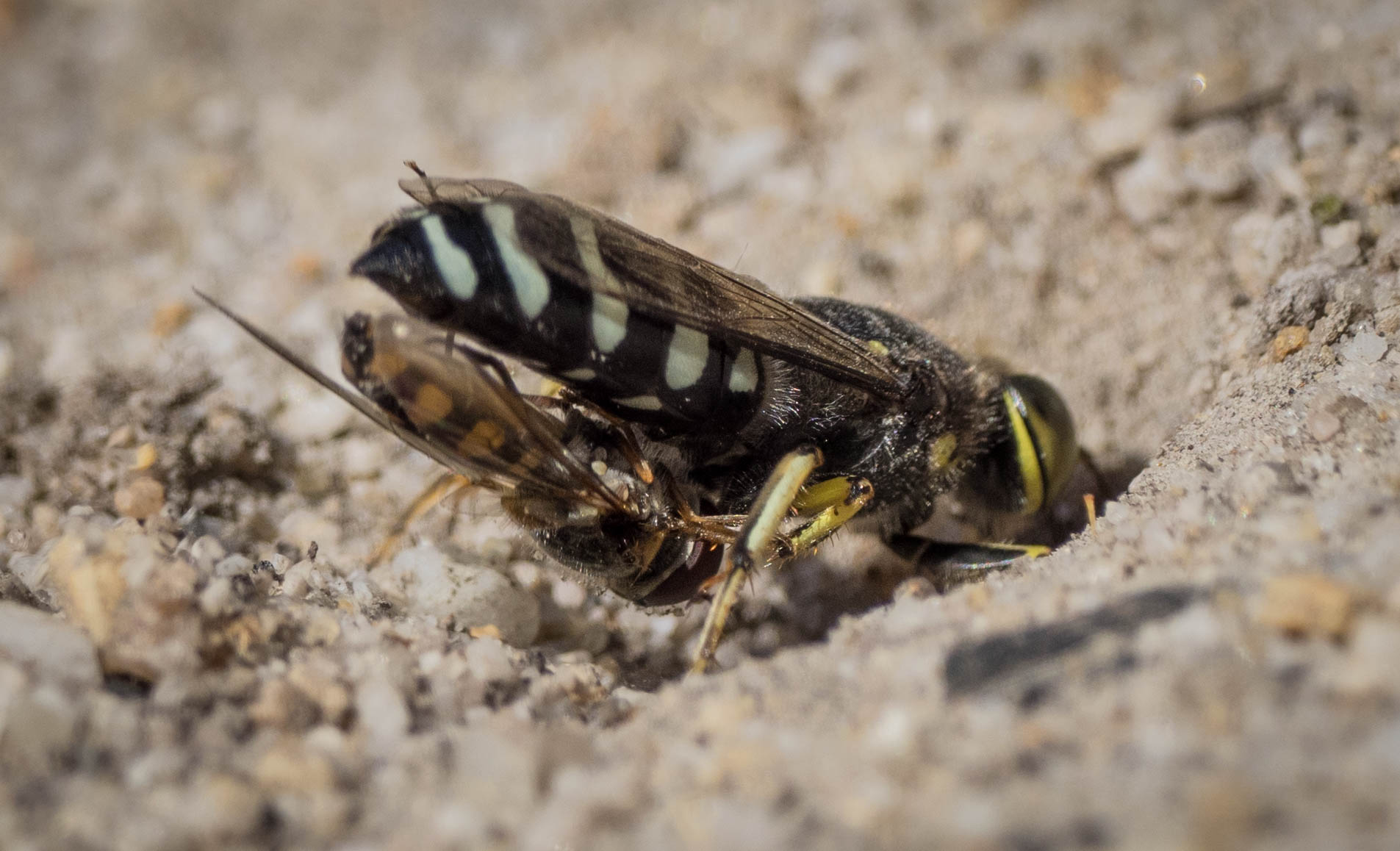
Sand Wasp
Bembix sp.
These medium-sized wasps rapidly excavate short tunnels, departing at intervals and then returning - often clutching a fly. Hover flies seem to be a favoured food here in the forest.
Order: Hymenoptera; Family: Crabronidae (sand wasps, mud-daubers)
Photo taken in December
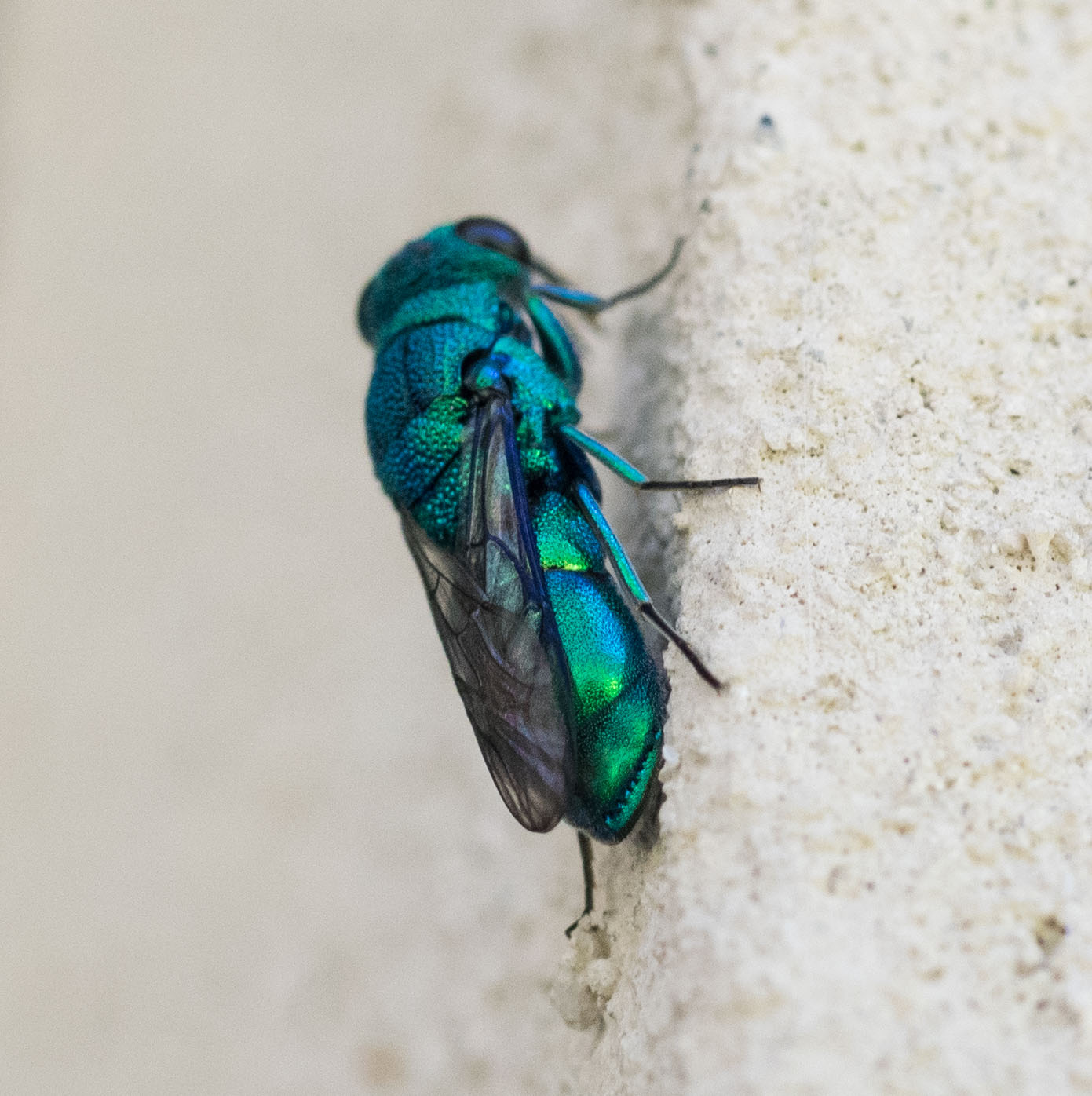
Cuckoo Wasp (female)
Primeuchroeus sp.
Pretty but parasitic! This striking iridescent blue-green wasp uses the same parasitic strategy to rear its young as many other wasps. But in this case the target host is another wasp, rather than a beetle or other insect larva - hence the 'cuckoo' moniker.
Cuckoo Wasps lay their eggs into the nests of social wasps. The cuckoo wasp larvae feed on the larvae of the social wasp or on food that is delivered to the nest by the host workers. Interestingly, we saw the female Cuckoo Wasp in this image resting on the wall of our house, close to a Common Paper Wasp (Polistes humilis) nest. Just an innocent bystander?!!
Order: Hemiptera; Family: Chrysididae (cuckoo or emerald wasps)
Photo taken in February

Nomia Bees
Lipotriches sp.
A slowly writhing mass of bees on a bush or plant stalk is a common sight on a summer evening. The insects crawl over and around one another, rarely flying, eventually settling in for the night. The following morning, as the day starts to warm, they become increasingly active and gradually disperse.
Order: Hymenoptera; Family: Halictidae (sweat bees)
Photo taken in February
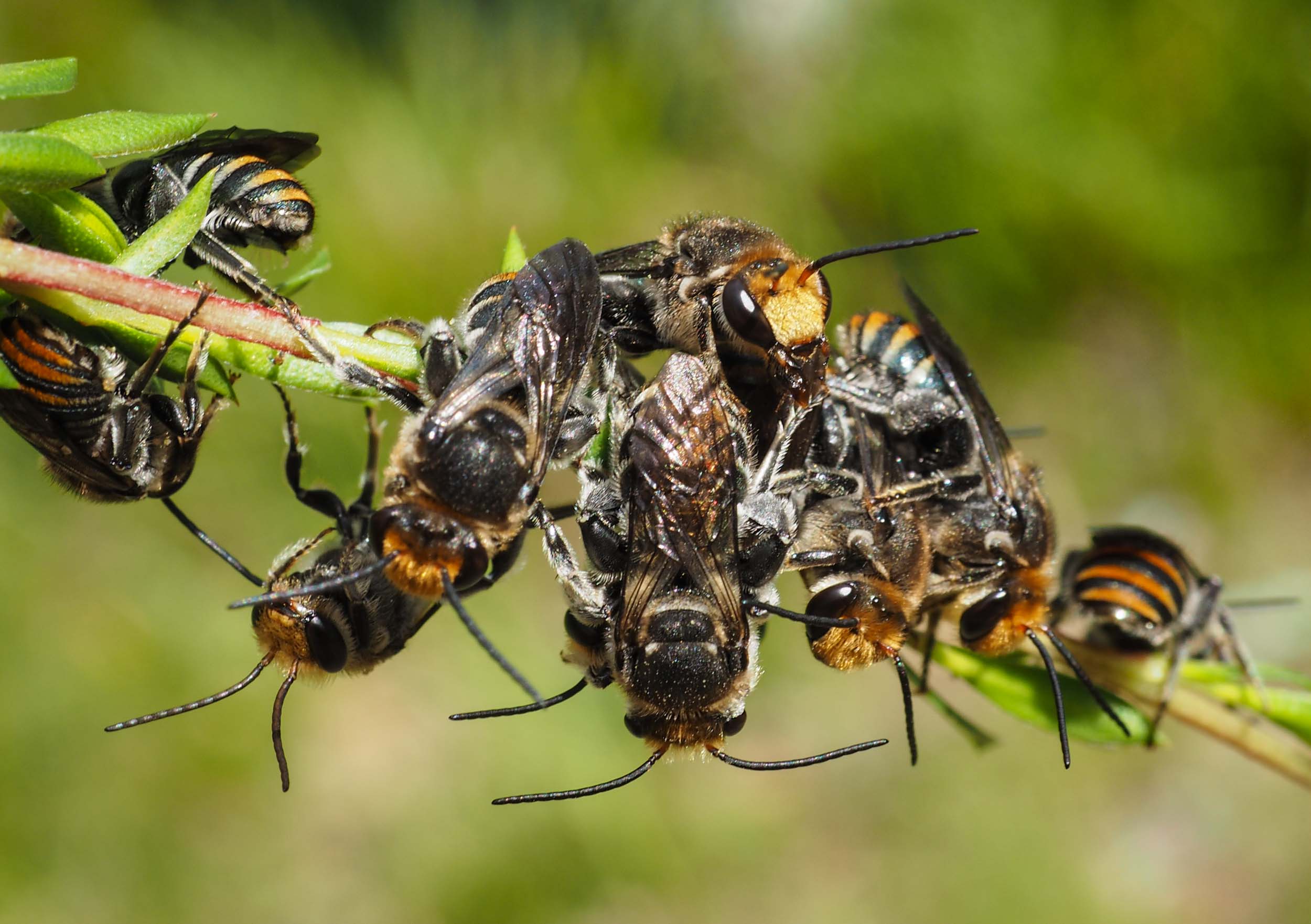
Nomia Bees
Lipotriches sp.
Although we have yet to find an authoritative reference for identification, we think these are Lipotriches, perhaps L. flavoviridis or L. australica. The genus belongs to a group of bees called Nomia Bees. The males are reported to congregate overnight, as we have seen, although the reasons for these gatherings are not clear.
Order: Hymenoptera; Family: Halictidae (sweat bees)
Photo taken in January
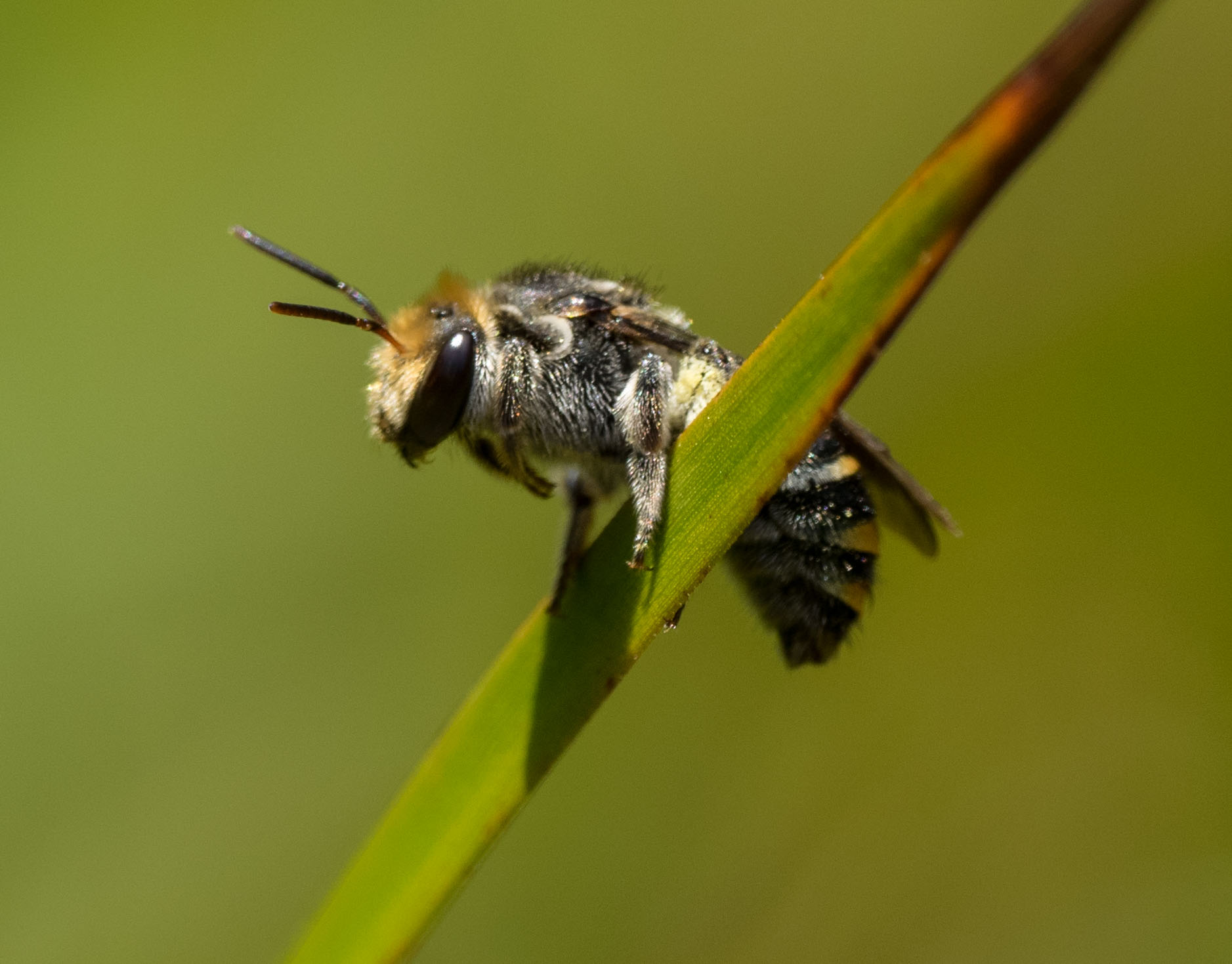
Nomia bees
Lipotriches sp.
Nomia Bees are not a social bee in the sense that they do not form a breeding colony with worker castes. Very few native bee species do. Females dig a burrow and in each 'cell' off the burrow they deposit an egg on top of a ball of pollen. They are recognised as important pollinators.
Order: Hymenoptera; Family: Halictidae (sweat bees)
Photo taken in February
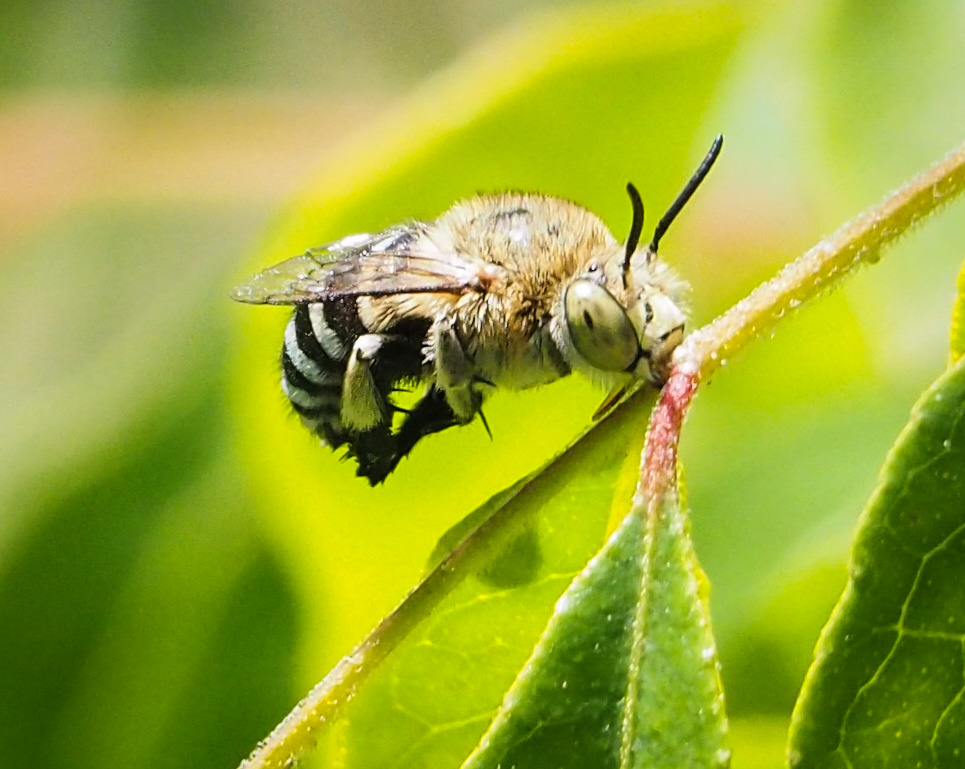
Blue-banded Bee
Amegilla sp. (probably Amegilla asserta)
Blue-banded Bees are one of the better known native bees. They are quite large and attractive, and frequently pollinate gardens.
They are also well known for their habit of resting by clasping a plant stem with their mouthparts, as this male is doing here - affording a rare opportunity for a decent photograph. They are more typically on the move and quite a challenge! We see them here in Summer, their distinctive buzzing alerting us to their presence as they visit flowering plants - including in the vegetable garden.
Order: Hymenoptera; Family: Apidae (social bees)
Photo taken in December
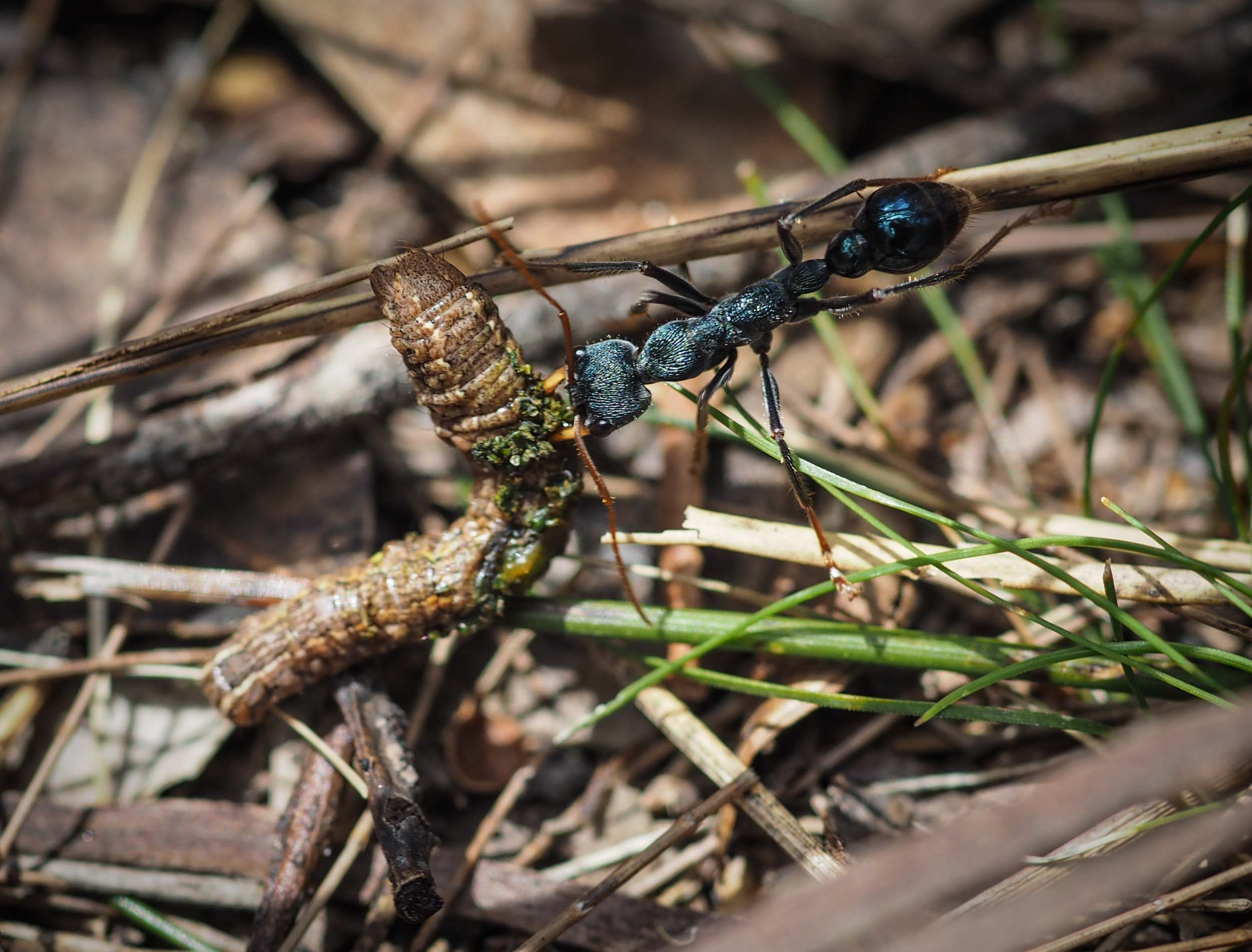
Black Bull Ant
Myrmecia tarsata
The Black Bull Ant is common here in the forest. It is one of ten ant species we have identified on the block to date - although we have yet to really survey the ants in earnest.
We typically see Myrmecia tarsata actively hunting prey - such as this caterpillar - from October, and throughout the Summer months. For a bull ant, Myrmecia tarsata is of medium size - about 22mm long.
Order: Hymenoptera; Family: Formicidae (ants); Subfamily: Myrmeciinae
Photo taken in October

Black Bull Ant
Myrmecia tarsata
'Bull Ants' belong to the genus Myrmecia. There are more than 90 species and they are only found in Australia (plus one species in New Caledonia). Their stronghold is in the south east of the country - in other words, here!
Myrmecia are rather famous for their painful stings and aggressive nature. So far we have recognised three species of Myrmecia in our local forest: M. tarsata, M. simillima, and M. chrysogaster.
We are perhaps fortunate that we do not seem to have the VERY famous Myrmecia pilosula.... - the Jumping Jack Ant. Our local species are fine - they are not overly aggressive and we've not been stung for years - but living with M.pilosula might be a different story.
Order: Hymenoptera; Family: Formicidae (ants); Subfamily: Myrmeciinae
Photo taken in October
Click here to read 'Australia's stinging insects, an interesting 2016 'Conversation' article by David Yeates, CSIRO.
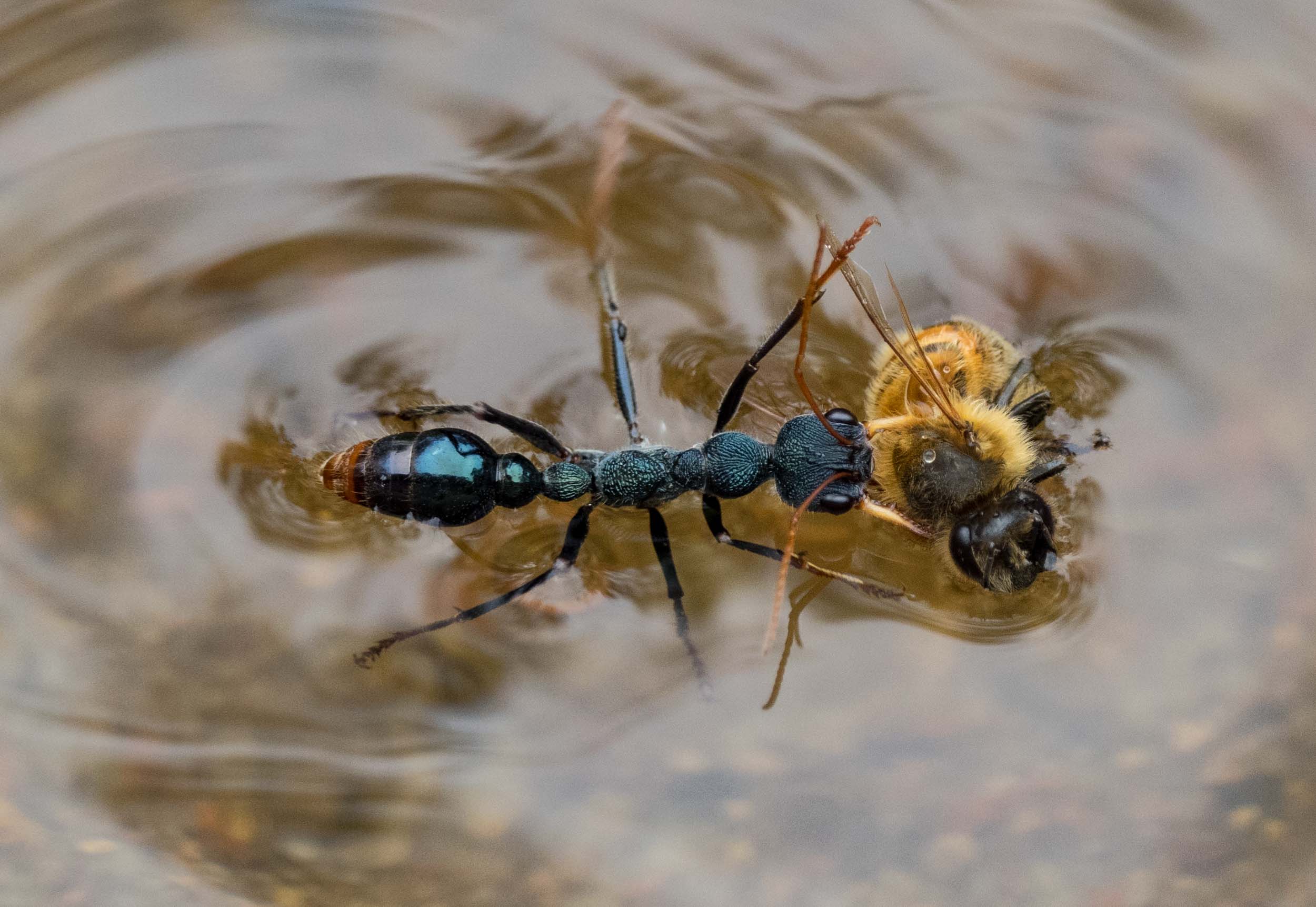
Black Bull Ant
Myrmecia tarsata
Bull Ants swim!
One Summer morning I spotted this Black Bull Ant with a honey bee, struggling on the surface on the frog pond. To rescue it from 'drowning' I used a stick to lift it from the water, to the safety of the shore. To my great surprise the ant turned a circle, appearing to orient itself, secured his load of dead bee, and then purposefully stepped straight back into the water. I looked on as it swam very deliberately across the pond to the other side - where it was no doubt heading in the first place! On reaching the far shore, the ant reversed out, dragging the bee up and over the rocks, then off through the grasses. Lesson for me: best not to interfere with nature.
Order: Hymenoptera; Family: Formicidae (ants); Subfamily: Myrmeciinae
Photo taken in December

Australian Red Bull Ant
Myrmecia simillima
This is the largest of the Myrmecia species we have on site.
These ants immediately adopt an aggressive posture if disturbed, but we are rarely stung, perhaps because they are so easy to spot. They're big .... close to 25mm .... shiny, and when they turn to look at you they display their very menacing jaws.
Order: Hymenoptera; Family: Formicidae (ants); Subfamily: Myrmeciinae
Photo taken in March
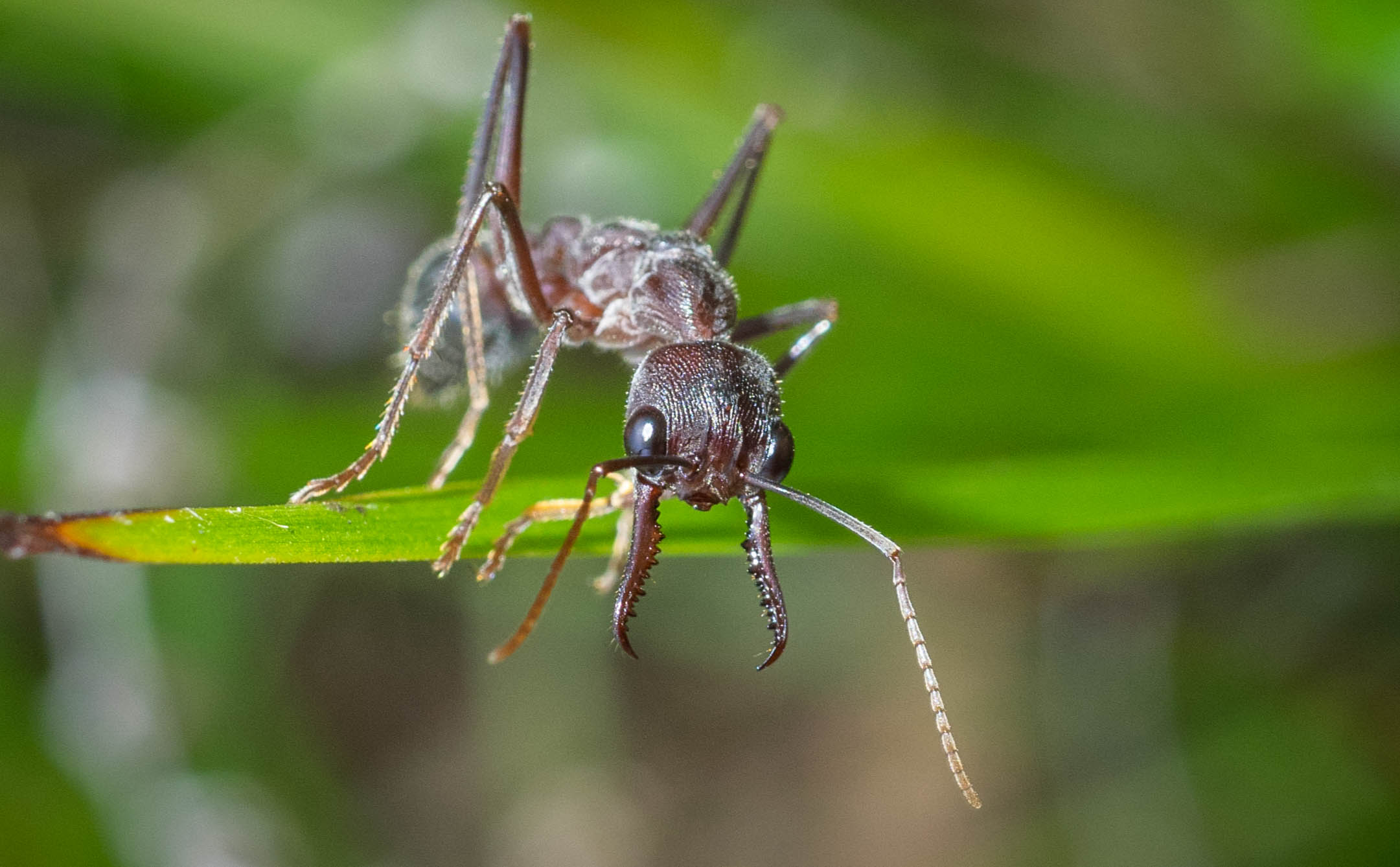
Australian Red Bull Ant
Myrmecia simillima
Bull ants can move quickly and therefore can be tricky to photograph. Here I was lucky. The ant was atop a sedge leaf, with nowhere to go.
The colour, sculptured ridges, and the 'teeth' along the jaws are all useful in confirming the species identification.
Order: Hymenoptera; Family: Formicidae (ants); Subfamily: Myrmeciinae
Photo taken in March

Australian Red Bull Ant
Myrmecia simillima
The other opportunity for a close look at this ant is when one of them is busy hauling prey.
These ants are strong and persistent. The terrain that they work in - the forest floor - is full of obstacles, and their prey is often large and awkward. The ants usually walk backwards when carrying a load, feeling their way with their hind legs.
Order: Hymenoptera; Family: Formicidae (ants); Subfamily: Myrmeciinae
Photo taken in October

Spiny Dolly Ant vs Black Tyrant Ant
Dolichoderus doriae (left), Iridiomyrmex rufoniger (right)
The 'Dolly Ants' are an intriguing group. In warm weather they may be seen forming a seething ball among the grasses, sometimes up to 200mm in diameter. This 'ball' persists for days. It is the entire ant colony, shifting the larvae from underground to the surface, for added warmth.
The tiny ant in this photograph is probably the most numerous ant species in the forest. Iridiomyrmex species are known to have huge colonies and to establish and defend large territories. It is this genus that tends Jalmenus evagorus butterfly larvae.
The interaction in the photo was most likely a territorial battle. We witnessed several Iridiomyrmex tugging at this single 'Dolly's' legs and antennae, generally immobilising it.
Dolichoderus and Iridiomyrmex both belong to the same ant subfamily, and both are generalist feeders and scavengers. They lack stings but can release strong-smelling defensive chemicals when disturbed.
Order: Hymenoptera; Family: Formicidae (ants); Subfamily: Dolichoderinae
Photo taken in April
Click to see our blog in News & Stories for further insight into the relationship between Iridiomyrmex and Jalmenus butterflies.

Red-headed Spider Ant
Leptomyrmex erythrocephalus
These distinctive scavengers are usually seen singly, and typically hauling a dead insect. They live as colonies in the soil and will, at need, recruit other members to help with food retrieval. We see them most months of the year.
The raised 'gaster' - end of the abdomen - and the long legs can give the impression of a spider. This stance is used as a defence posture, suggesting that potential predators may see the same resemblance that we do.
Leptomyrmex belong to the same family as Iridiomyrmex and Dolichoderus - they are stingless.
Order: Hymenoptera; Family: Formicidae (ants); Subfamily: Dolichoderinae
Photo taken in April
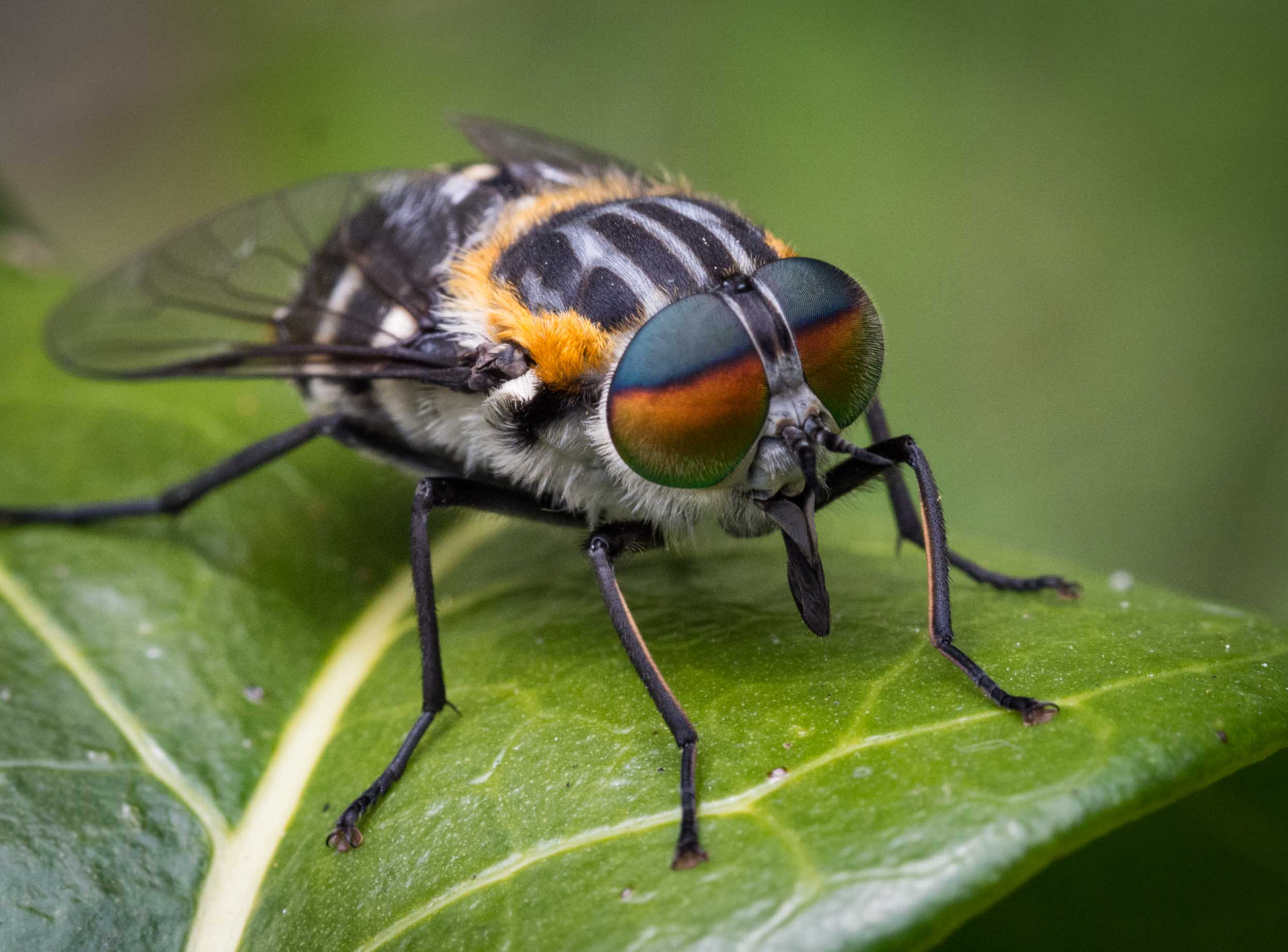
Flower-feeding March Fly
Scaptia auriflua
This fly belongs to the family Tabanidae, known in Australia as March Flies. March Flies are widely disliked because of their biting habit. In fact, only the females bite - the blood they extract is necessary for egg production. The males on the other hand feed exclusively on pollen and nectar.
In the attractive species shown here, Scaptia auriflua, both sexes are nectar feeders. So no need to be alarmed if you're approached by a March Fly with colourful eyes!
Order: Diptera; Family Tabanidae (March flies, horse flies)
Photo taken in October

Yellow-shouldered Hover Fly
Simosyrphus grandicornis
Hover Flies are one of the most important pollinators here in the forest. We see them in large numbers, hovering near and taking nectar and pollen from flowers of a wide range of plant species.
Hover Flies play another important ecological role - their larvae feed on aphids.
Order: Diptera; Family: Syrphidae (hoverflies)
Photo taken in November

Black & Grey Bee Fly
Meomyia sericans
The high-pitched buzzing of these attractive flies is a common sound in summer, particularly in areas of exposed, sandy soil. They often hover in place, motionless except for the blur of their wings.
We see them land on the sand and appear to burrow. It is likely that they are able to locate buried larvae, such as Sand Wasp larvae, and then lay an egg in the burrow of this would-be host. Reportedly, these flies are quite opportunistic in their choice of larval host.
The adults feed on nectar and may be important pollinators.
Order: Diptera; Family: Bombyliidae (bee flies)
Photo taken in October

Aleucosia bee fly
Aleucosia sp.
The dark patterning on the outstretched wings of Aleucosia is like a work of art. These conspicuous insects appear in small numbers in Spring, and are often in mated pairs when we see them.
Like many insects, this coupled state lasts an extended time, presumably ensuring that the female remains unavailable to other males. If disturbed, they will fly a short distance and land, still coupled.
Order: Diptera; Family: Bombyliidae (bee flies)
Photo taken in October
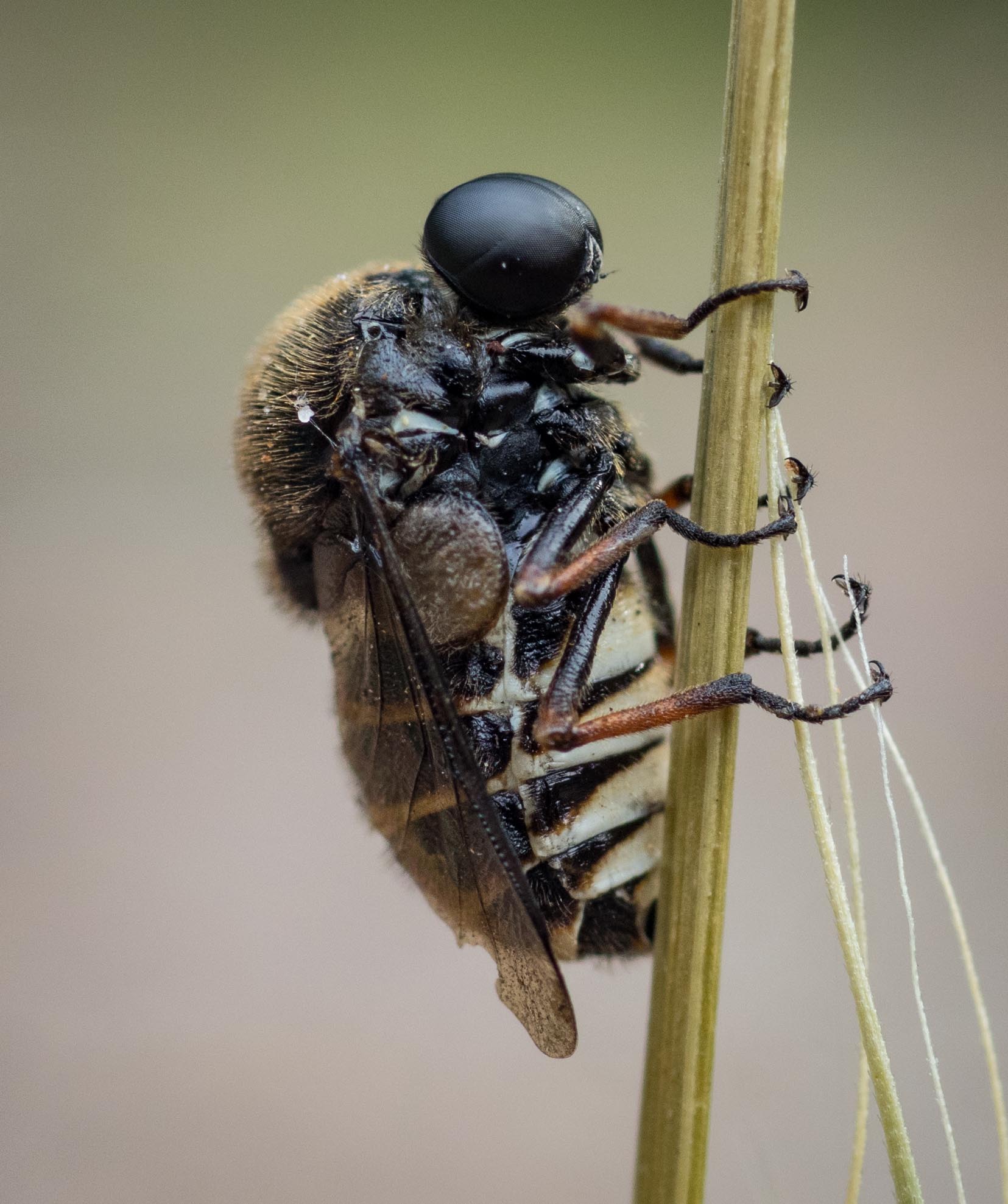
Small-headed Fly
Ogcodes basalis
When I first noticed this insect clinging to a grass stem I thought something had eaten its head! These bizarre looking flies have grossly inflated bodies and small heads. Adding to their weird appearance is the fact that their eyes are fused together along the midline.
Flies in this family are apparently quite rare and their biology not well understood. They may be parasitoids of spiders.
Order: Diptera; Family: Acroceridae (small-headed flies)
Photo taken in November

Crane Fly
Leptotarsus clavatus
So far we have seen recognised six distinct species of crane flies on the block, but there are doubtless more than that. We almost always see them on casuarina - either resting or mating.
Female crane flies mate almost immediately after they emerge from their pupal case. They lay their eggs in moist soil or in decaying wood. The larvae play an important role in the forest ecosystem, breaking down organic material and returning it to the carbon cycle. The adults don't do much except rest and mate. They drink water but don't feed at all.
Order: Diptera; Family: Tipulidae (crane flies)
Photo taken in January

Crane Flies
Leptotarsus tortilis
The reason we so often see Crane Flies on casuarina, as here, may have less to do with the casuarina (although it does seem to afford good 'foot-holds') than with the fact that there is a pile of old, decaying wood and bark nearby. It is possible that the adults we are seeing have recently emerged from larvae in that wood.
Order: Diptera; Family: Tipulidae (crane flies)
Photo taken in November

Robber Fly
Colepia sp.1
Robber Flies are generally large flies and are active predators, eating a wide range of other arthropods, such as beetles, flies, dragonflies, moths, spiders and bees. We have seen at least eight distinct species on the block to date but, as with the crane flies, that number will no doubt grow when we make a more systematic survey.
Robber flies take their prey in flight, pierce a soft part of the body with their sharp proboscis, and inject it with saliva containing neurotoxins and digestive enzymes.
Order: Diptera; Family: Asilidae (robber flies)
Photo taken in February
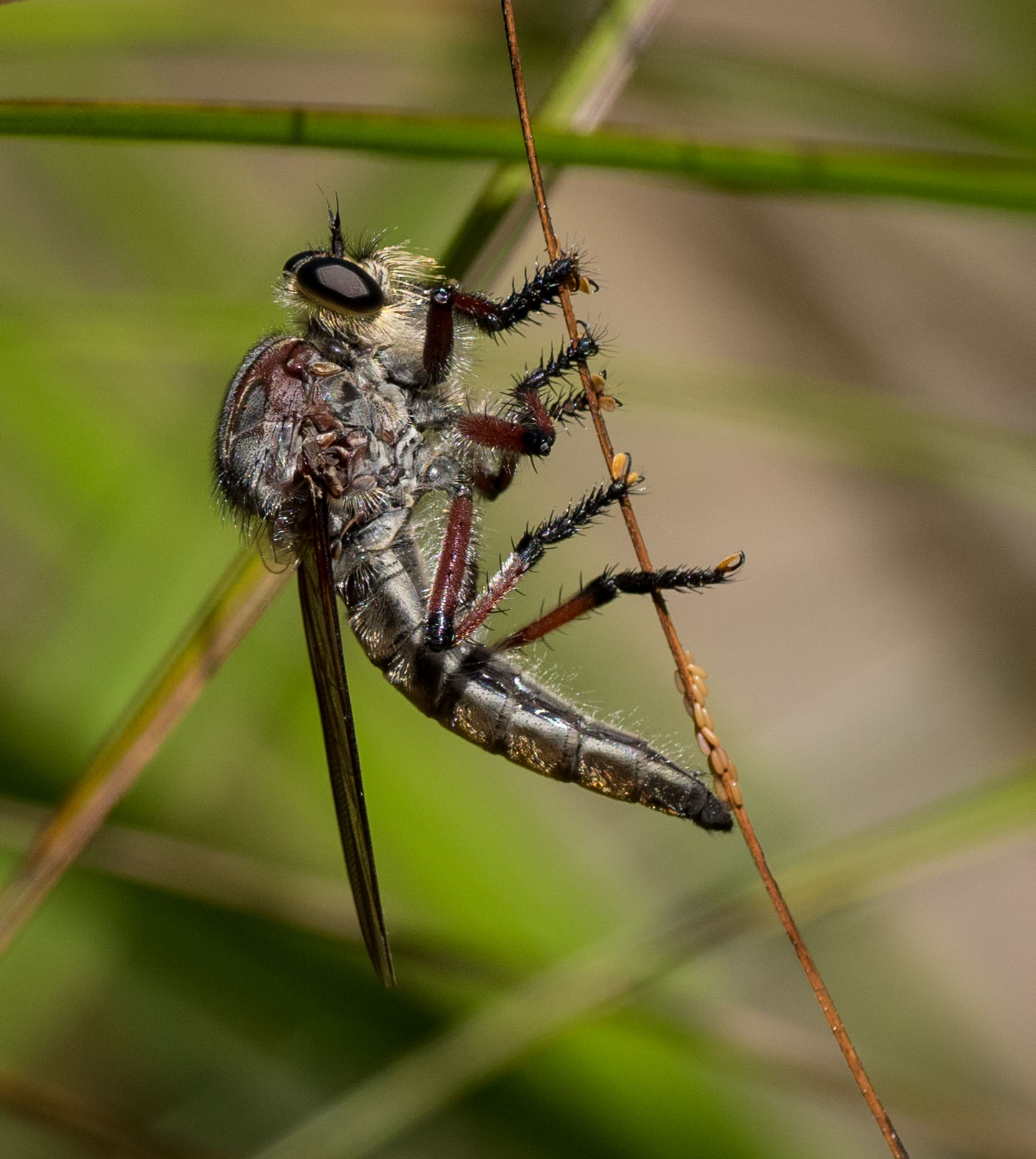
Robber Fly
Colepia sp.2
This was the first time I'd come across an ovipositing Robber Fly. Normally we see these large predators either on the hunt or feasting on their catch. Instead, this female was slowly stepping her way backwards down a plant stem, gluing down a neat, tightly packed row of brown eggs as she went.
Order: Diptera; Family: Asilidae (robber flies)
Photo taken in January
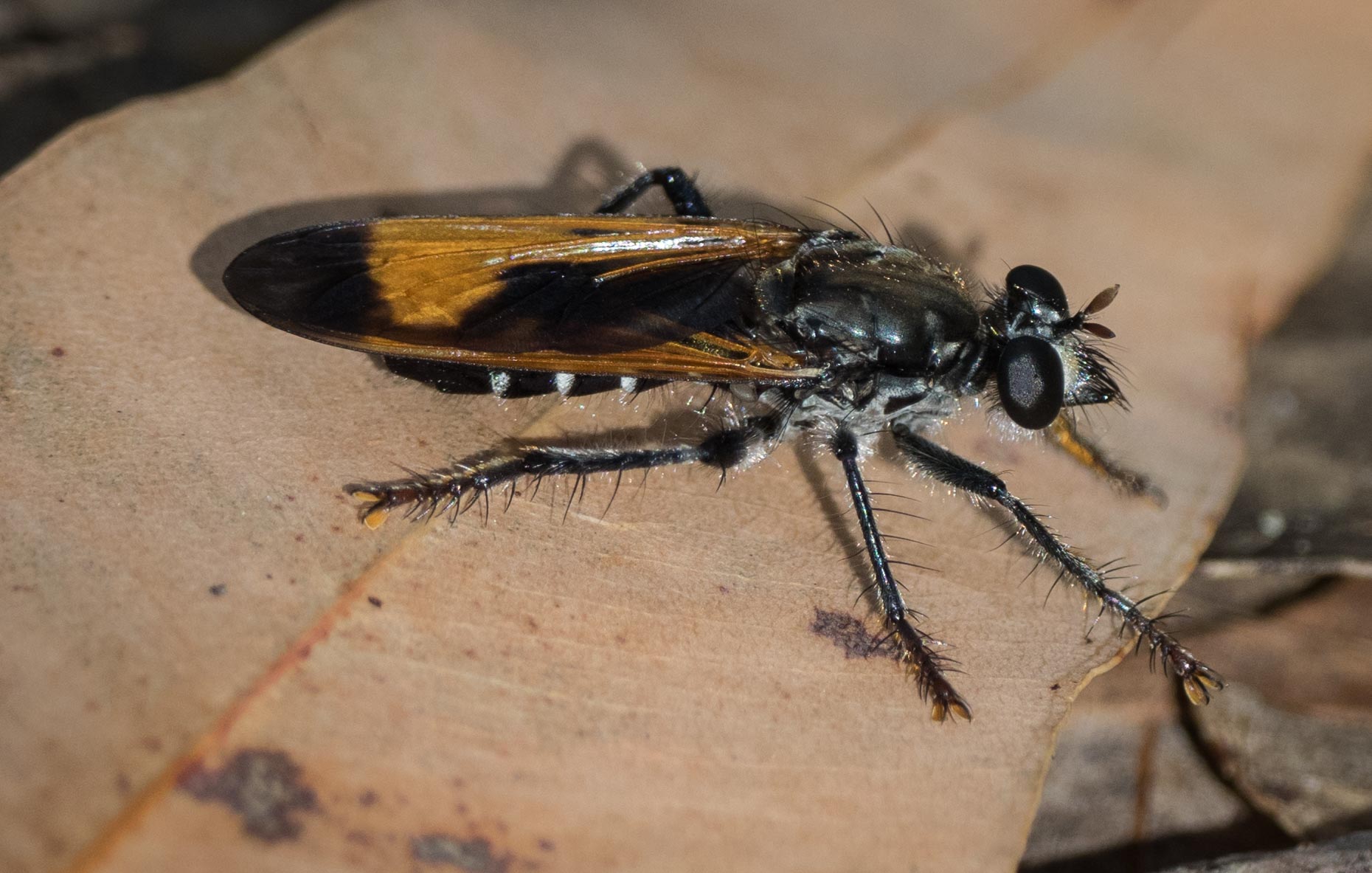
Orthogonis
Orthogonis ornatipennis
These Robber Flies are quite different in appearance from the more 'typical' members of the family Asilidae. We see them here in January-February, often as mating pairs. This is the female - the male has a splendid golden 'moustache'.
Members of the genus are sometimes referred to as 'bee-like robber flies', perhaps due to their colouring.
Order: Diptera; Family: Asilidae (robber flies)
Photo taken in January

Spotted Brown (male)
Heteronympha paradelpha
Perhaps the most conspicuous group of butterflies in the south are the 'browns'. The local forests are potentially home to at least a dozen species of browns, including this Spotted Brown.
Heteronympha paradelpha adults tend to appear here in quite large numbers for a short period - perhaps a week or so - in late Summer. As is the case for most browns, the larvae feed on grasses. Here the grass favoured is one of our common species, Microlaena stipoides.
Order: Lepidoptera; Family: Nymphalidae; Subfamily: Satyrinae (browns)
Photo taken in February
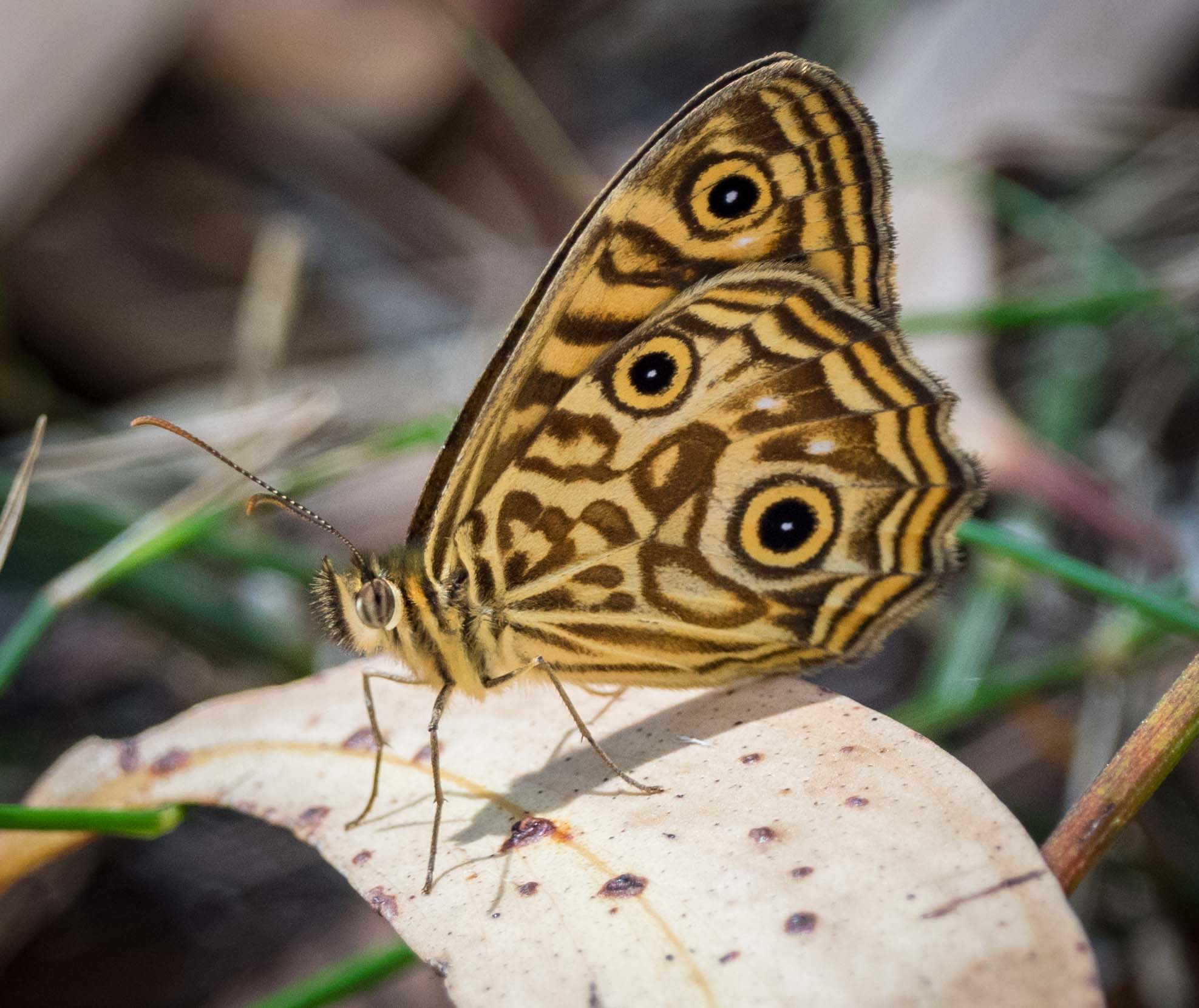
Eastern Ringed Xenica
Geitoneura acantha
The upper wings of nearly all 'browns' are variously orange, brown and black. This can make identification a bit tricky. However, this 'forest brown' is unmistakable when it perches with closed wings - the pattern is striking and unique.
We do not see Geitoneura acantha in large numbers, which is perhaps surprising as one of their favoured food plants - Microlaena stipoides - is a common grass here.
Order: Lepidoptera; Family: Nymphalidae; Subfamily: Satyrinae (browns)
Photo taken in January

Common Ringlet
Hypocysta metirius
Common Ringlets have quite specific areas on the block that they favour and we can reliably find the adults there throughout the Summer. That they are so common here is a little surprising, as we are at the southern extremity of their distribution. Their range extends from the tip of Cape York all the way down the east coast - to us.
They fly low to the ground and land frequently, often with wings open. As with all browns, they are a favoured food of birds and lizards. The eye spots on the hind wings must help avoid attacks to their heads ... but the wings certainly suffer as a result. Most individuals are sporting bite and tear marks to the hindwings.
Order: Lepidoptera; Family: Nymphalidae; Subfamily: Satyrinae (browns)
Photo taken in March

Swordgrass Brown
Tisiphone abeona albifascia
The Swordgrass Brown is quite large and definitely striking, with a slow, lilting flight. We typically see only one or two at any one time.
Tisiphone are unlike most other species of browns, both in their colouration and in their host plants. Their larvae feed on Gahnia species, not grasses. Males patrol these sedges on the lookout for newly-eclosed females. There are five subspecies of Tisiphone aboena, each with a distinct appearance and distribution. The subspecies we see here, T.a.ablifascia, is the most southern and occurs across eastern Victoria.
Order: Lepidoptera; Family: Nymphalidae; Subfamily: Satyrinae (browns)
Photo taken in February
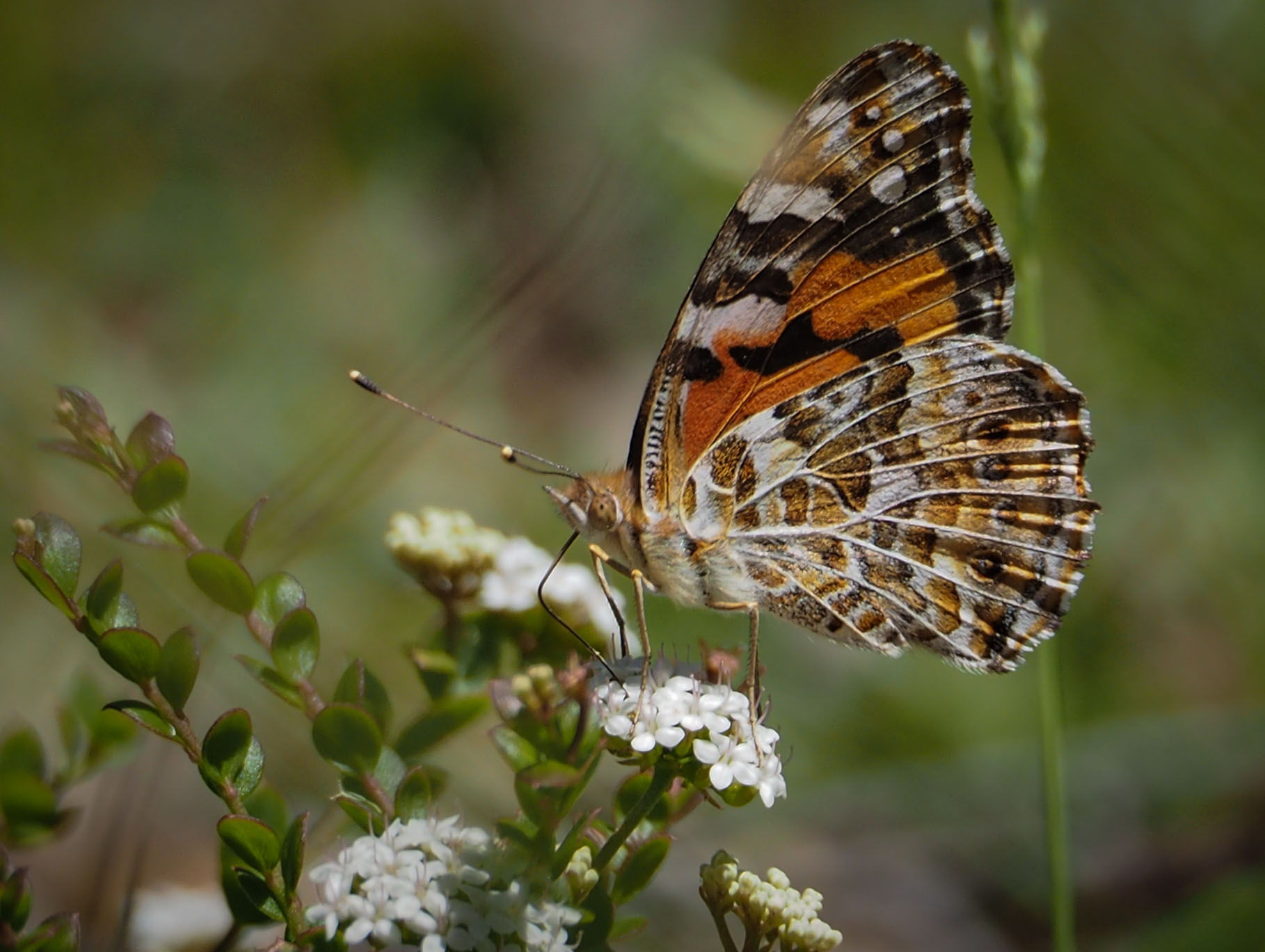
Australian Painted Lady
Vanessa kershawi
The territorial behaviour of males of this species is quite astonishing to witness. It is really not something I expected to see from a butterfly! A male will guard his chosen patch of low-growing forbs and aggressively chase off passing butterflies of any species - except, presumably, receptive females of his own species.
Order: Lepidoptera; Family: Nymphalidae; Subfamily: Nymphalinae (nymphs)
Photo taken in November
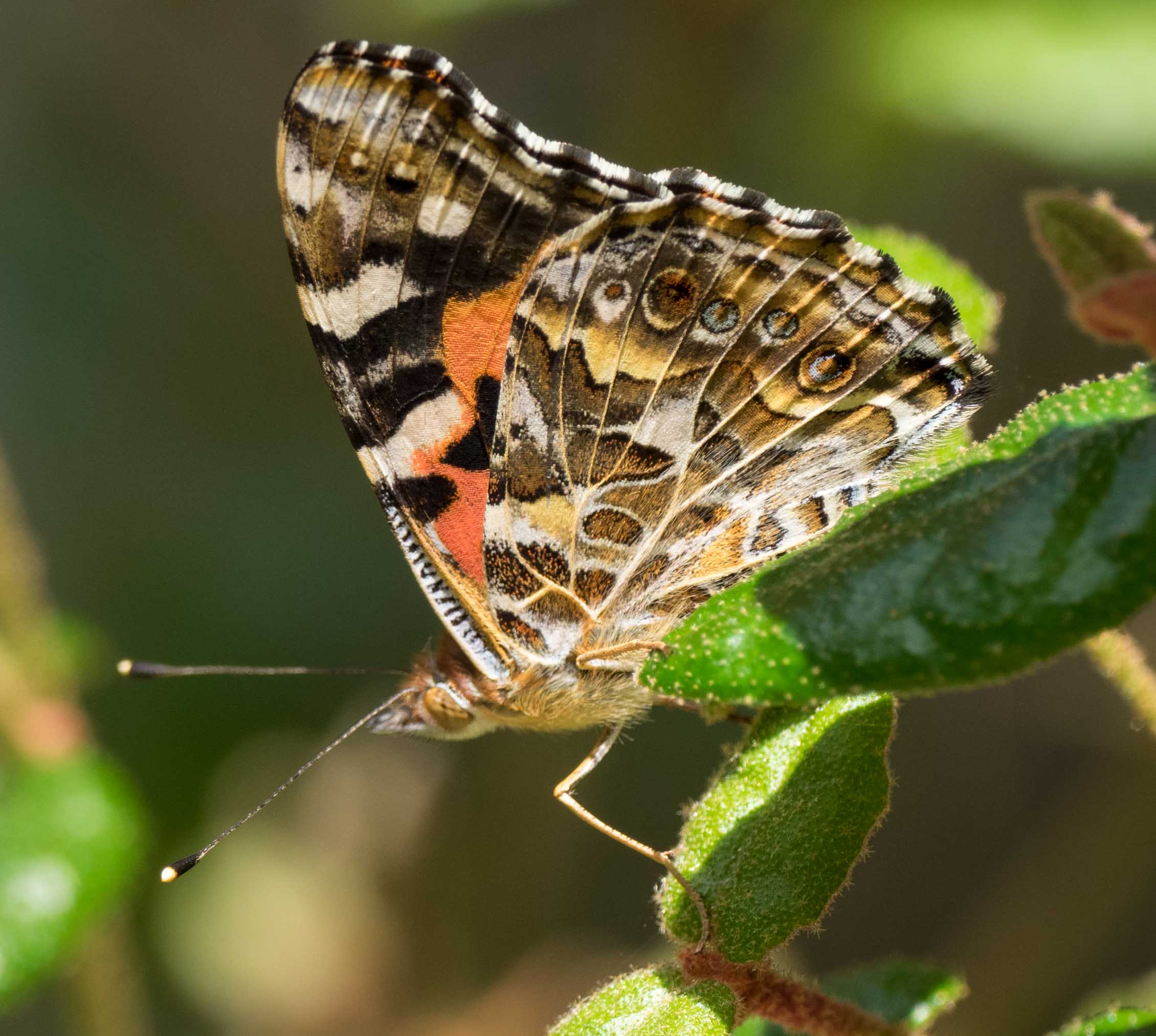
Australian Painted Lady
Vanessa kershawi
For a couple of years, Vanessa kershawi was by far our most numerous and conspicuous butterfly species on the block. The genus is renown for its migrations so, perhaps, in those years we just happened to be included in their flight path. They remain a significant part of the butterfly fauna every summer, but have not been such a dominant one in the past couple of Summers.
Order: Lepidoptera; Family: Nymphalidae; Subfamily: Nymphalinae (nymphs)
Photo taken in November
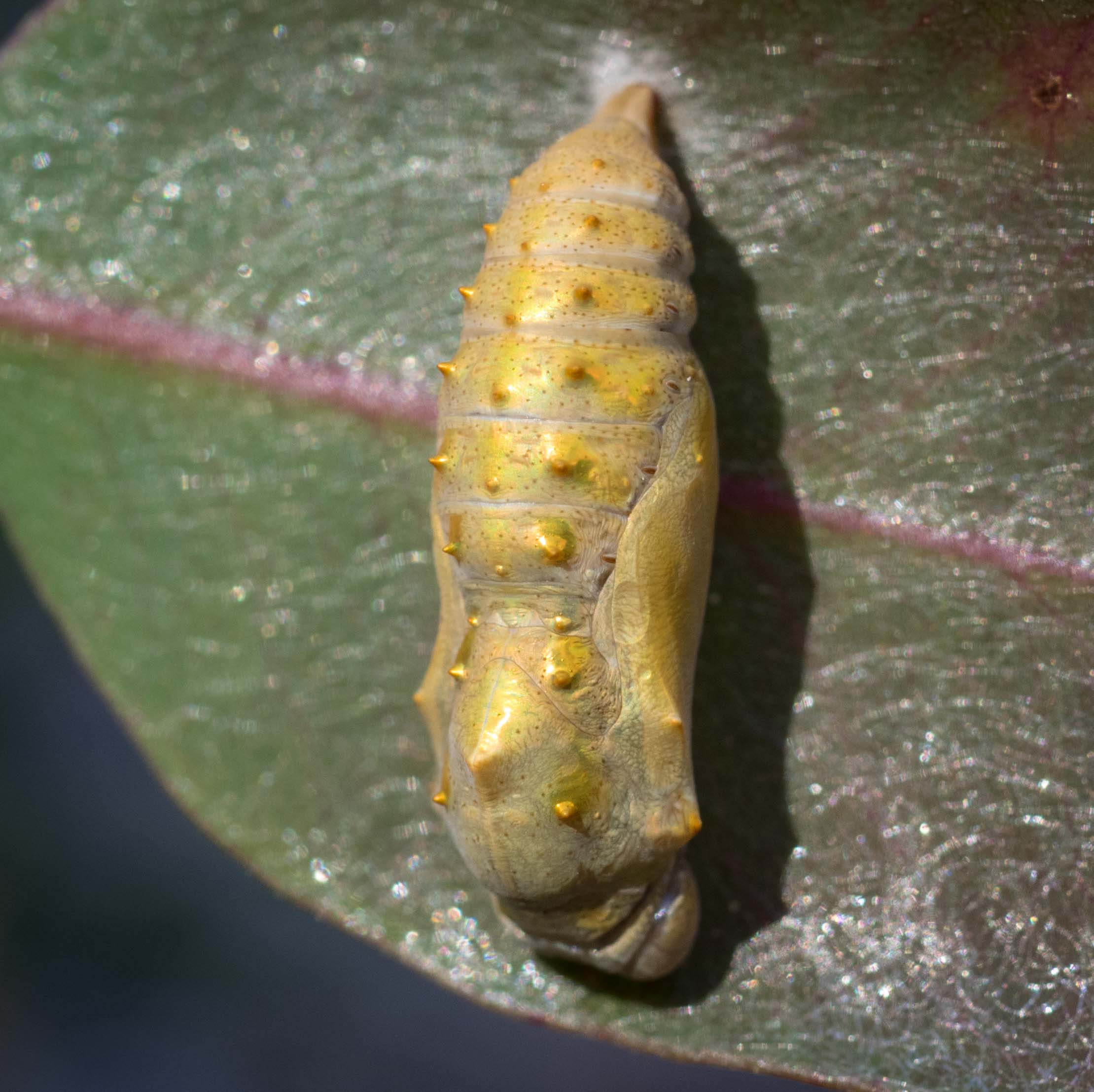
Australian Painted Lady (chrysalis)
Vanessa kershawi
I discovered this stunningly gold chrysalis hanging on a small eucalypt seedling. Not knowing what it belonged to, I collected it - and three days later a perfect Vanessa kershawi emerged.
Order: Lepidoptera; Family: Nymphalidae; Subfamily: Nymphalinae (nymphs)
Photo taken in January
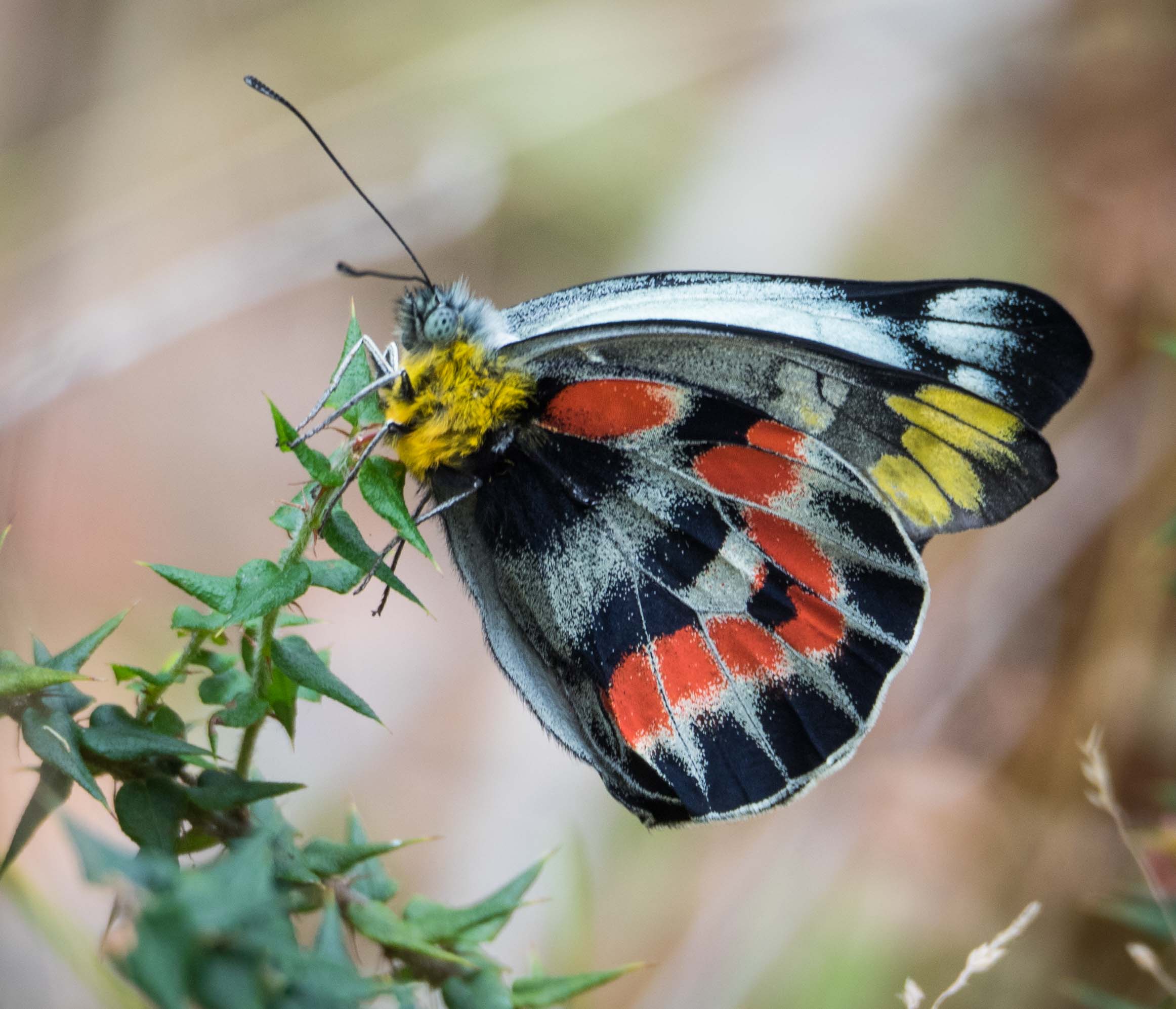
Imperial White
Delias harpalyce
This is a 'southern jezabel', a member of the family Pieridae. They are quite large butterflies but we usually only see them fleetingly, as they tend to fly high in the canopy.
Their larvae feed on mistletoe, so here in the forest they no doubt use the dominant mistletoe species, Amyema pendula (Drooping Mistletoe) - which tends to grow on high branches of the tallest trees, usually at least 20 metres up.
Delias harpalyce are reported to be distasteful and perhaps even toxic to vertebrates. Presumably the classic red-yellow colouration is aposematic, a warning to insectivorous birds.
Order: Lepidoptera; Family: Pieridae (whites & yellows)
Photo taken in January
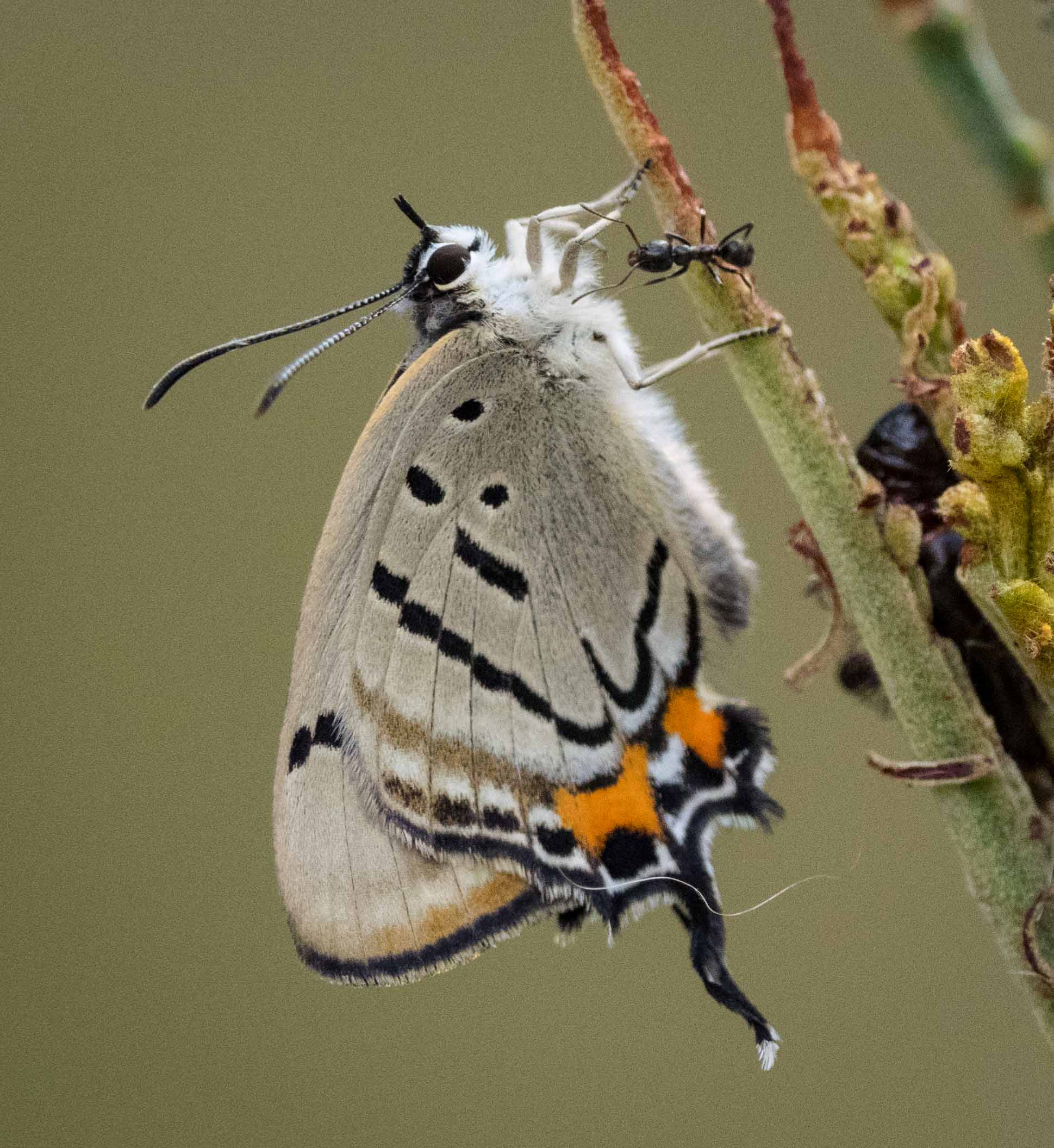
Imperial Hairstreak
Jalmenus evagorus
We tend to first notice this species when we spot a denuded Acacia sapling surrounded by butterflies. As is the case for many species within this family, Jalmenus evagoras has a well-studied association with ants. The feeding larvae and pupae are tended by Iridomyrmex ants in a commensal relationship.
The 'hairstreaks' belong to the very large and diverse butterfly family, Lycaenidae.
Order: Lepidoptera; Family: Lycaenidae (hairstreaks, coppers & blues)
Photo taken in January
Click here to see our blog in 'News & Stories' for more images and videos of the ant-larvae interactions, and the extraordinary mating behaviour of the butterflies.
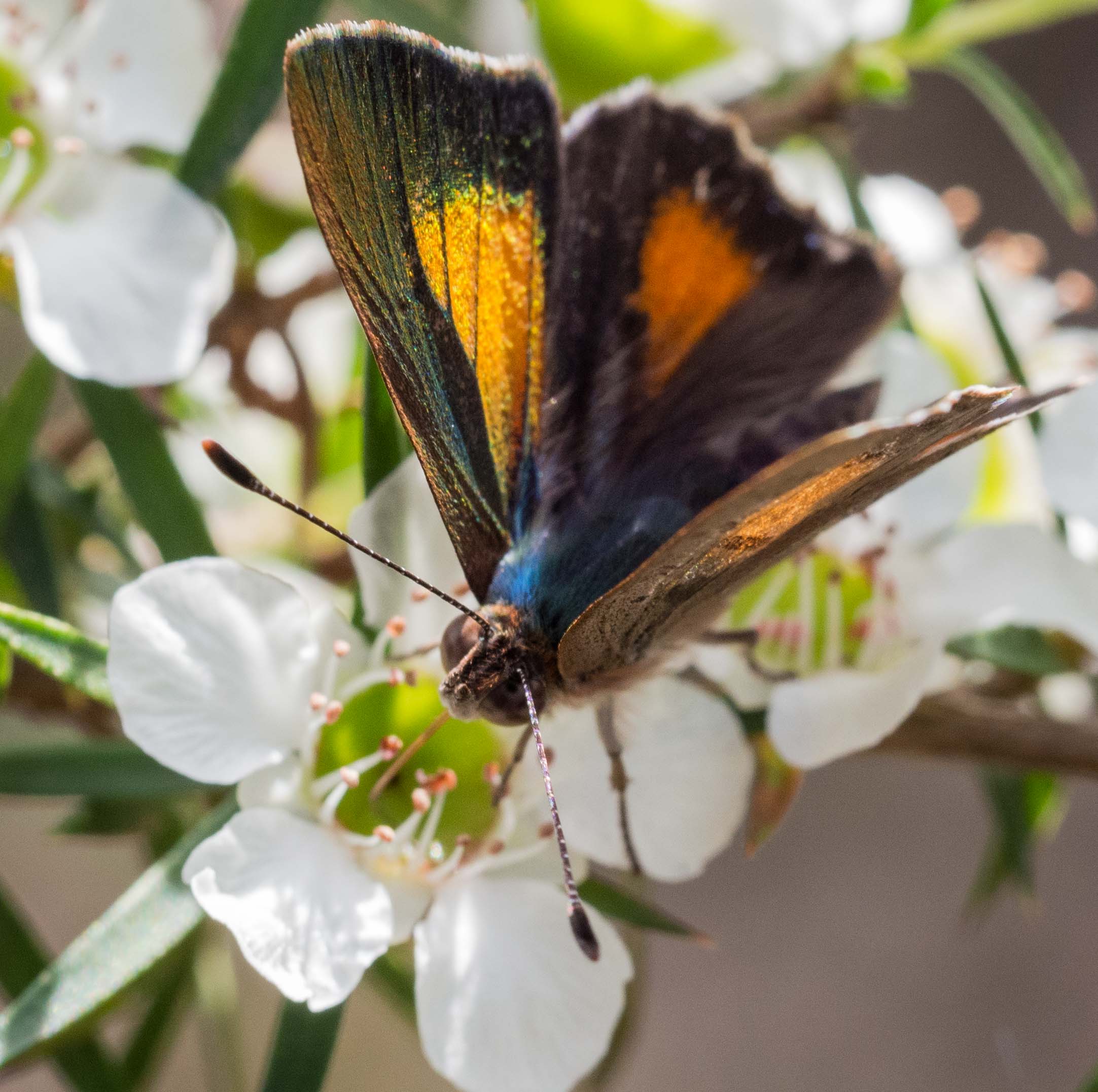
Bright Copper (male)
Paralucia aurifer
These tiny but brilliant butterflies almost glow in the sun. The larvae feed on Bursaria spinosa, a species with a limited distribution on the block. The spiny plant, in the same family as Pittosporum (Pittosporaceae), only grows on the rocky slopes leading down toward the river. The adults range more widely, feeding on flowering plants in all areas of the open forest.
Order: Lepidoptera; Family: Lycaenidae (hairstreaks, coppers & blues)
Photo taken in November
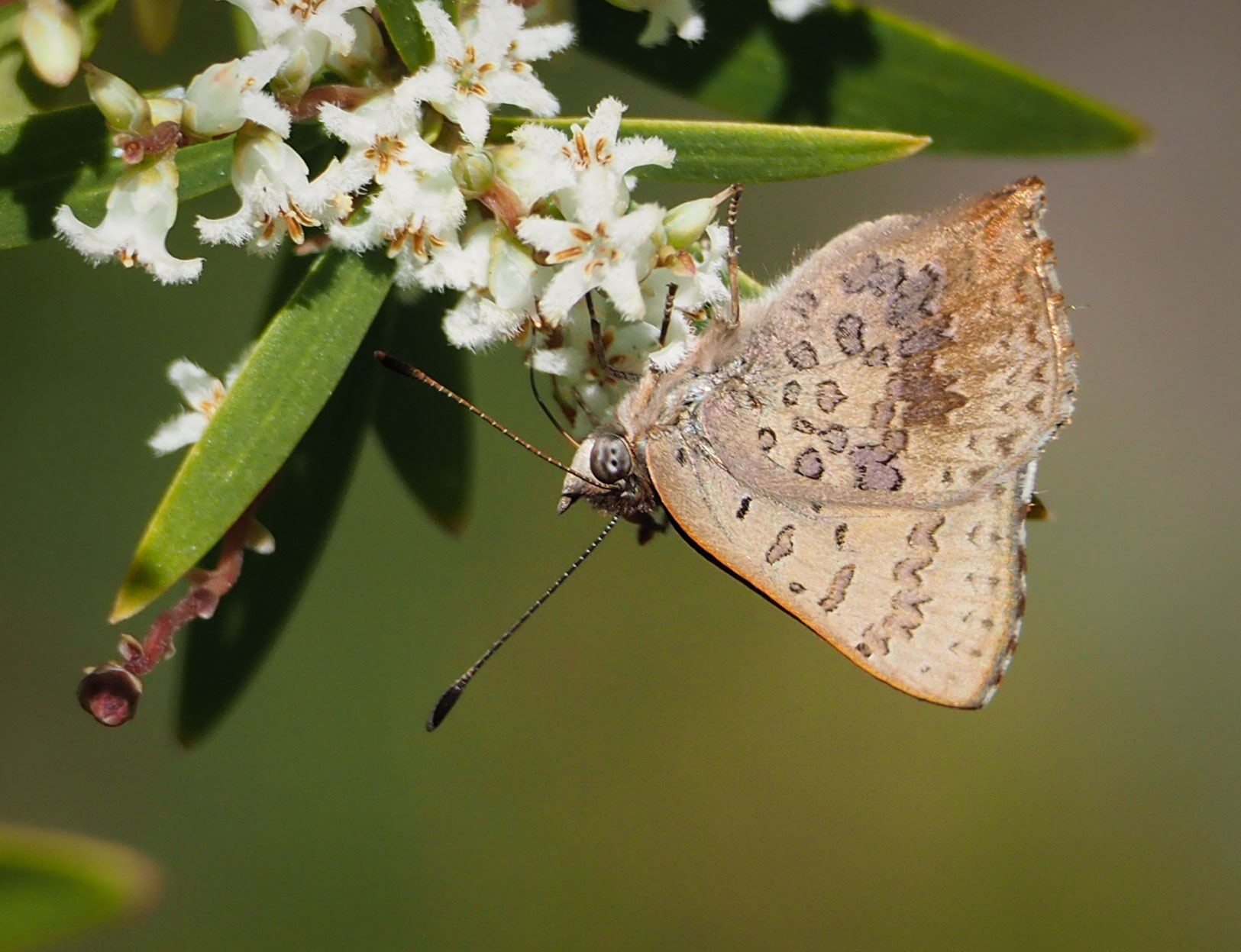
Bright Copper (female)
Paralucia aurifer
In this species, the underside of the female's wings are almost as beautiful as the upper surface.
The breeding biology of this species is fascinating. We have yet to witness this, but apparently the later instar caterpillars are nocturnal and ant-tended. No real surprise there, as ants associate with many species in the Lycaenidae family. The surprise is that the caterpillars then pupate within the ants' nest!
The female in this photograph is feeding on nectar from Leucopogon affinis - a flowering shrub that seems to feed dozens of the local species, invertebrate and vertebrate alike!
Order: Lepidoptera; Family: Lycaenidae (hairstreaks, coppers & blues)
Photo taken in September
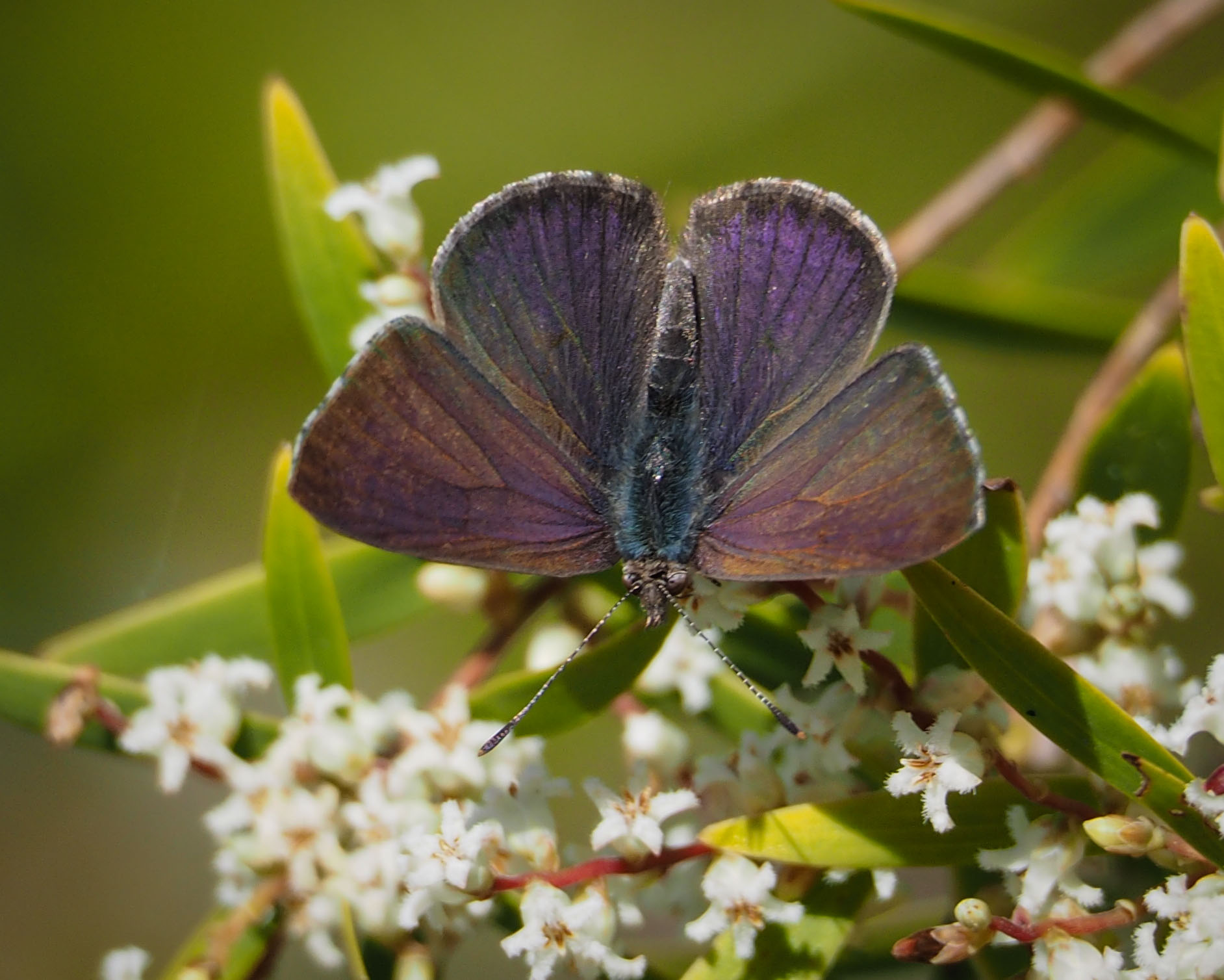
Common Dusky Blue (male)
Candalides hyacinthinus
Some butterflies are neither large nor showy. One of the most common groups flying around low flowering plants in Summer are the 'blues'. Newly-eclosed males, like this one, can be strongly blue-purple, but many others appear worn and dull, with few coloured scales at all.
Like most butterflies, this adult is opportunistic in seeking nectar - feeding here from Leucopogon flowers. It is the larval stages that are host-specific. The caterpillars of Candalides hyacinthinus feed on Cassytha vines.
Order: Lepidoptera; Family: Lycaenidae (hairstreaks, coppers & blues)
Photo taken in September

Yellow-spot Blue (male)
Candalides xanthospilos
The Yellow-spot Blue is small, like the Common Dusky Blue, and behaves in a similar manner. It is instantly recognisable, however, by the bright yellow spot on the upper forewing, and the much whiter undersides when the wings are closed.
These are our two most common Candalides species, and their larva occupy distinct niches. Whereas C. hyacinthus caterpillars feed on the parasitic vine Cassytha, which scrambles over grasses, forbs and tall shrubs alike, C. xanthospilos larvae feed on the low-growing shrub Pimelea linifolia (Slender Rice Flower). Due to grazing by wallabies, the Pimelea here rarely grow more than 50cm high.
Order: Lepidoptera; Family: Lycaenidae (hairstreaks, coppers & blues)
Photo taken in October
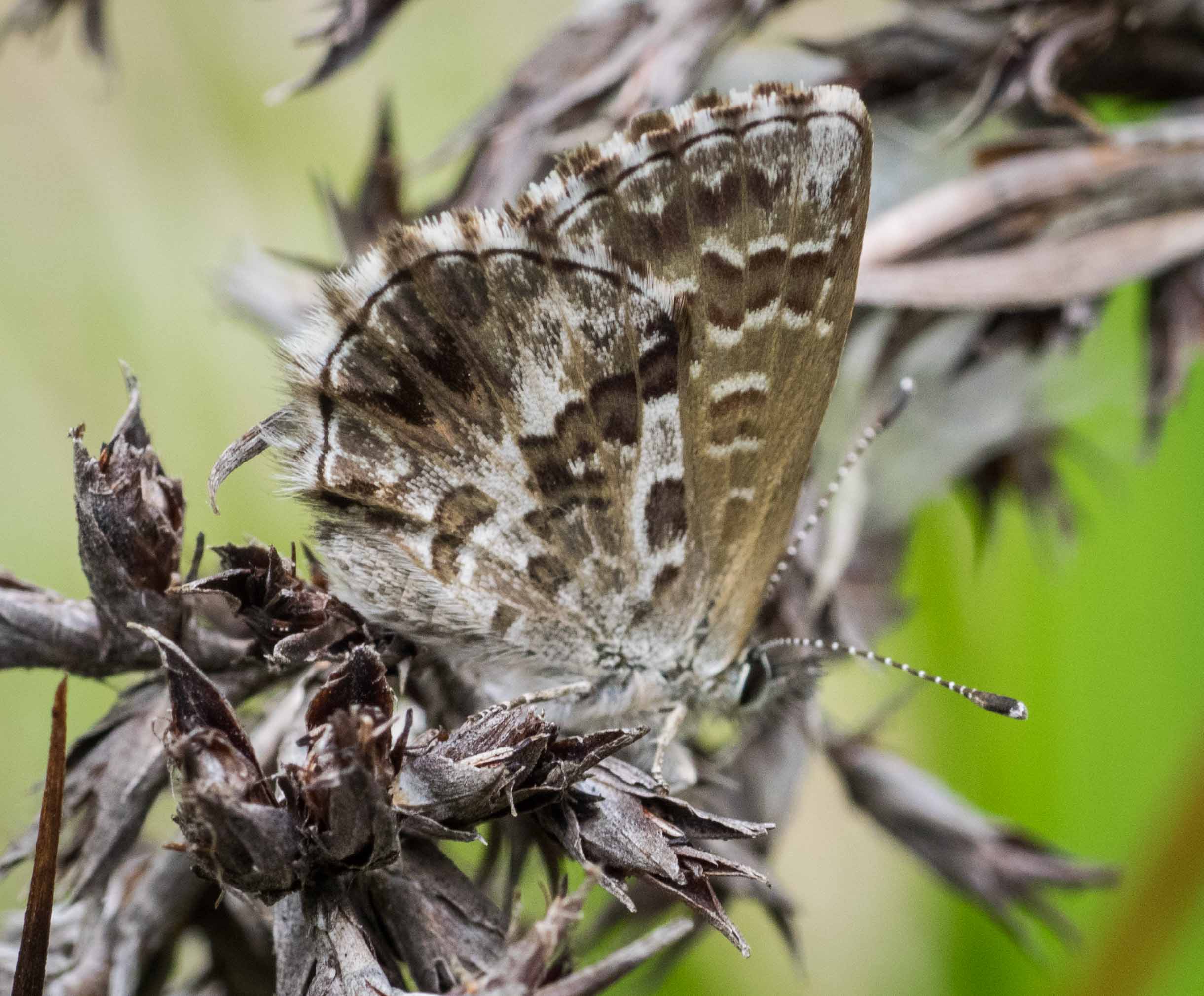
Fringed Heath Blue
Neolucia agricola
Yet another small 'blue', the Fringed Heath Blue is easily overlooked. The upper wings are brown and the patterned underwings provide perfect camouflage against dry vegetation. In this image, the butterfly is resting on Lepidosperma latens.
This species is common in heathland, including among heath plants in forests such as this. The larvae feed on a range of Fabaceae ('pea' flowers) including some that are particularly common on the block, such as Aotus ericoides and Bossiaea cordifolia.
Order: Lepidoptera; Family: Lycaenidae (hairstreaks, coppers & blues)
Photo taken in November
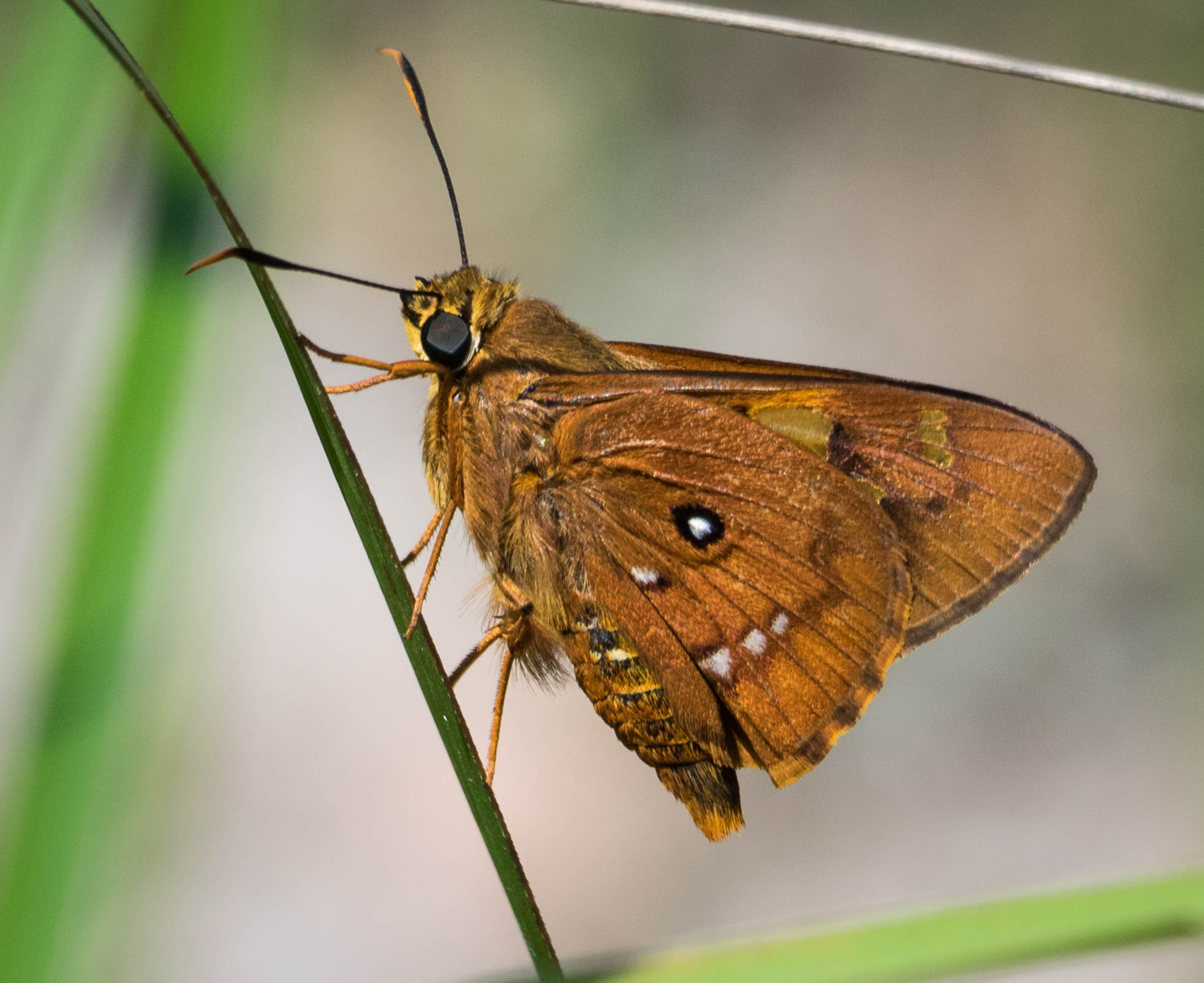
Splendid Ochre
Trapezites symmomus
In Summer, we see these 'skippers' regularly patrolling clumps of Lomandra, particularly Lomandra longifolia, and males rigorously defending their territories. The larvae are reportedly nocturnal feeders on Lomandra, but we have yet to search for them in earnest.
The Splendid Ochre is one of the most common and recognisable species of what is otherwise a difficult group. We see many other, smaller skippers too but have yet to get serious about surveying them. Perhaps next Summer!
Order: Lepidoptera; Family: Hesperiidae (skippers); Subfamily: Trapezitinae (ochres)
Photo taken in January

Spotted Sedge Skipper
Hesperilla ornata
Another skipper and - helpfully (!) - easily recognised by the spotty patterning of the underwings. The larvae feed on Gahnia which, here, means they are using Gahnia radula (Thatch Saw-sedge).
Order: Lepidoptera; Family: Hesperiidae (skippers); Subfamily: Trapezitinae (ochres)
Photo taken in December
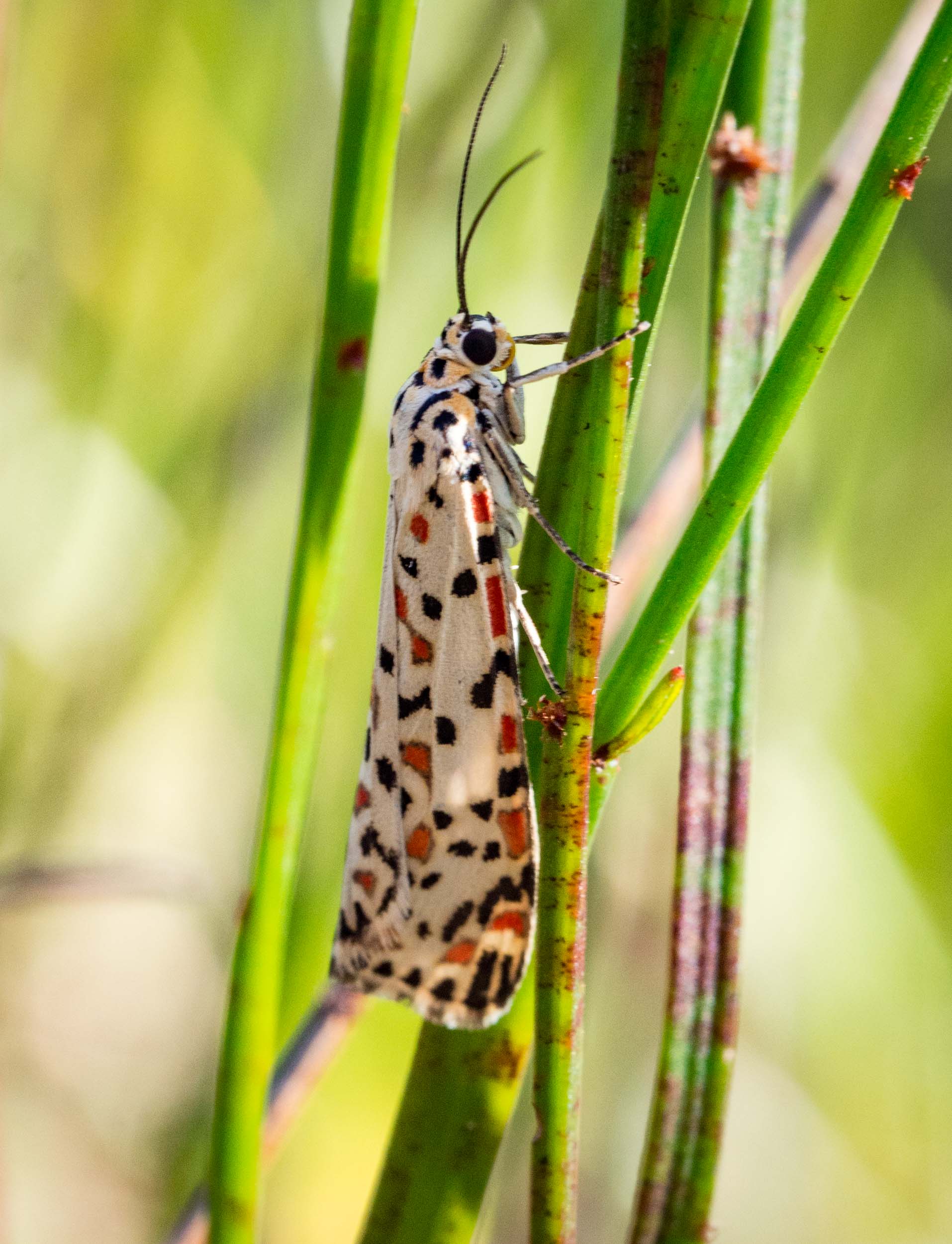
Heliotrope Moth
Utetheisa pulchelloides
Moths and butterflies are not so very different. They share a common ancestor and are grouped into a single order, Lepidoptera. In Australia, there are more than 80 families within Lepidoptera - and just 5 of those are called 'butterflies'. Most butterflies are colourful and fly during the day. They have antennae with some form of hook at the end.
But many of the day-flying, colourful lepidopterans are actually moths. This Heliotrope Moth is a migratory species, widespread across Australia, southern Asia and the Pacific. It is not a common species here in the forest.
Order: Lepidoptera; Family: Arctiidae (footmen & tiger moths)
Photo taken February

Lydia Lichen Moth
Asura lydia
During late Summer we see many of these distinctive 'tiger' moths, particularly in the most shaded, damp parts of the forest. They are sluggish in the early morning, but soon become much more active. The colouration is presumably aposematic, the moths distasteful to birds due to something in their diet as caterpillars.
Order: Lepidoptera; Family: Arctiidae (footmen & tiger moths)
Photo taken in February

Spotted Tiger Moth
Amata nigriceps
Although superficially similar to Asura lydia, this Amata species is considerably larger and we often see it flying in the early morning. It is also more likely to be found in open, drier parts of the forest.
The caterpillars of Amata nigriceps are thought to feed in the leaf litter. The reported peak month for sightings of adults in the south (i.e. eastern Victoria) is February, in accord with our own observations.
Order: Lepidoptera; Family: Arctiidae (footmen & tiger moths)
Photo taken in February
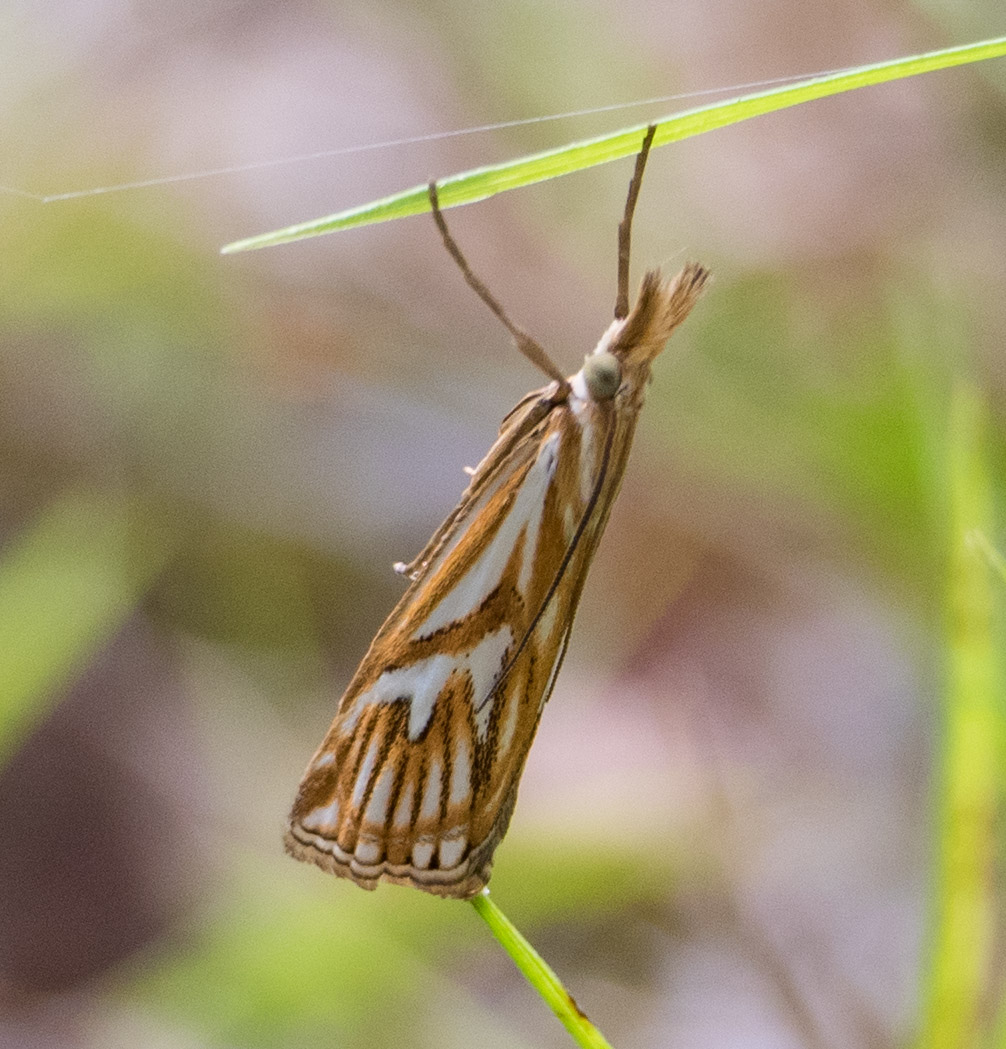
Grass Moth
Hednota pleniferellus
This Grass Moth is one of many species of tiny, inconspicuous moths - no doubt a group that makes a significant contribution to the food chain. Fairy wrens and other ground-feeding insectivores can often be seen feasting on small moths such as this. Fairy-wrens use the twitching of their upright tails to flush tiny moths that are otherwise concealed among the grasses.
Hednota pleniferellus caterpillars feed on grass such as Poa meionectes (Snow Grass).
Order: Lepidoptera; Family: Crambidae (grass moths)
Photo taken in February
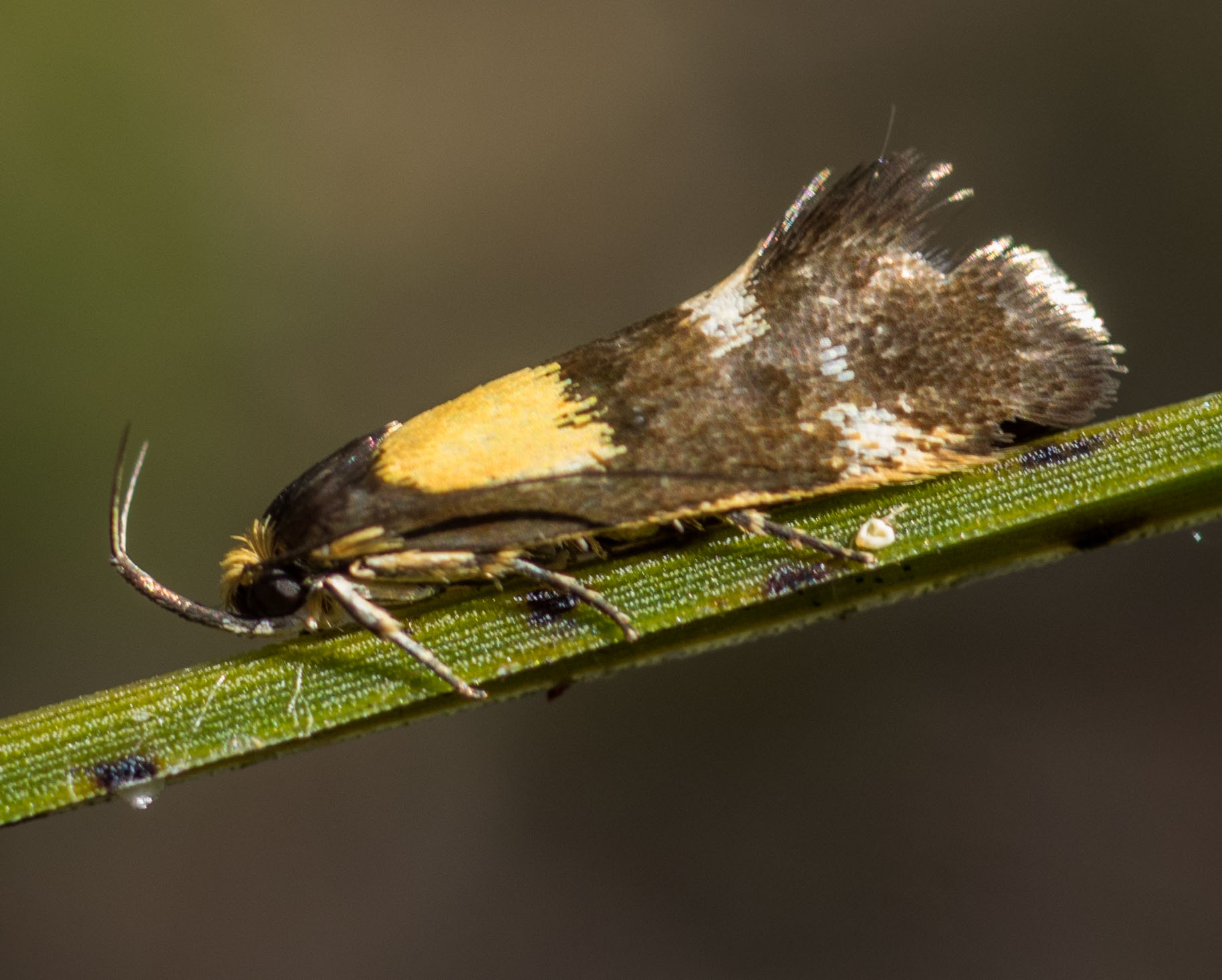
Yellow-shouldered Cosmet
Limnaecia sp.
Another tiny moth, yet quite spectacular when seen up close. And more food for the Fairy-wrens, I imagine!
Limnaecia belongs to the 'seed borer' family, Cosmopterigidae - along with nearly 400 other named species in Australia! Although we don't know exactly what the caterpillars feed on here in the forest, the larvae in this family generally feed inside plant stems and seeds - hence the name 'borers'.
Order: Lepidoptera; Family: Cosmopterigidae (seed borers)
Photo taken in November
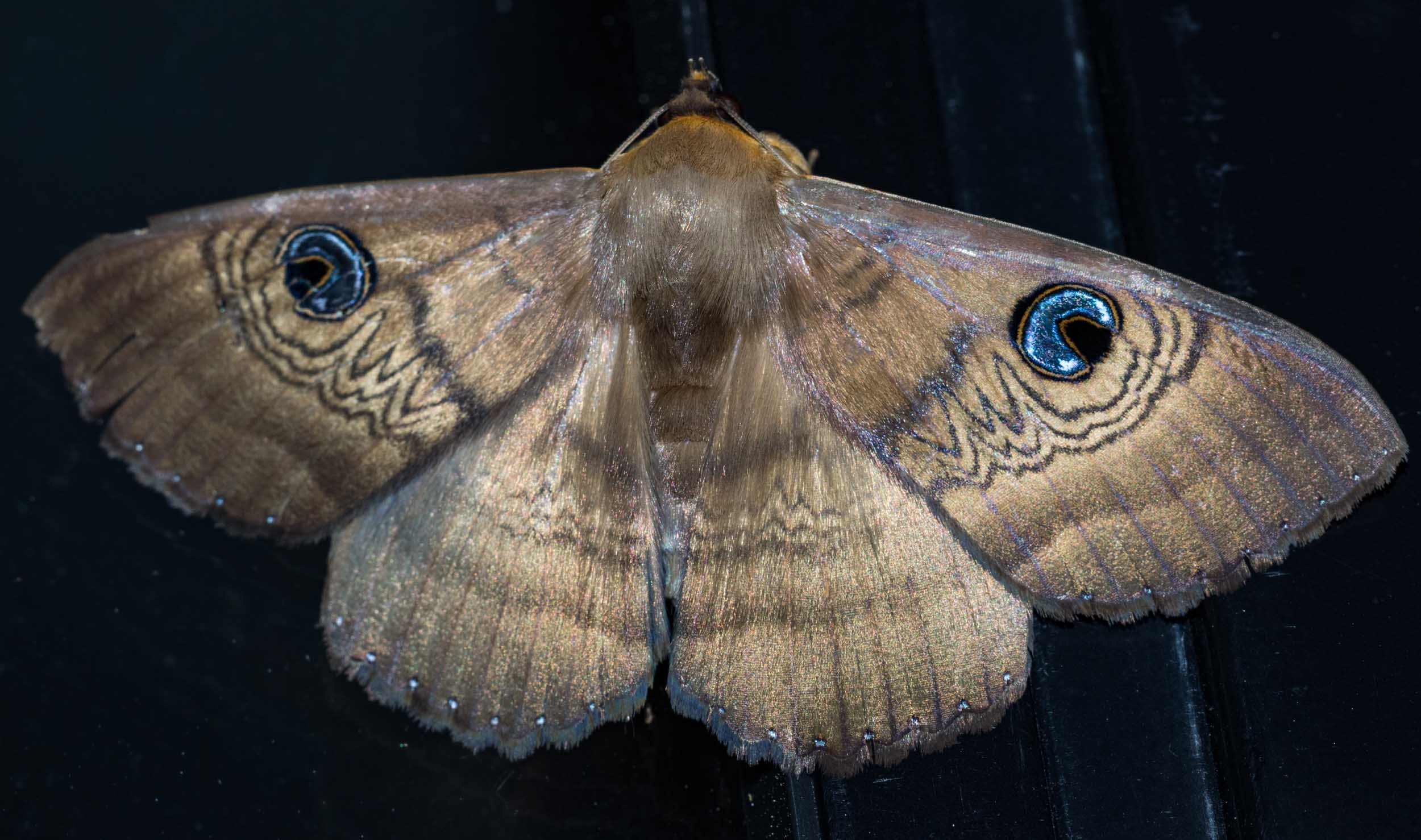
Southern Old Lady Moth
Dasypodia selenophora
At 90mm from wing-tip to wing-tip, Dasypodia selenophora is a truly conspicuous moth. As this species flies at night and is attracted to lights, these beautiful moths are well-known for entering buildings or settling on walls. And the coloured eye-spots are spectacular. We find them here, occasionally, from October to December, and usually just a single individual.
I do find the common name a little unsettling, though. Or maybe I'm just taking it too personally ... I think I'll adopt the alternative common name of 'Moon Moth'.
Order: Lepidoptera; Family: Noctuidae (armyworms)
Photo taken in November
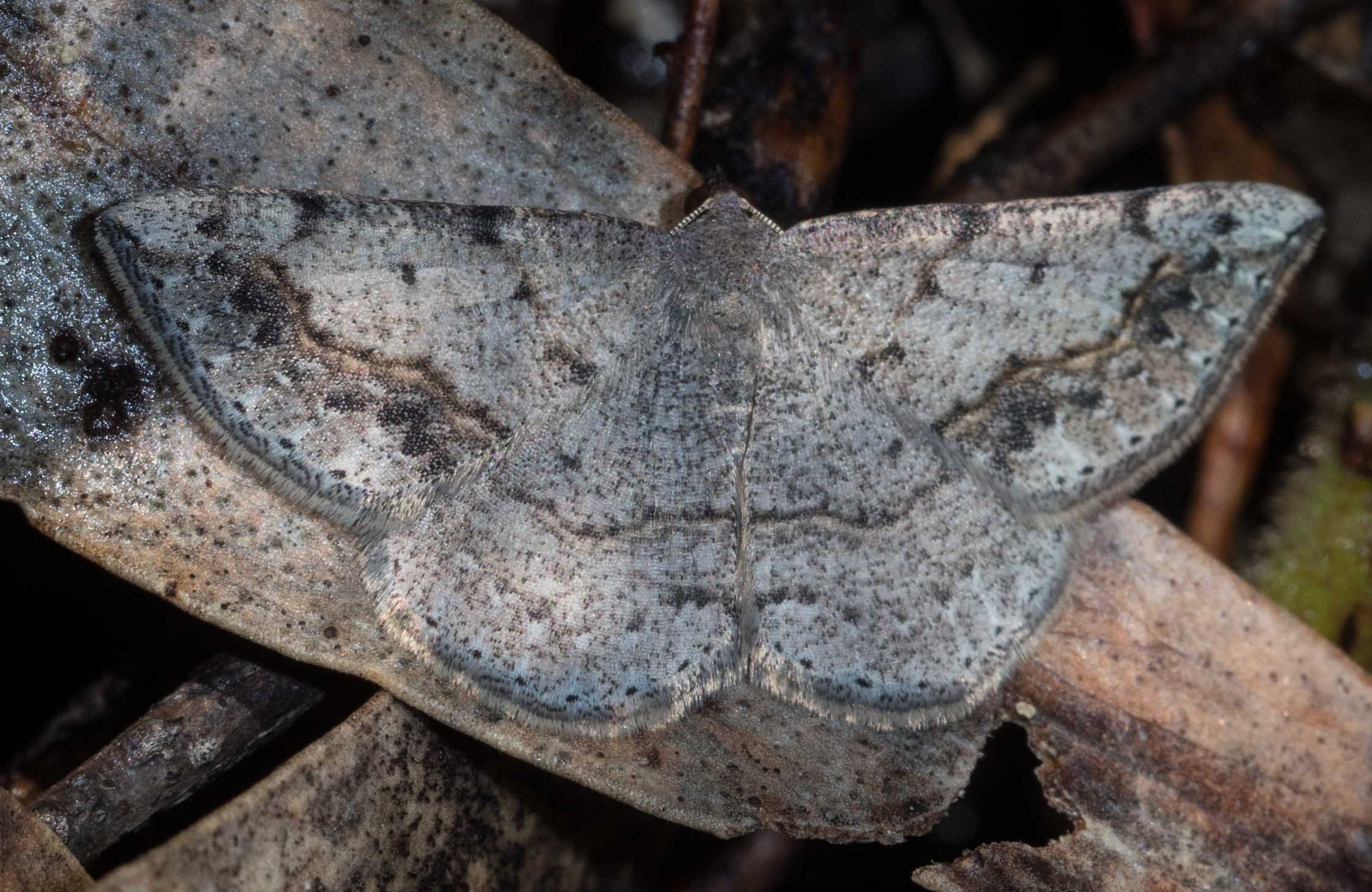
Spring Taxeotis
Taxeotis perlinearia
There are many medium-sized, nocturnal moths that rest on the forest floor during the day, flying only if disturbed. This Taxeotis is one such species. Their camouflage is superb. The only way I can see (and photograph!) them is if I watch very carefully where they land.
Their peak flight month in southern Australia is October - hence 'Spring' Taxeotis.
Order: Lepidoptera; Family: Geometridae (loopers)
Photo taken in December
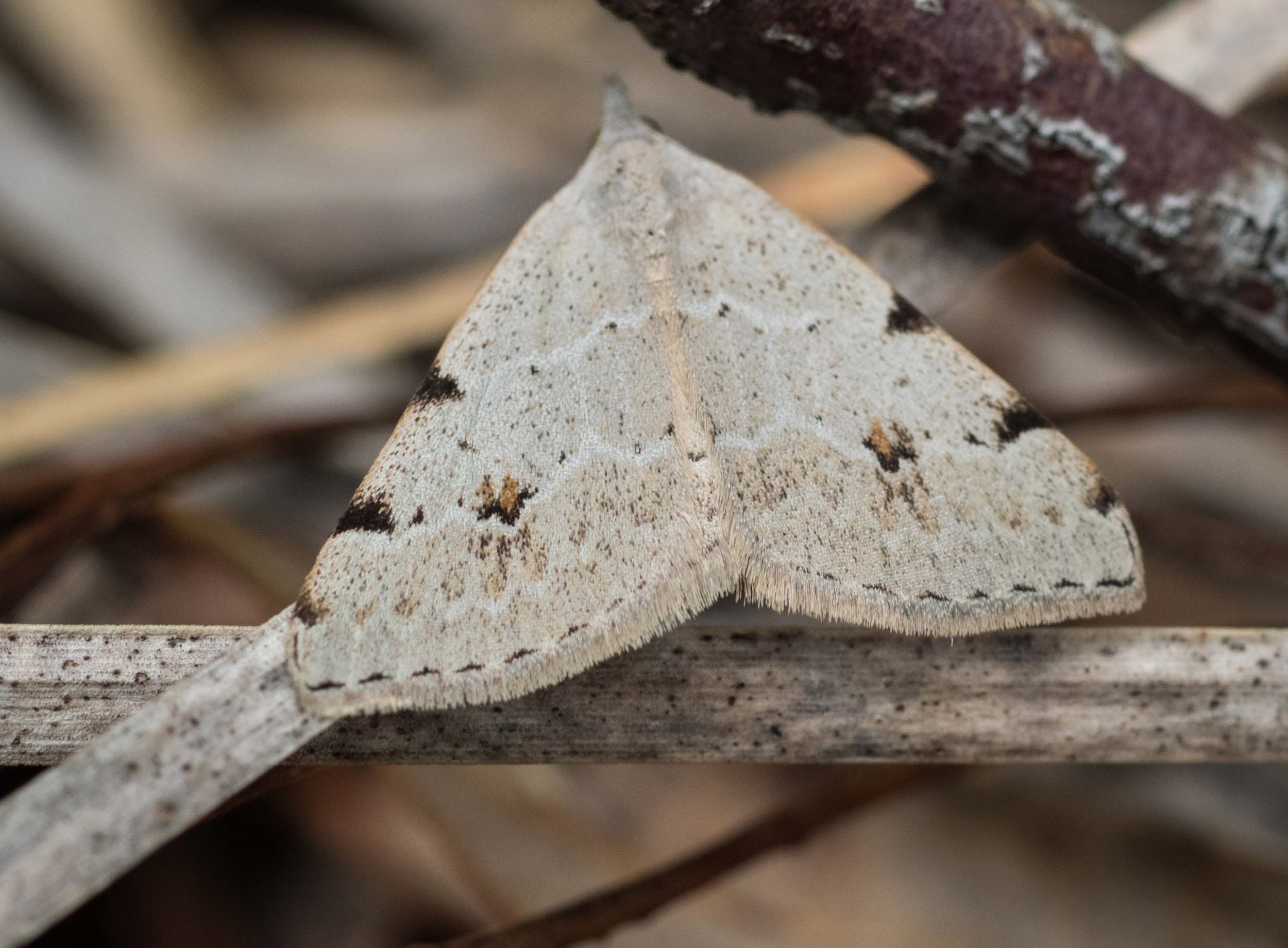
Pale Grey Heath Moth
Dichromodes estigmaria
Another well-camouflaged moth that sits motionless on the forest floor unless disturbed. It belongs to the same group as the Taxeotis - Geometridae.
Order: Lepidoptera; Family: Geometridae (loopers)
Photo taken in February
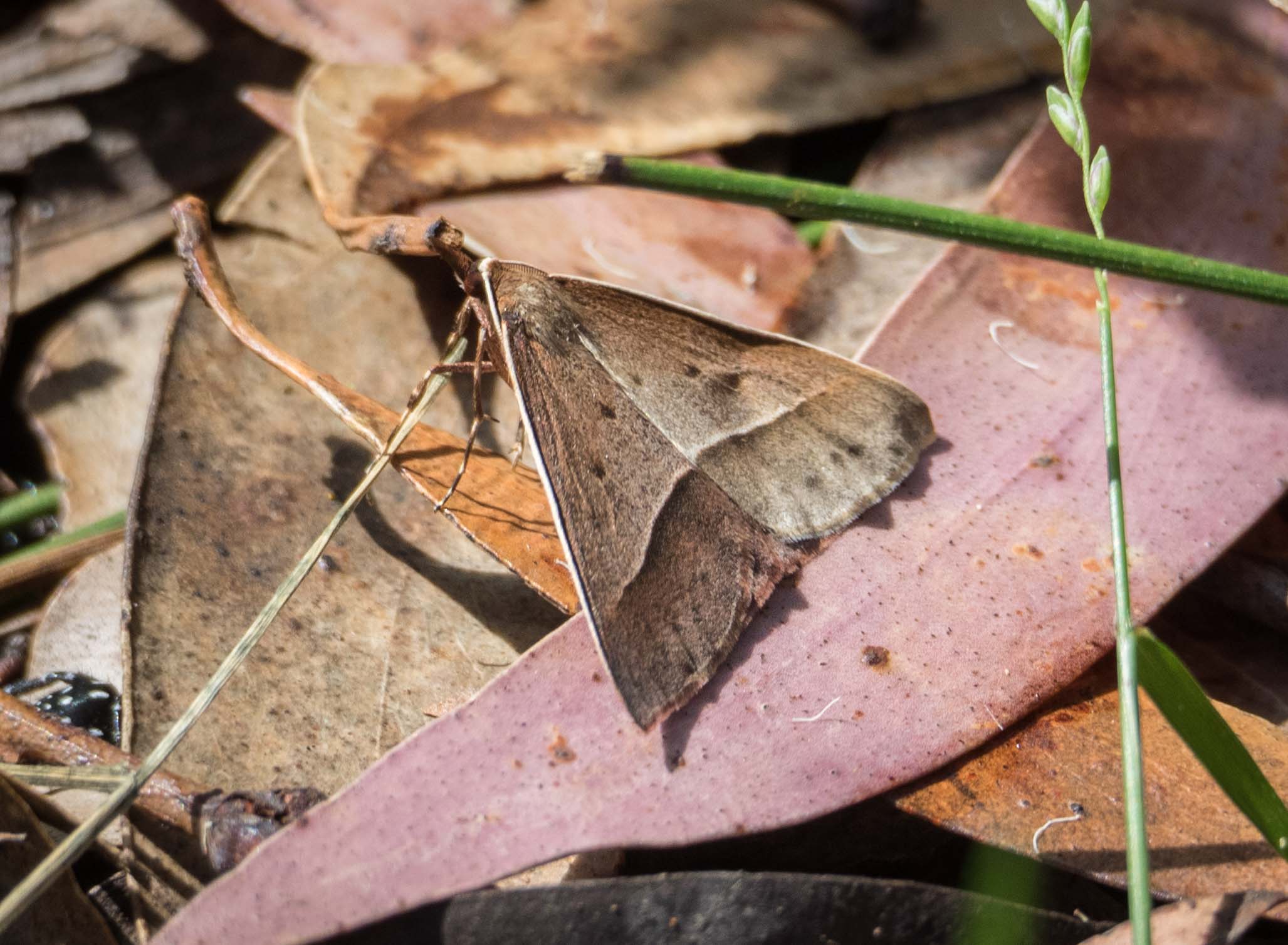
Golden-winged Epidesmia
Epidesmia chilonaria
Yet another secretive Geometridae moth. This species does fly more readily by day but will also sit totally motionless, to the point that you may almost touch it before it moves away. The upper hind wings are bright orange - hence the name - but are completely hidden when the moth is at rest.
Order: Lepidoptera; Family: Geometridae (loopers)
Photo taken in November

Golden-winged Epidesmia
Epidesmia chilonaria
A distinguishing feature of Epidesmia chilonaria and related species is the way they hold their labial palms locked together and pointing forward. Looks rather like a long nose, and quite comic.
Order: Lepidoptera; Family: Geometridae (loopers)
Photo taken in November
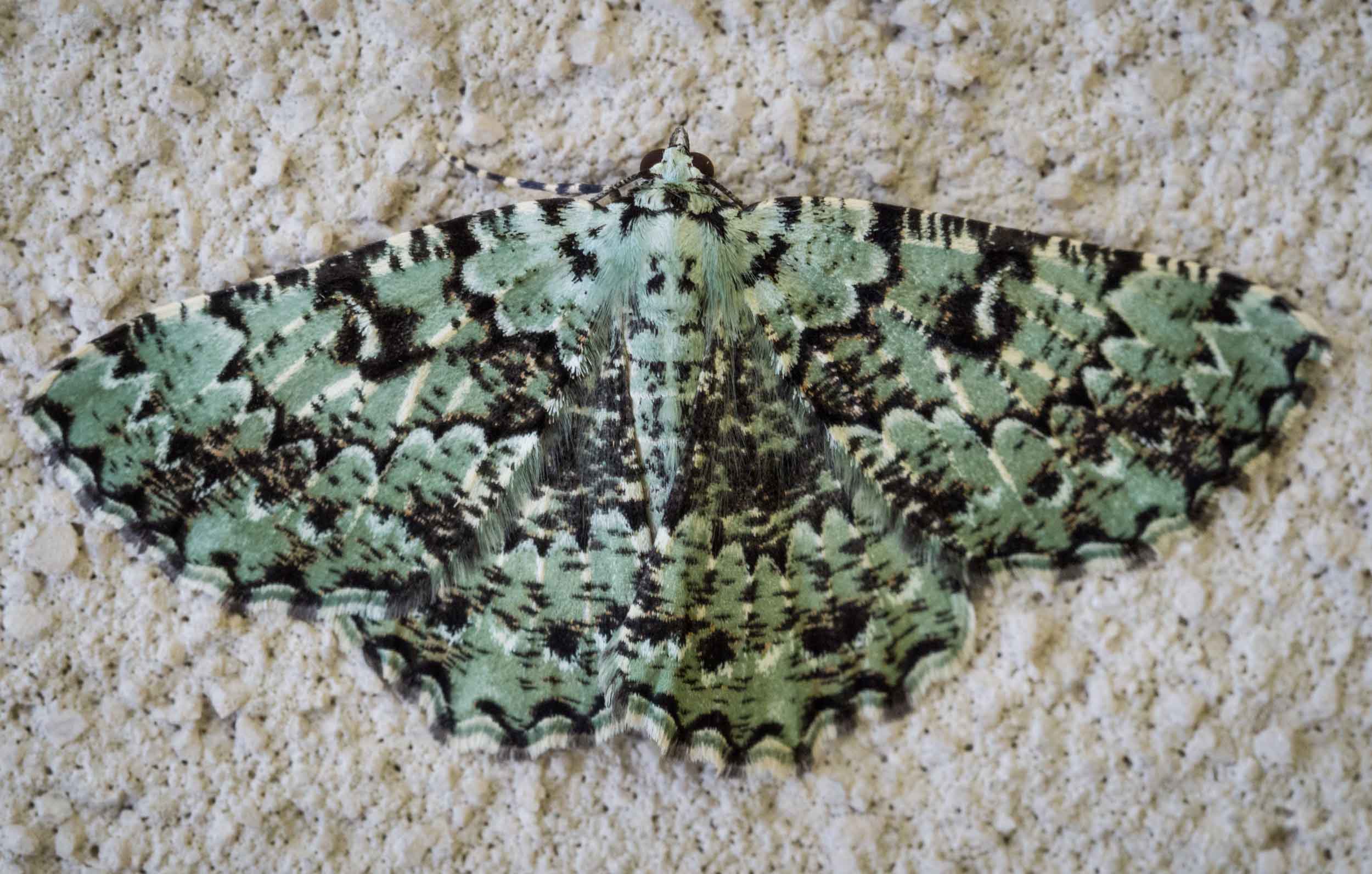
Cryptic Emerald
Aeolochroma mniaria
We discovered this striking looking moth on the wall of the house one morning. Although this was our first record of the species, they could easily go undetected in the forest, resting on lichen-covered tree trunks. The common name suggests as much.
Another Geometridae, but this one in the sub-group called 'Emeralds'
Order: Lepidoptera; Family: Geometridae (loopers)
Photo taken in November
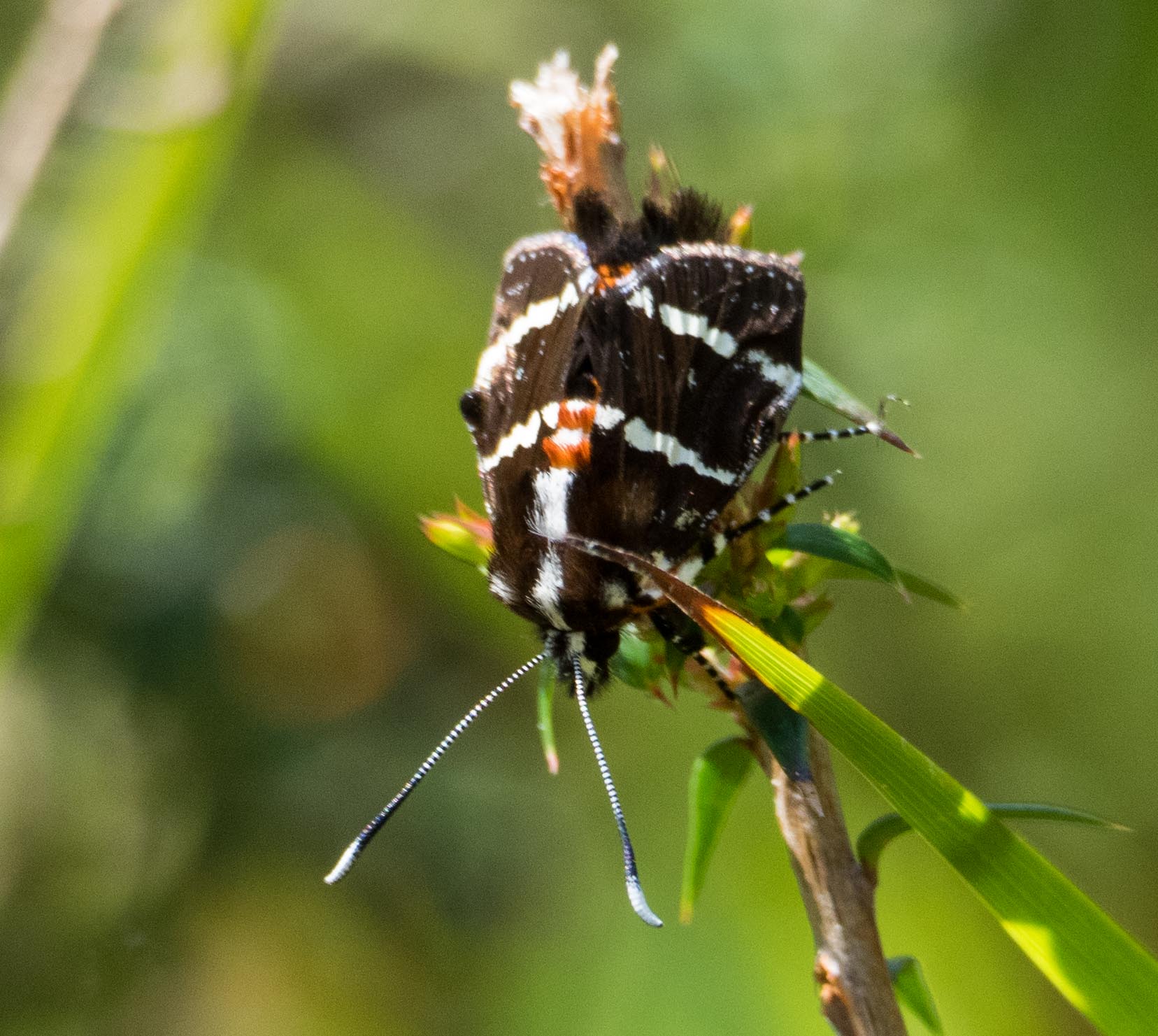
Common Whistling Moth
Hecastesia fenestrata
This species is not cryptic at all. The hindwing and hairy body are bright orange and visible in flight. But not only is it day active and brightly coloured - it also audibly announces its presence! In flight, males emit a sound that I think of as clicking but others clearly hear as a whistling. Either way, their spiralling early morning flights are hard to miss.
This species belongs to the family Noctuidae. Most members of this family have hairy caterpillars.
Order: Lepidoptera; Family: Noctuidae (armyworms)
Photo taken in November

Common Whistling Moth
Hecastesia fenestrata
The larvae of the Common Whistling Moth are quite large, and simply stunning! They feed on the parasitic vine, Cassytha.
Order: Lepidoptera; Family: Noctuidae (armyworms)
Photo taken in February
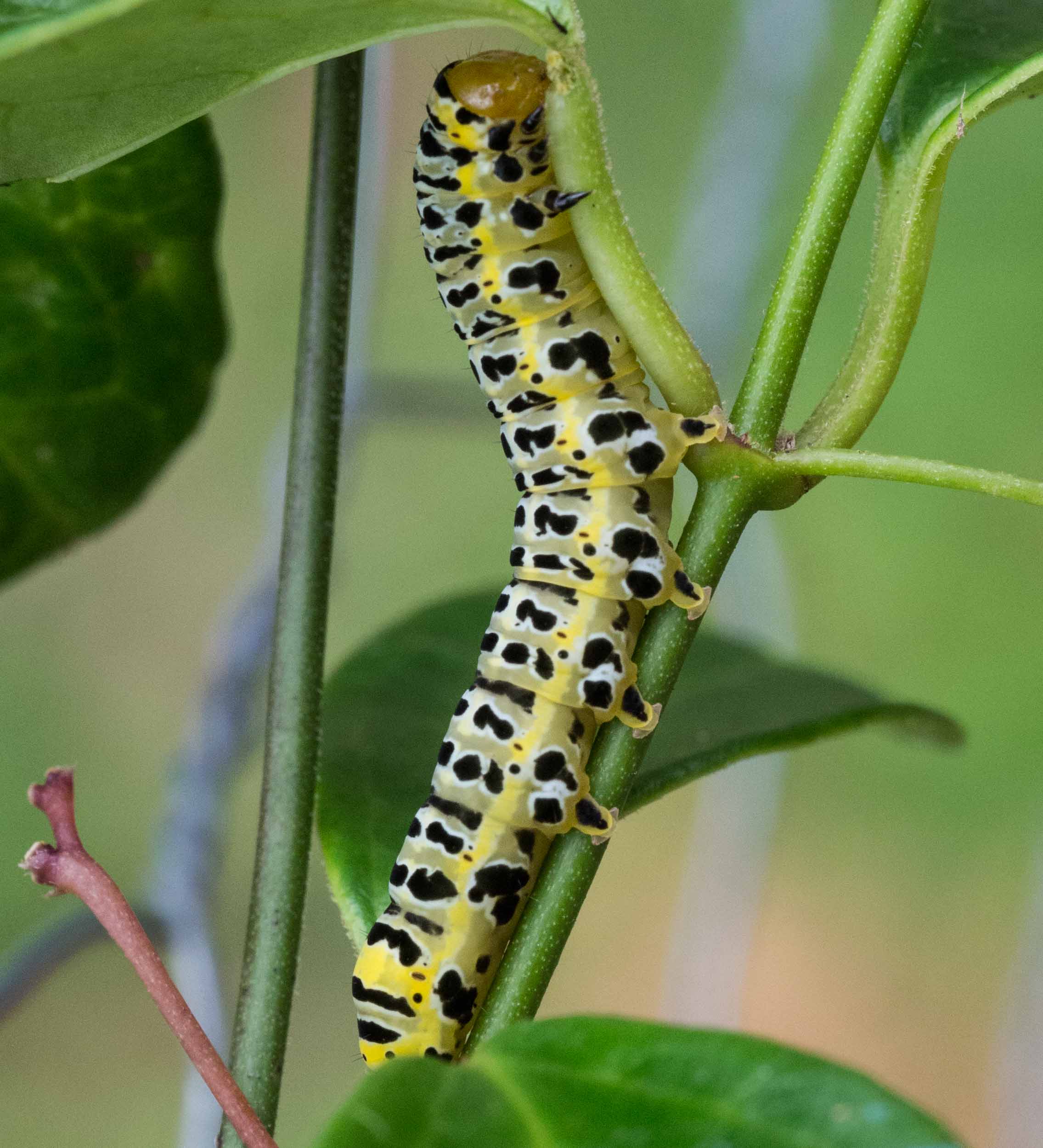
'Milk vine' caterpillar
Fodina ostorius
The caterpillars of this moth lack defensive hairs and are certainly not camouflaged! It seems likely that their spectacular colouration is aposematic, and that the caterpillars are distasteful to most predators.
Fodina ostorius caterpillars feed on 'Milk Vine' (Marsdenia species) or, as was the case when we discovered this one, on Tylophora barbata, another shiny-leaved vine in the same family as Marsdenia. Many plants in the family Apocynaceae produce alkaloids or potentially poisonous saps.
Order: Lepidoptera; Family: Noctuidae (armyworms)
Photo taken in December
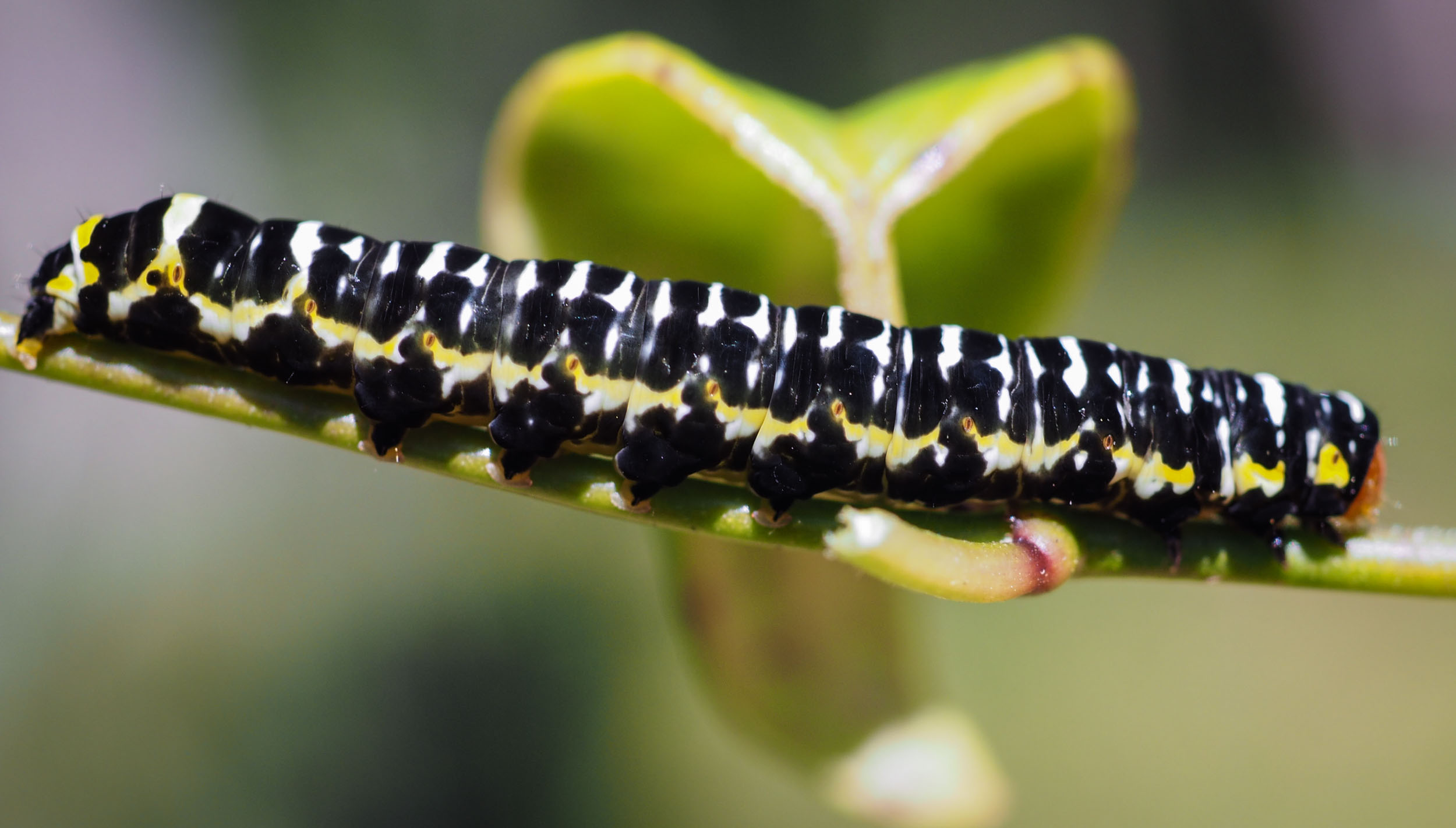
'Milk vine' caterpillar
Fodina ostorius
Just days after collecting the yellow caterpillar shown in the previous photo, we discovered two near-black individuals on other Tylophora barbata vines. They seemed identical to the yellow one, but with much more extensive black markings.
In order to unambiguously identify the species, we collected the two black caterpillars and raised them on leaves from the host plants. They synchronously pupated after four days in captivity.
Order: Lepidoptera; Family: Noctuidae (armyworms)
Photo taken in December
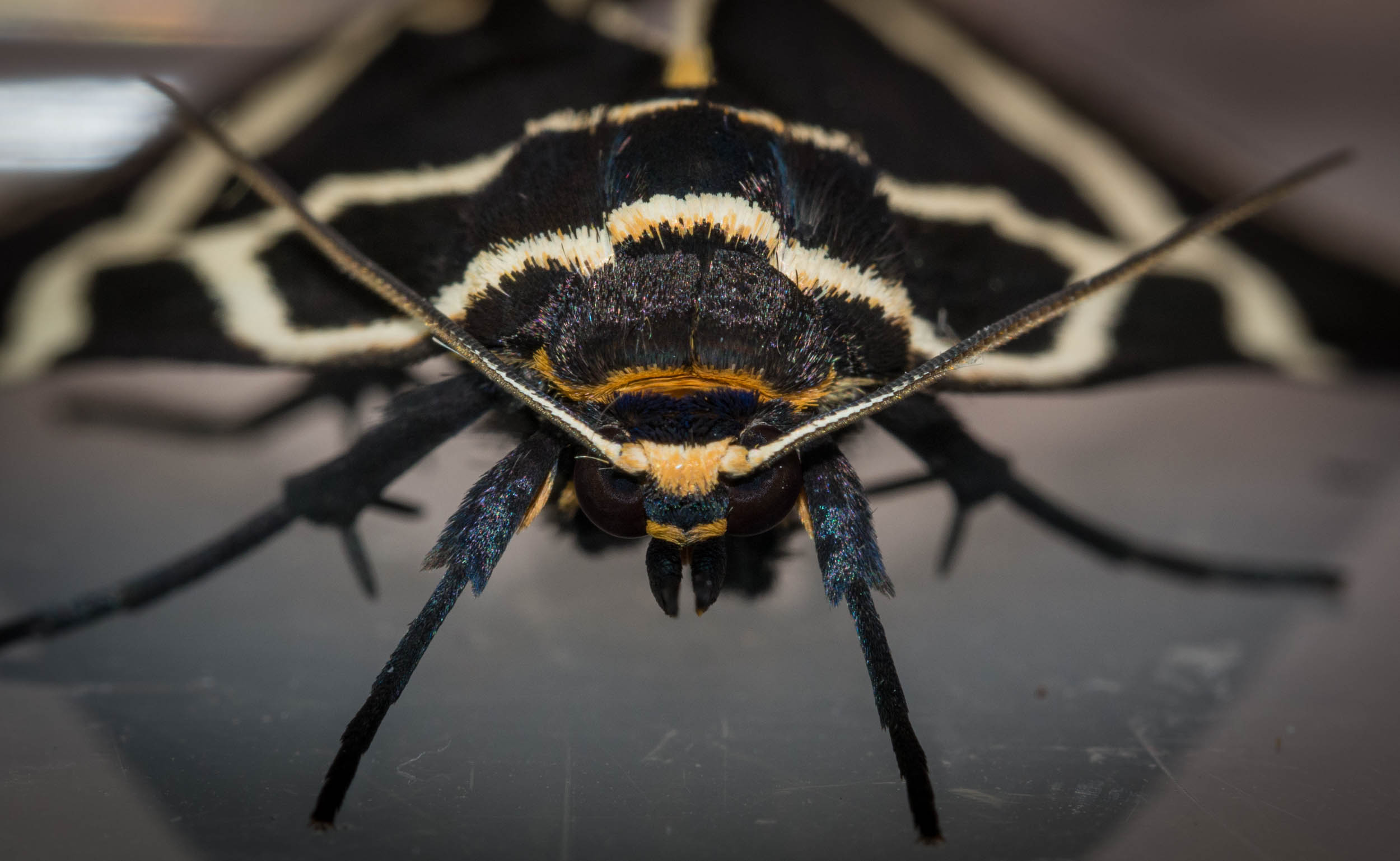
'Milk vine' moth
Fodina ostorius
The two collected caterpillars emerged in synchrony, just 16 days after pupating! Each shiny, brown chrysalis - which had been formed without cocoons - split open in the space of one hour.
The strikingly marked black and white moths that emerged confirmed the species identity for us. We photographed and then released them back to the forest.
Order: Lepidoptera; Family: Noctuidae (armyworms)
Photo taken in January

Ghost Moth
Elhamma australasiae
This night-flying species appears in quite large numbers, particularly in February and March. They have highly variable colours and patterns on the forewings, and typically purple hindwings and body.
Elhamma australasiae is a member of the family Hepialidae. We also see large numbers of another two Ghost Moth species - Oxycanus dirempta and Abantiades labyrinthicus. Ghost Moths often emerge and fly after rain.
Order: Lepidoptera; Family: Hepialidae (ghost moths)
Photo taken in February
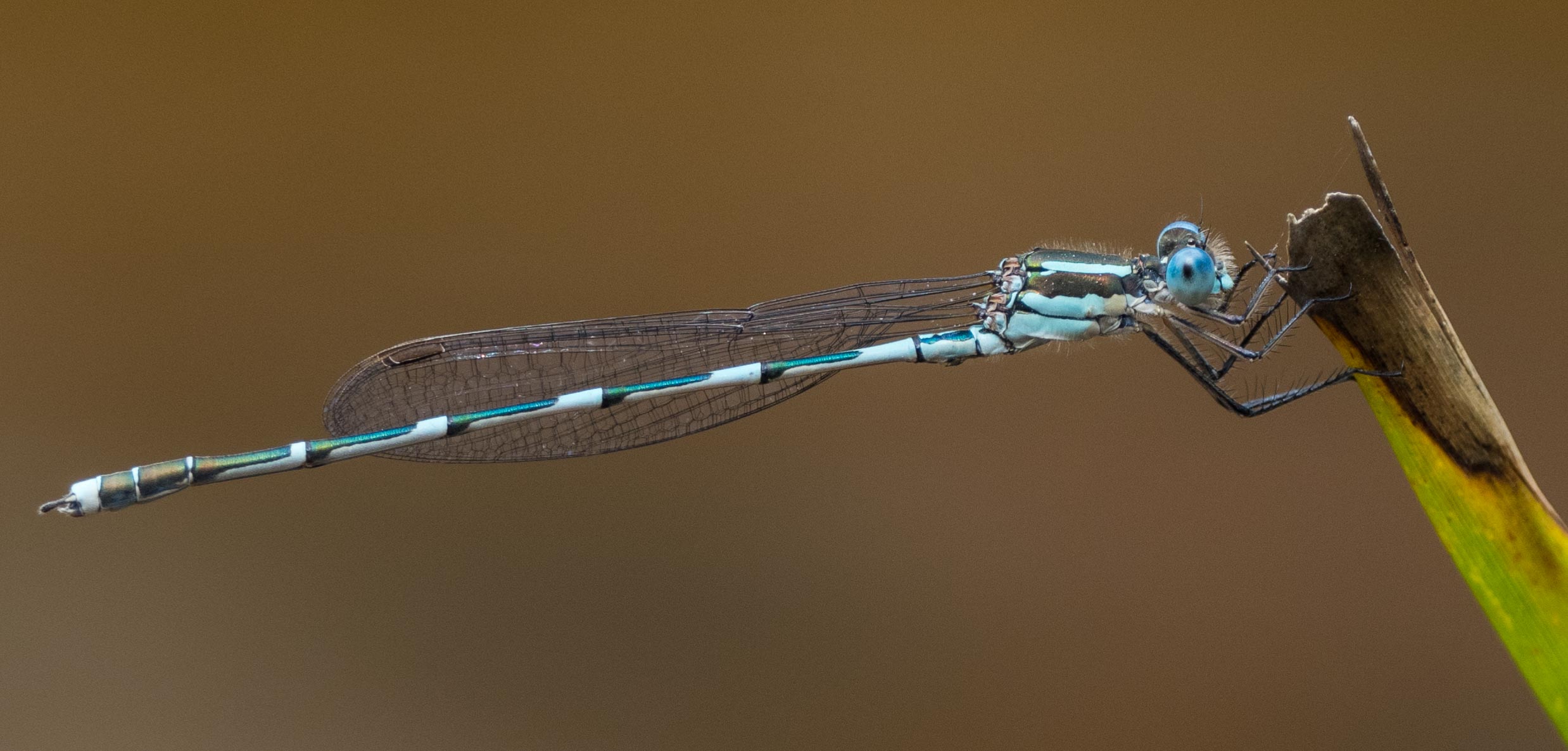
Wandering Ringtail (male)
Austrolestes leda
Various species of dragonflies and damselflies are seen in the forest. There is a large body of fresh water not far upstream, and many Odonata species range quite widely from their site of emergence, in search of food and mates.
A major motivation for constructing a small frog pond alongside the house was to encourage more visits from this group of insects, and so that we might see them up close. And it has worked! The pond is less than a year old, and already it has attracted breeding damselflies and dragonflies.
Austrolestes leda was the most numerous pond visitor last summer.
Order: Odonata; Family: Lestidae (spreadwings, reedlings)
Photo taken in October

Cup Ringtail
Austolestes psyche
Australia is home to more than 300 Odonata species. Based purely on their reported distributions, nearly 100 species might be seen in this corner of the country. However, in reality, the number we are likely to encounter in the forest is much smaller. 'Riverine' species don't travel far from the site of their larval development. And even some more 'wandering' species are found only at higher latitudes or in non-forest environments. In that light, the 14 species so far seen on the block seems like a respectable level of diversity!
Order: Odonata; Family: Lestidae (spreadwings, reedlings)
Photo taken in October
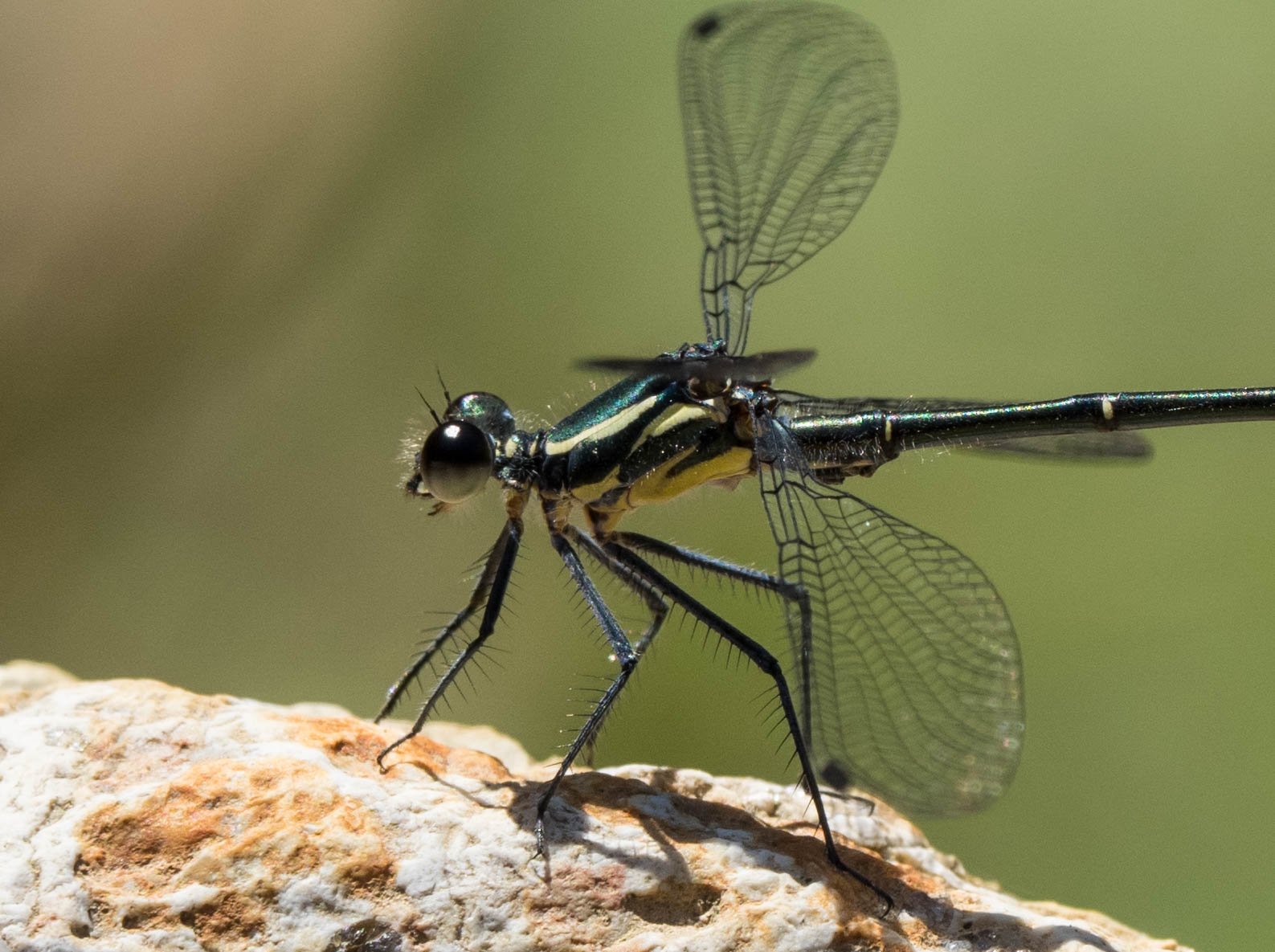
Common Flatwing
Austroargiolestes icteromelas
The two pairs of wings of damselflies are usually similar in size and shape. This is not the case for dragonflies, the forewing typically being longer and the hindwing broader. Most damselflies perch with their wings folded back along their bodies - but not all do!
Damselflies in the family Megapodagrionidae rest with their wings spread.
These small Flatwings, with their extraordinary coppery-green shine, are quite often seen in the forest here. At the pond, they tend to sit on the surrounding rocks, standing tall on their very long legs.
Order: Odonata; Family: Megapodagrionidae (flatwings)
Photo taken in November

Aurora Bluetail
Ischnura aurora
This beautiful species is a much rarer sight than the previous damselflies, although the species is found across Australia and beyond.
Ischnura aurora is one of the smallest damselflies we have seen here. When visiting the pond, they tend to hang well back from the water, perhaps intimidated by the territorial (and larger!) Austrolestes leda. The females were unaccompanied by males when egg laying.
Order: Odonata; Family: Coenegrionidae (pond damsels)
Photo taken in November

Wandering Ringtail
Austrolestes leda
Odonata eggs are laid in or (rarely) near water. The nymphs are predatory, feeding on whatever small animals they can find in their aquatic habitat. Mosquito larvae make excellent food for developing damselflies - one reason we have no concern that the pond alongside the house will generate a local mosquito plague.
Order: Odonata; Family: Lestidae (spreadwings & reedlings)
Photo taken in October
Click here to read the blog in News & Stories , for more of our observations of damselfly breeding.

Blue Skimmer (female)
Orthetrum caledonicum
This is the typical pose of a resting dragonfly, with wings outstretched.
Many of Australia's Odonata are endemic. Orthetrum caledonicum, however, is a very widespread species. It occurs throughout Australia, Papua New Guinea and on some Pacific Islands.
Order: Odonata; Family: Libellulidae (skimmers, perchers)
Photo taken in December
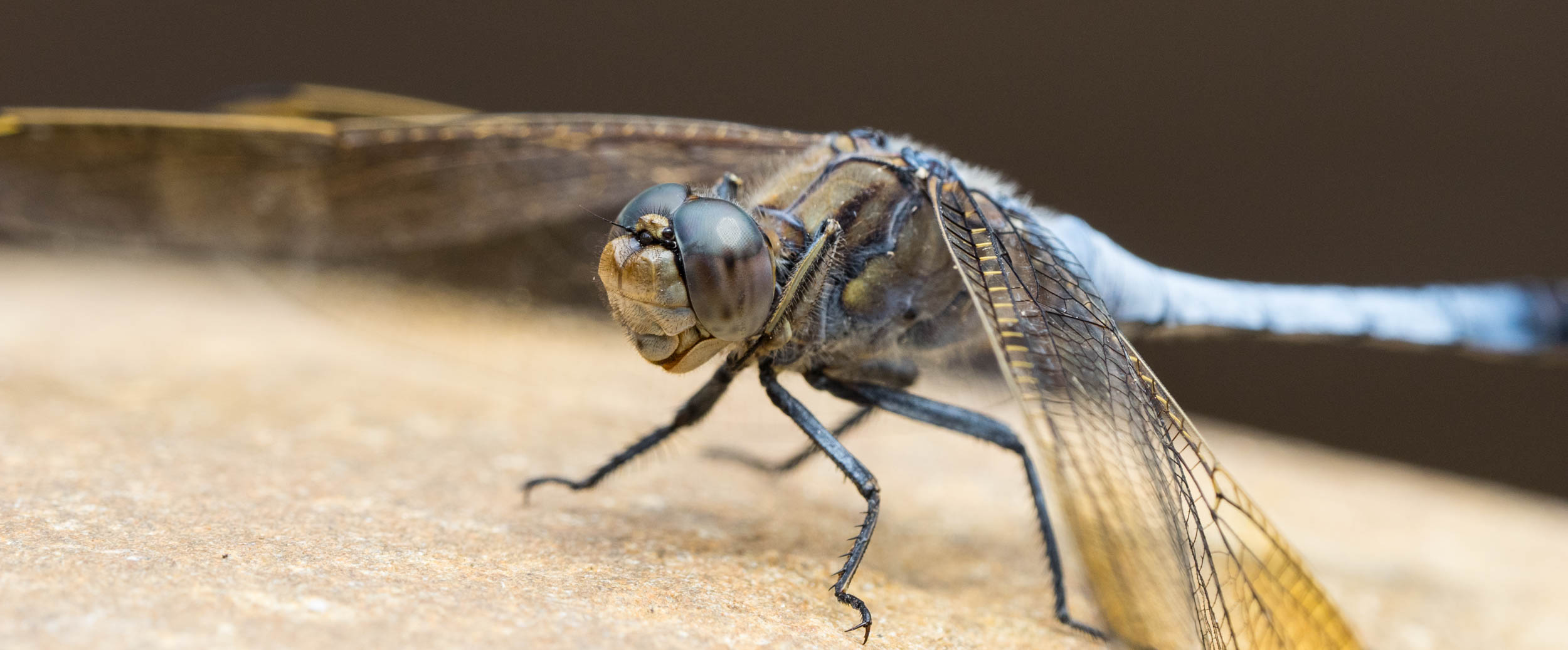
Blue Skimmer
Orthetrum caledonicum
Identification of Odonata on the basis of colour can be tricky. Colours vary with age - newly emerged insects, in particular, are typically quite pale and may look radically different a day later.
Another challenge to using colour is the varying degrees to which individuals develop 'pruinescence'. This refers to the waxy layer that obscures the underlying colour and often reflects as white.
Pruinescence is particularly common in the families Lestidae, Coenagrionidae and Libellulidae - and these happen to be the three families best represented here in the forest!
Order: Odonata; Family: Libellulidae (skimmers, perchers)
Photo taken in December
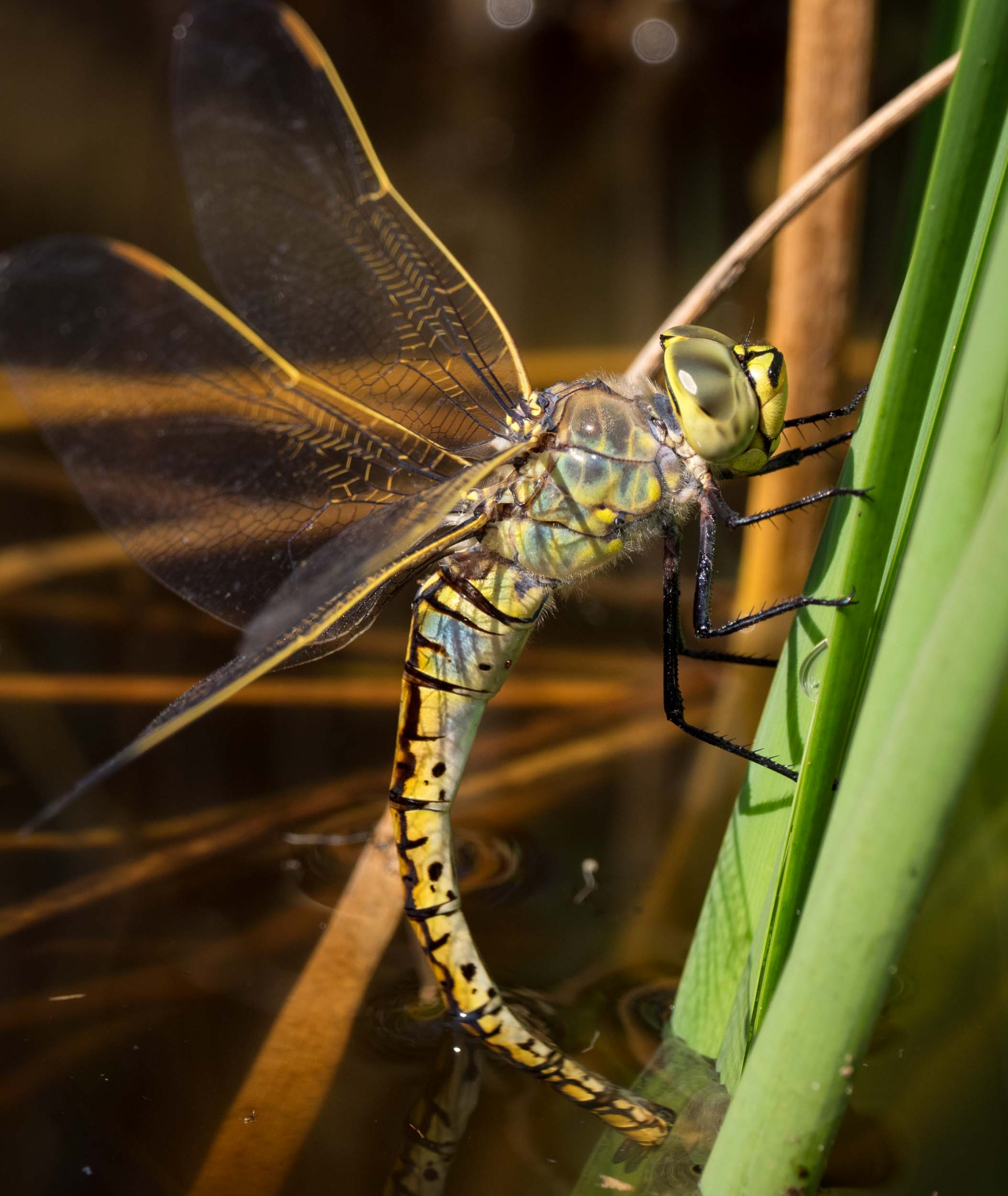
dragonfly
Just when I thought I was coming to grips with dragonfly identification, this brief sighting of an egg-laying female has me stumped. The facial markings are like those distinctive for Hemicordulia tau (Tau Emerald) but the colour patterns on the abdominal segments seems wrong - more like Orthetrum caledonicum (Blue Skimmer) ... but not quite that either. A mystery for another day.
Order: Odonata
Photo taken in December

Blue Skimmer
Orthetrum caledonicum
Odonata are aerial predators, capturing prey insects in flight. They have excellent vision, as the size and shape of their eyes attests.
Order: Odonata; Family: Libellulidae (skimmers, perchers)
Photo taken in January
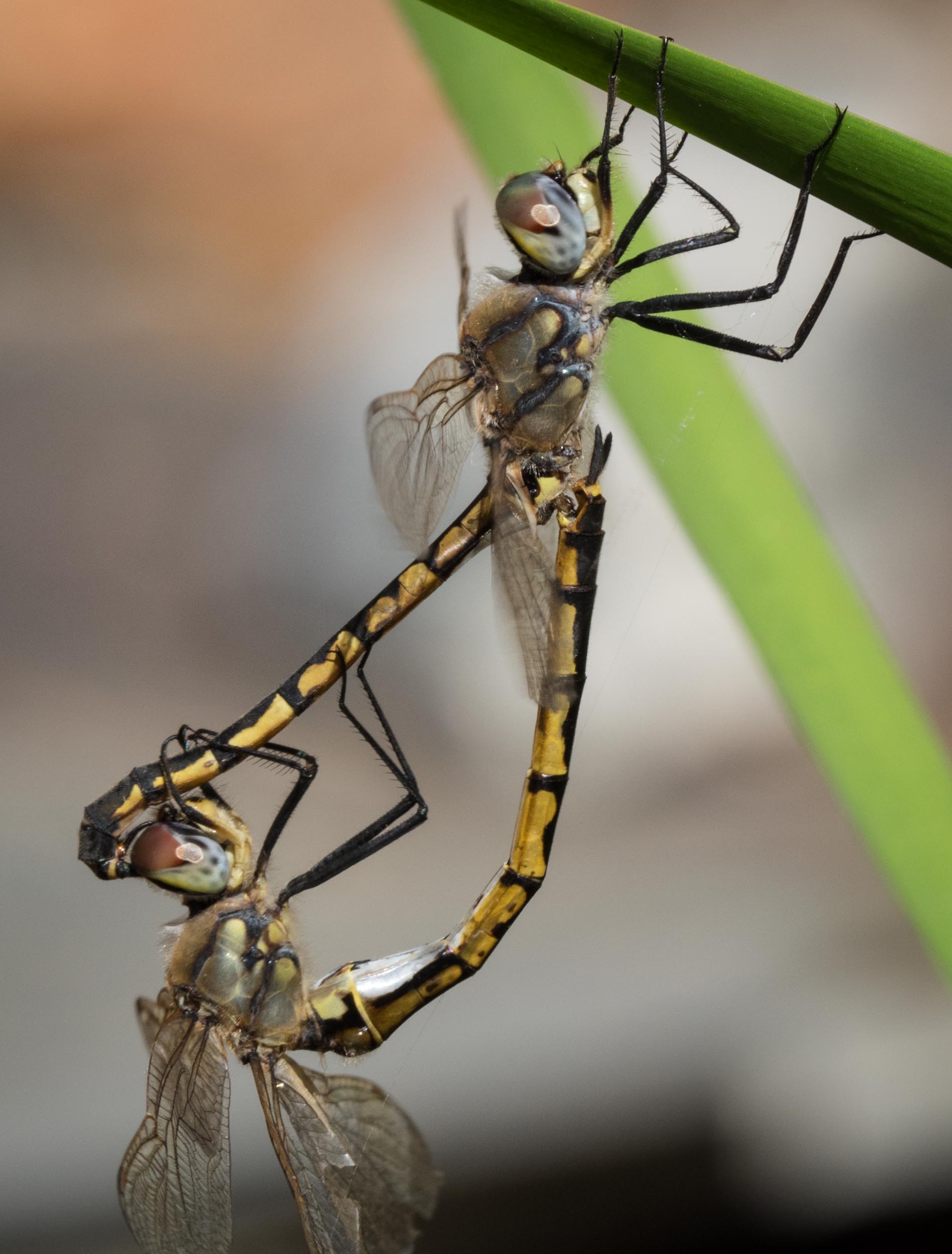
Tau Emerald
Hemicordulia tau
Some Odonata spend a lot of time perching, making them wonderful subjects for photography. Others, however, are almost always on the wing. The Tau Emeralds were the dominant dragonfly at the pond during summer, males constantly patrolling above the water and for a good distance all around. They hover, dart, hover, dart .... very tricky to get a shot.
But occasionally I would get lucky. This pair joined on the wing but then landed, albeit quite briefly. The male is the one holding the plant stem as the female is reaching upward to collect the sperm.
Order: Odonata; Family: Hemicordulidae (modern emeralds)
Photo taken in December

Australian Emerald
Hemicordulia australiae
Towards the end of Summer there was a shift in the dragonfly balance-of-power. The two species that held reign earlier - the Blue Skimmer (Orthetrum caledonicum) and the Tau Emerald (Hemicordulia tau) - were replaced by the territorial prowling of male Australian Emeralds (Hemicordulia australiae).
This species has a strikingly green sheen to the eyes and front of the face, a colour that is clearly visible even when they are flying about at speed.
Again, as with the Tau Emerald, the best chance for a photograph was on the rare occasions when they would land - which usually was only after the male had secured a mate.
Order: Odonata; Family: Hemicordulidae (modern emeralds)
Photo taken in March
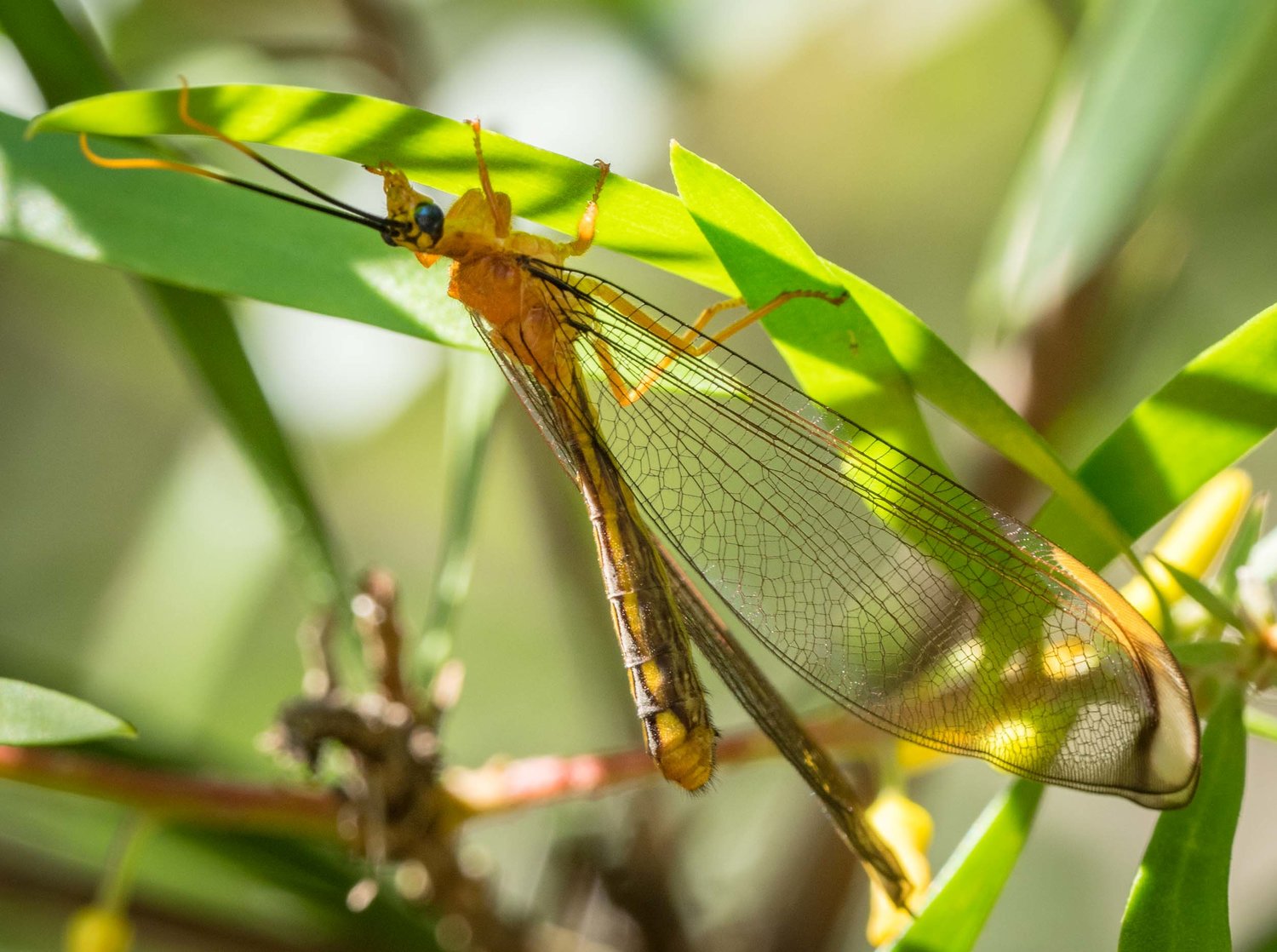
Blue-eyed Lacewing
Nymphes myrmeleonoides
This is a nocturnal lacewing, resting during the day beneath a leaf.
Order: Neuroptera; Family: Nymphidae
Photo taken in January

Golden Eye Lacewing
Mallada sp.
This is another nocturnal lacewing - this specimen was attracted to our house lights in the evening. Golden Eye Lacewings have a varied diet, feeding on pollen and nectar, supplemented with small arthropods.
Order: Neuroptera; Family: Chrysopidae
Photo taken in May
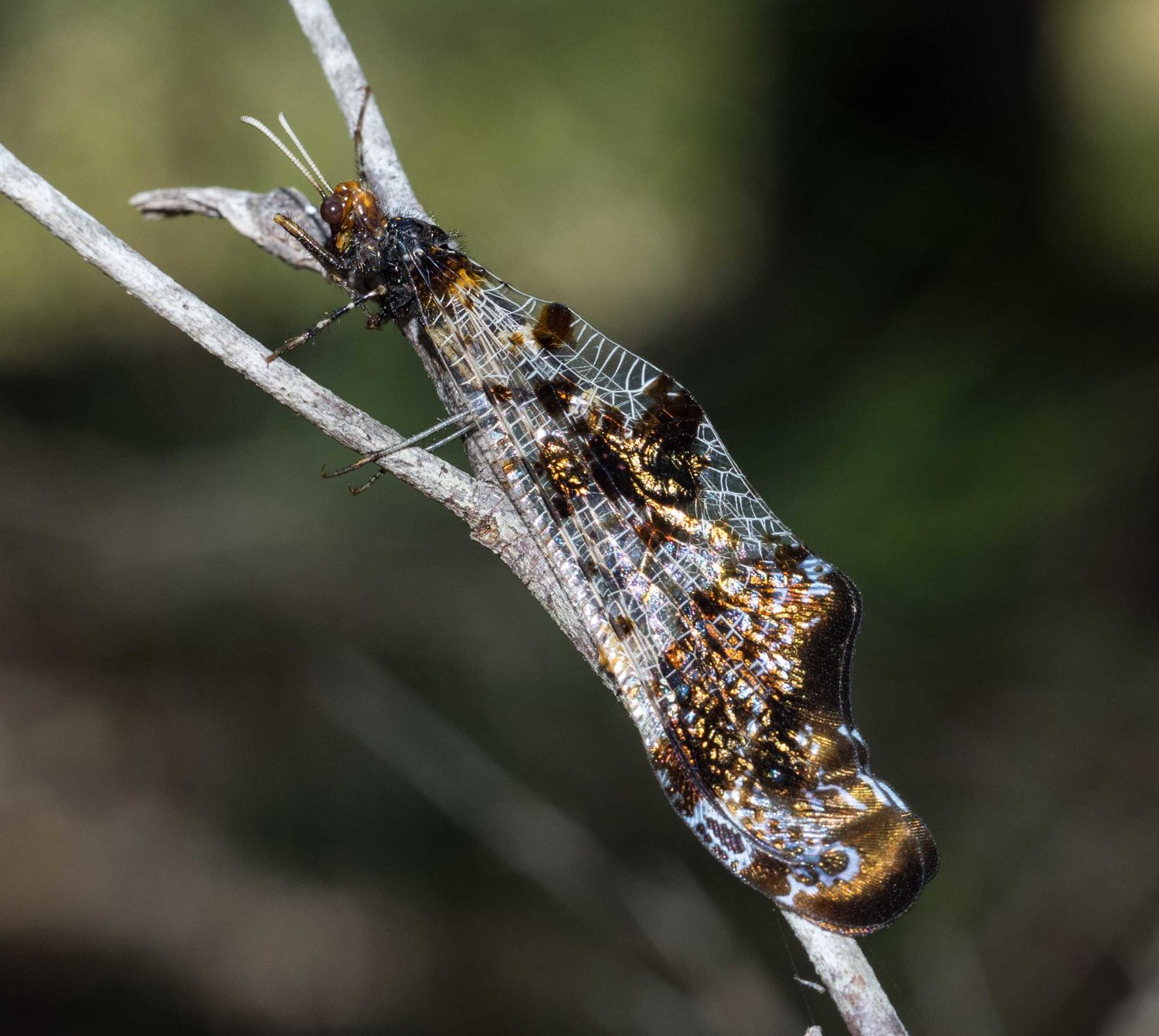
Angular-wing Lacewing
Periclystus circuiter
This large lacewing is perfectly camouflaged in the forest. Its larva is the familiar "antlion", which constructs a pit trap in loose soil to trap prey.
Order: Neuroptera; Family: Myrmeleontidae
Photo taken in January

Australian Christmas Jewel Spider (female)
Austracantha minax
Small it may be (8mm wide), but this orb-weaver has a striking shape and colouration. We often see this spider in groups, with their webs strung between low bushes or rushes, such as Lomandra.
Order: Araneae; Family: Araneidae (Orb-weavers); sub-group: Araneinae (classic orb-weavers)
Photo taken January
NOTE: Spiders belong to the class Arachnida, a totally separate arthropod class to the insects (class Insecta). But spiders are not the only arachnids. The spiders are grouped together in the order Araneae. We show representatives of two other orders - Trombidiformes and Scorpiones- toward the end of this image collection.

Australian Christmas Jewel Spider (male)
Austracantha minax
The expanded pedipalps show that this is a male. It is smaller than the female and has less prominent spines. This individual was not in a web, but roaming around low vegetation near the females.
Order: Araneae; Family: Araneidae (Orb-weavers); sub-group: Araneinae (classic orb-weavers)
Photo taken January
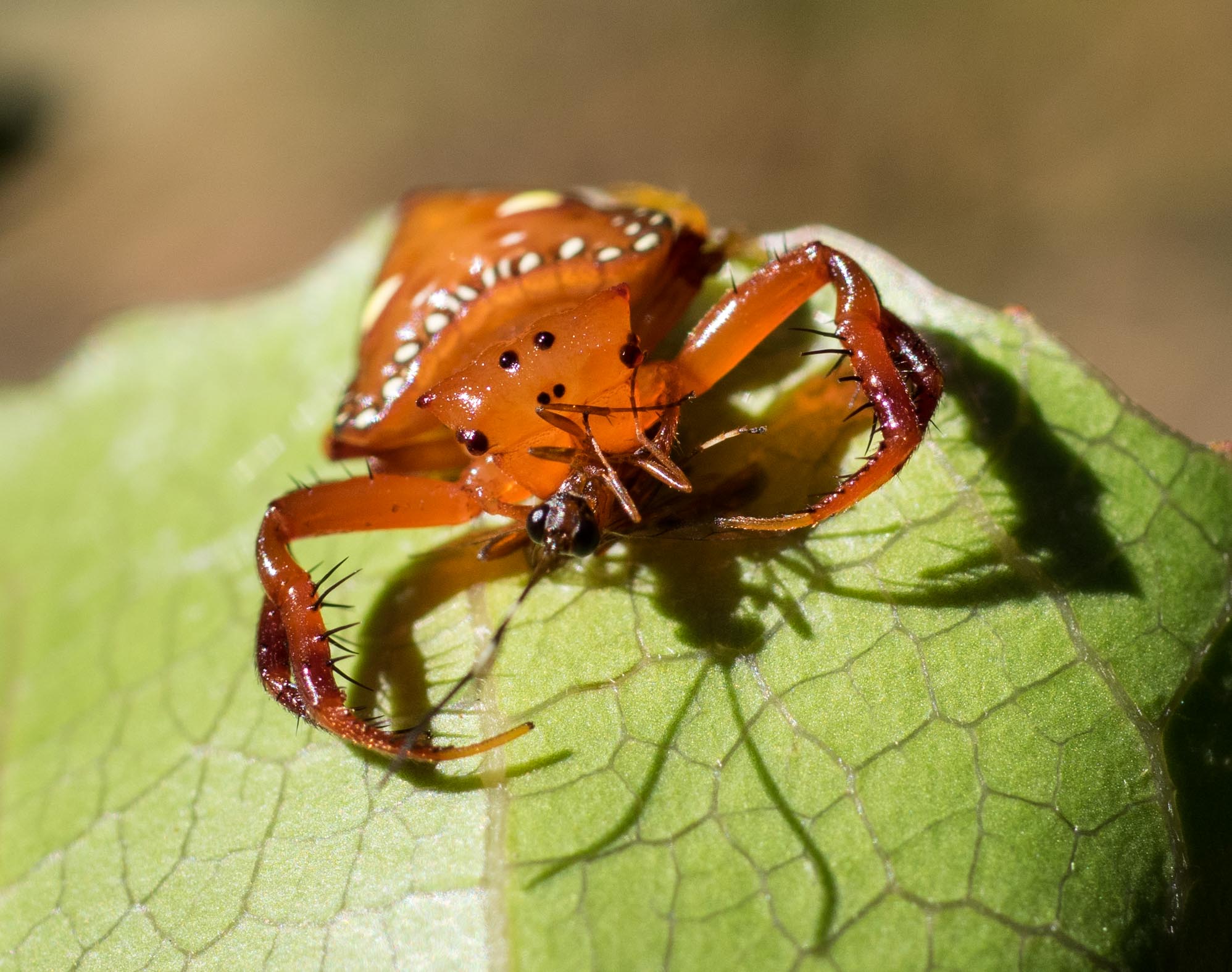
Common Triangular Spider
Arkys lancearius
This group of spiders evolved from orb-weavers, but abandoned the mode of prey capture typical of that group. Instead, they hunt by ambush - lurking in foliage then jumping on their prey and grasping it with their greatly enlarged forelegs, which bear inward pointing spines.
The spider shown here had recently mounted a successful attack on a wasp. Arks typically hunts at night, hiding in foliage during the day. This shot was taken in the early morning, so perhaps they take any chance that presents to secure a meal.
Order: Araneae; Family: Arkyidae (ambush hunters)
Photo taken in March

Flying Peacock Spider
Maratus volans
This beautiful, tiny (5mm long) spider belongs to the jumping spider family, Salticidae. As the name implies, this group of spiders catch their prey by stalking, leaping and pouncing on it. The name 'peacock' comes from the fact that this species raises the pair of brightly coloured flaps over the abdomen during courtship.
We see Maratus volans throughout the summer months, typically on low bushes and grasses.
Order: Araneae; Family: Salticidae (jumping spiders)
Photo taken November
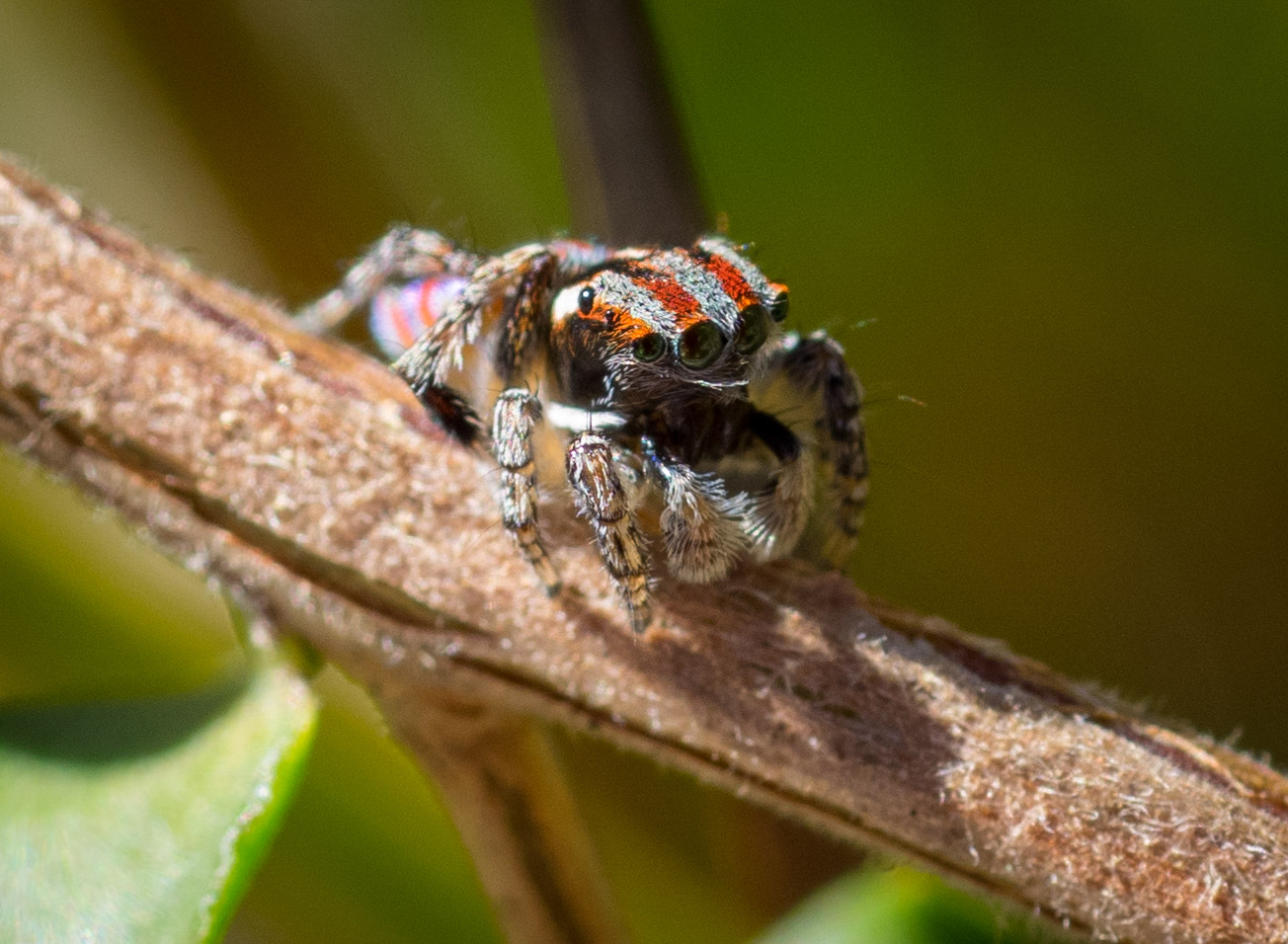
Flying Peacock Spider
Maratus volans
The pair of large, central eyes is a diagnostic character of jumping spiders - and one that adds to the popular appeal of this group.
Order: Araneae; Family: Salticidae (jumping spiders)
Photo taken October

Jumping Spider
These tiny predators are everywhere. This one was clearly guarding her nest, coming forward to check on me, but quickly disappearing again into this well-camouflaged little hide in the seed head of a sedge.
Order: Araneae; Family: Salticidae (jumping spiders)
Photo taken in November
As Robert Whyte and Greg Anderson say in their new book 'A Field Guide to Spiders of Australia':
"Jumping Spider Diversity - so many species, so little time" (p.224)

Lozenge-shaped Flower Spider (female)
Australomisidia pilula (?)
Small, colourful spiders that adopt a sit-and-wait hunting strategy are a photographer's delight. In Summer, you don't have to search the forest for long before you find an intriguing and tiny hunter, lurking in the vegetation.
Australomisidia pilula is an ambush hunter, like the Common Triangular Spider, but unlike the latter, Australomisidia hunts during the day. It is commonly found lurking amongst flowers. scuttling out when its prey approaches. It preys on insects and even other spiders.
Order: Araneae; Family: Thomisidae (crab spiders)
Photo taken in November
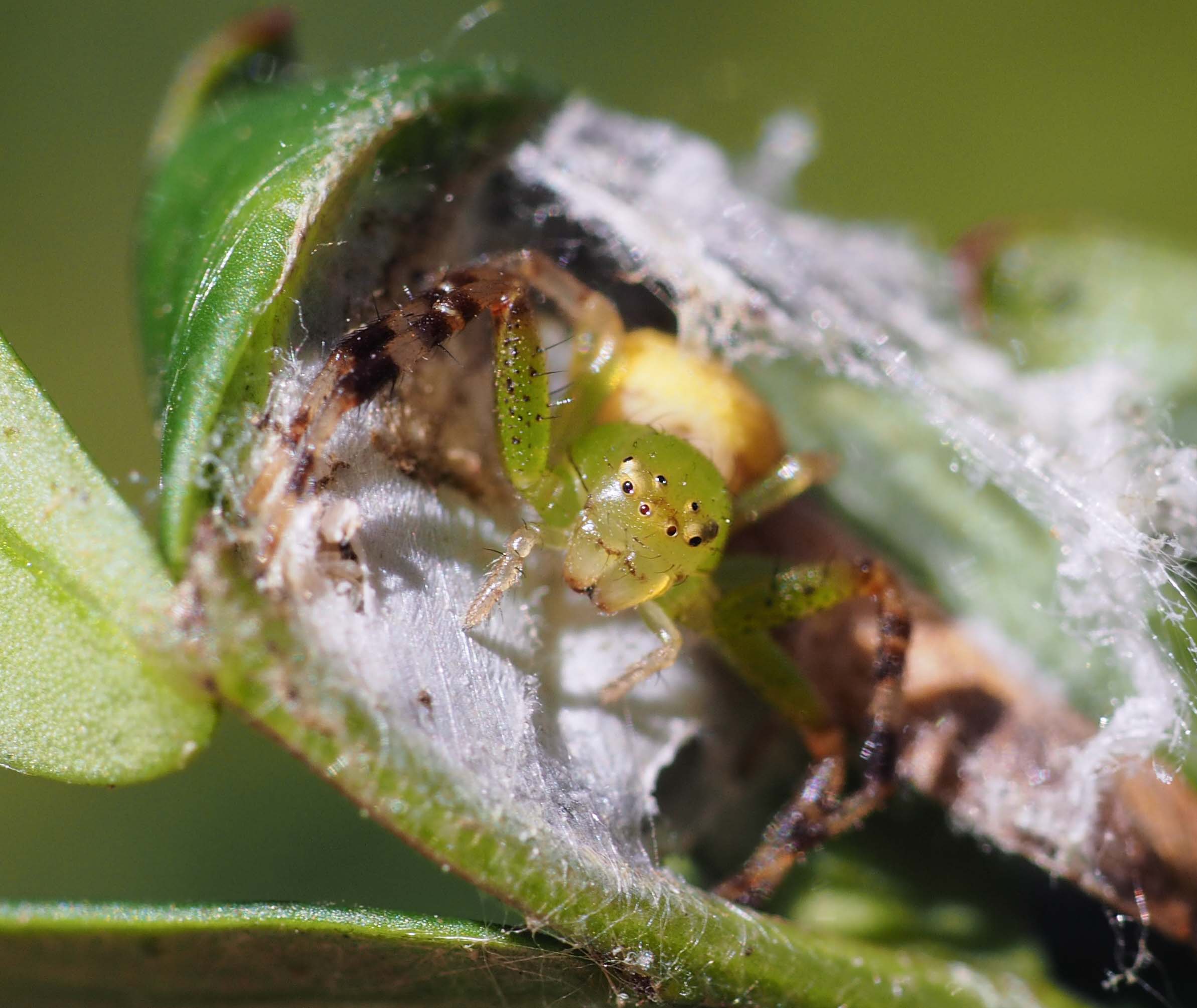
Lozenge-shaped Flower Spider (female)
Australomisidia pilula
This female is guarding her brood of spiderlings, hidden inside a folded leaf, held together with silk.
Order: Araneae; Family: Thomisidae (crab spiders)
Photo taken in December
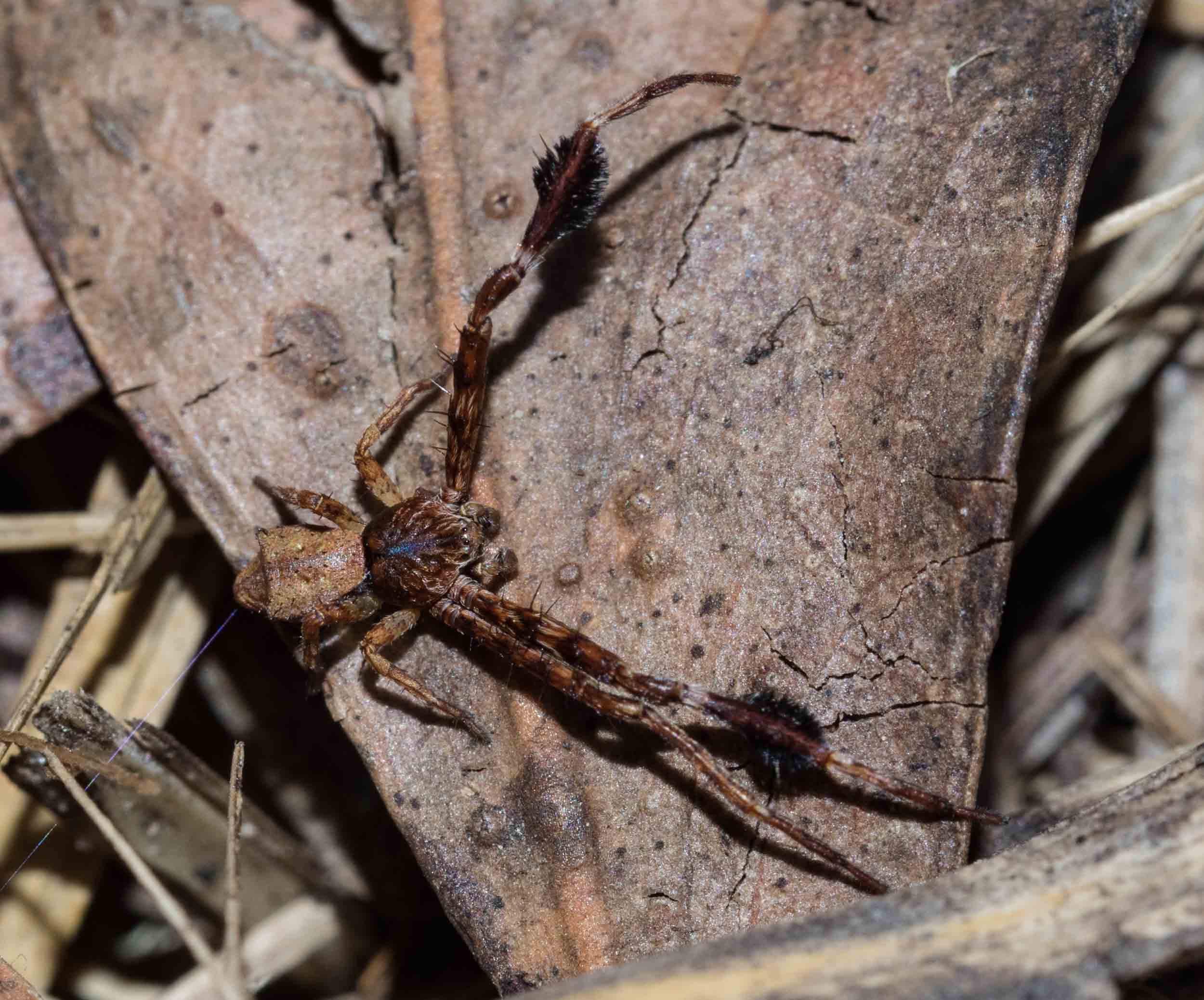
Bearded-legs Crab Spider
Stephanopis barbipes
These tiny ambush predators blend in beautifully with the leaf litter of their hunting ground.
Order: Araneae; Family: Thomisidae (crab spiders)
Photo taken in December

Bearded-legs Crab Spider (male)
Stephanopis barbipes
Only the males have hairy legs! Presumably, therefore these 'beards' are involved in courtship.
Order: Araneae; Family: Thomisidae (crab spiders)
Photo taken in December
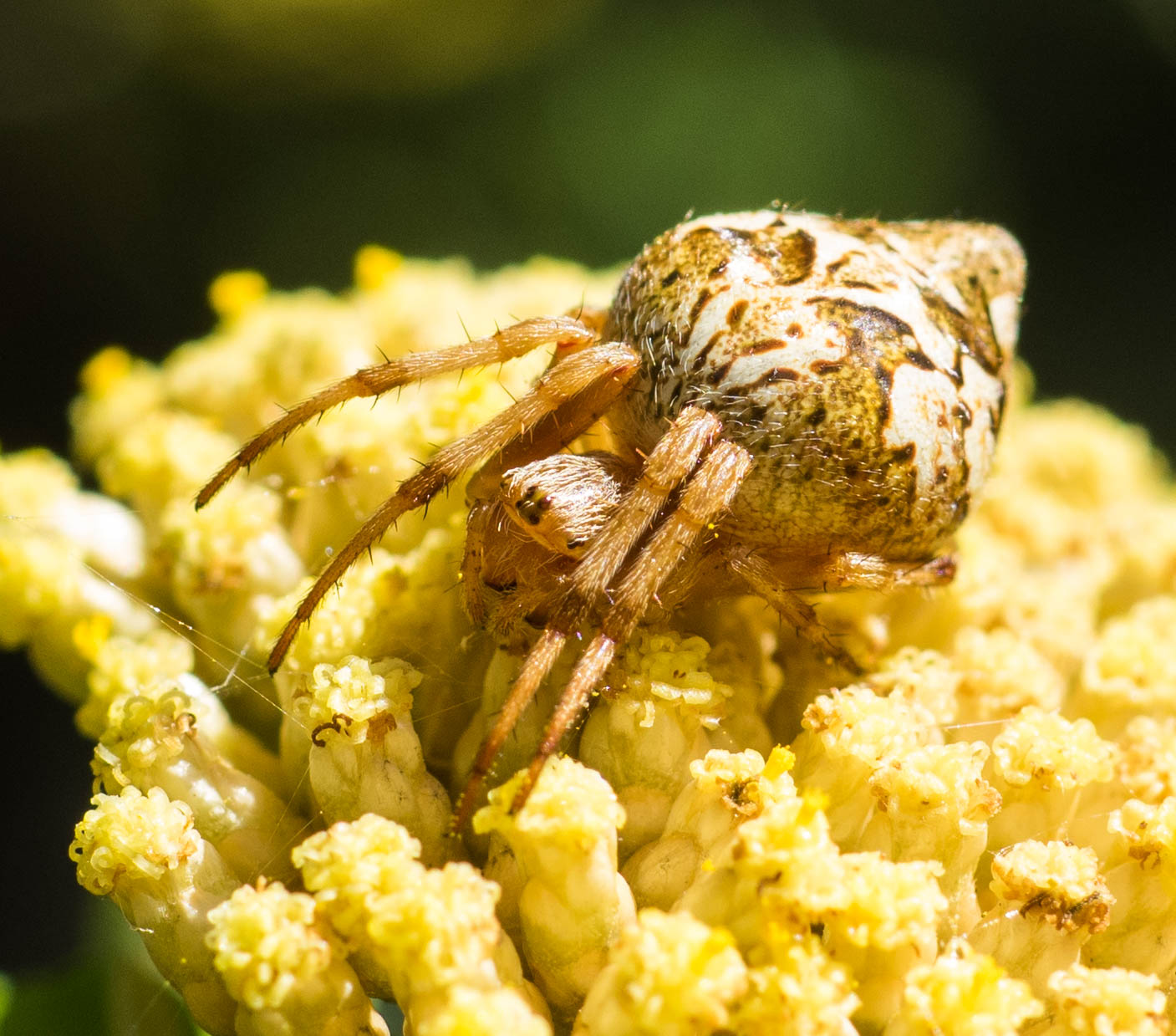
Pointy Orb-weaver
Araneus acuminatus (?)
Sitting atop this Ozothamnus flower head, the little hunter is beautifully camouflaged.
Order: Araneae; Family: Araneidae (Orb-weavers); sub-group: Araneinae (classic orb-weavers)
Photo taken in November

Half Orb-weaver
Araneus dimidiatus
In Spring and Summer there are folded leaves hanging suspended from scrappy-looking webs throughout the forest shrub layer. They are all spider retreats. Each leaf is rolled over and held with silk.
Here I have peeled open such a leaf in order to view the occupants. In this particular species, male and female spiders share the same retreat. The male appeared to actively guard the fat-bodied female, posturing and concealing her with his own body.
Many different spider species use curled leaf retreats.
During the day, the only sign of these spiders are their protruding leg tips. At night the spiders emerge to feed on insects trapped in a familiar orb web, woven in a low bush.
This is clearly an important food resource for many of the insectivorous birds. We see species such as the Yellow-faced Honeyeater systematically searching folded leaves, trying to extract the spiders inside. For a 'retreat', I often think the folded leaf actually advertises the spiders' presence!
Order: Araneae; Family: Araneidae (Orb-weavers); sub-group: Araneinae (classic orb-weavers)
Photo taken October
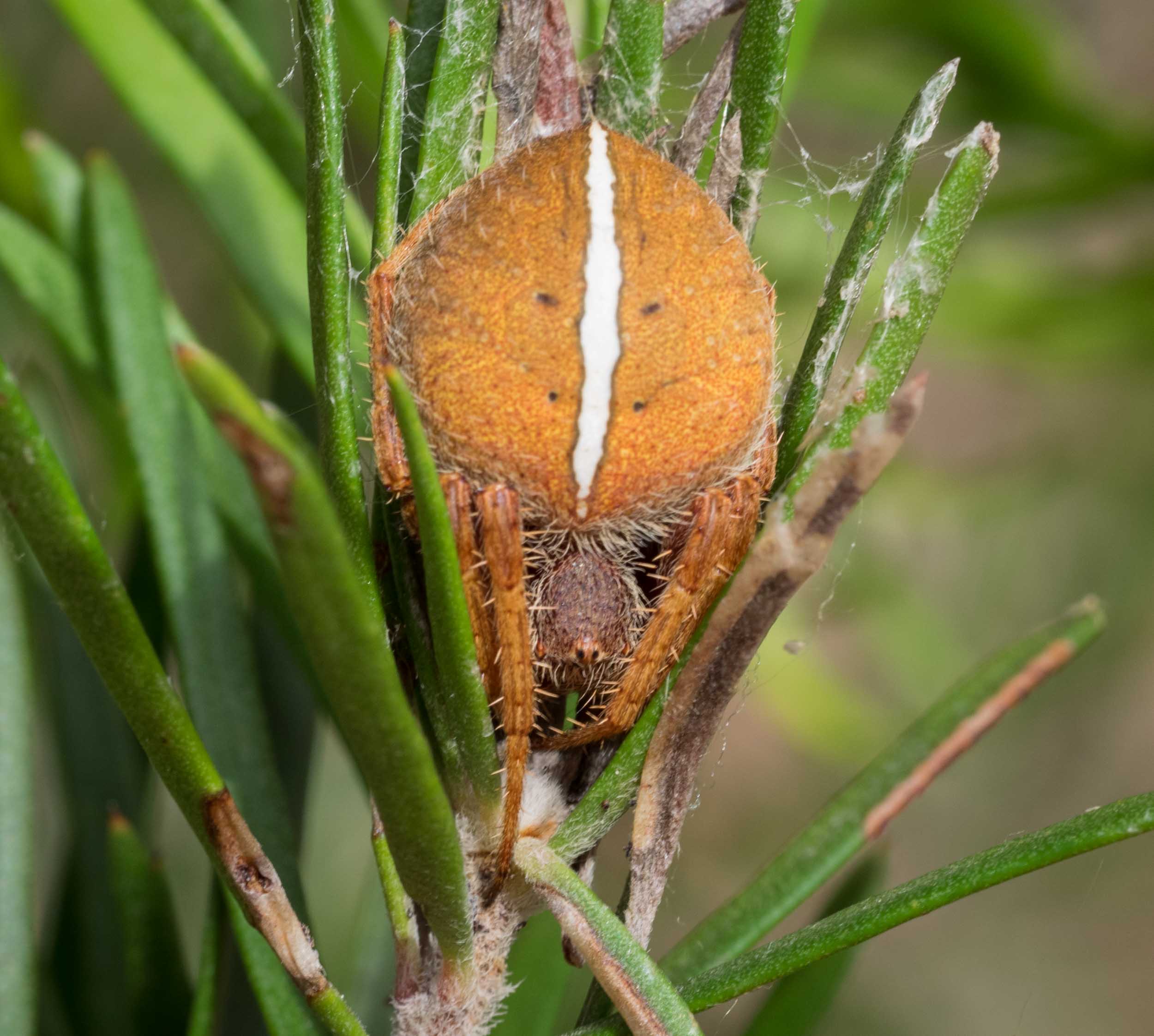
Garden Orb-weaver
Eriophora transmarina ?
This large, bright-orange beauty sat 'hidden' among the leaves of a single Persoonia (Geebung) bush for a couple of weeks. Perhaps a different colour might have helped with the camouflage (?)
Eriophora show great variety in colour and patterns - yet another tricky spider to identify with any degree of confidence.
Order: Araneae; Family: Araneidae (Orb-weavers); sub-group: Araneinae (classic orb-weavers)
Photo taken in February
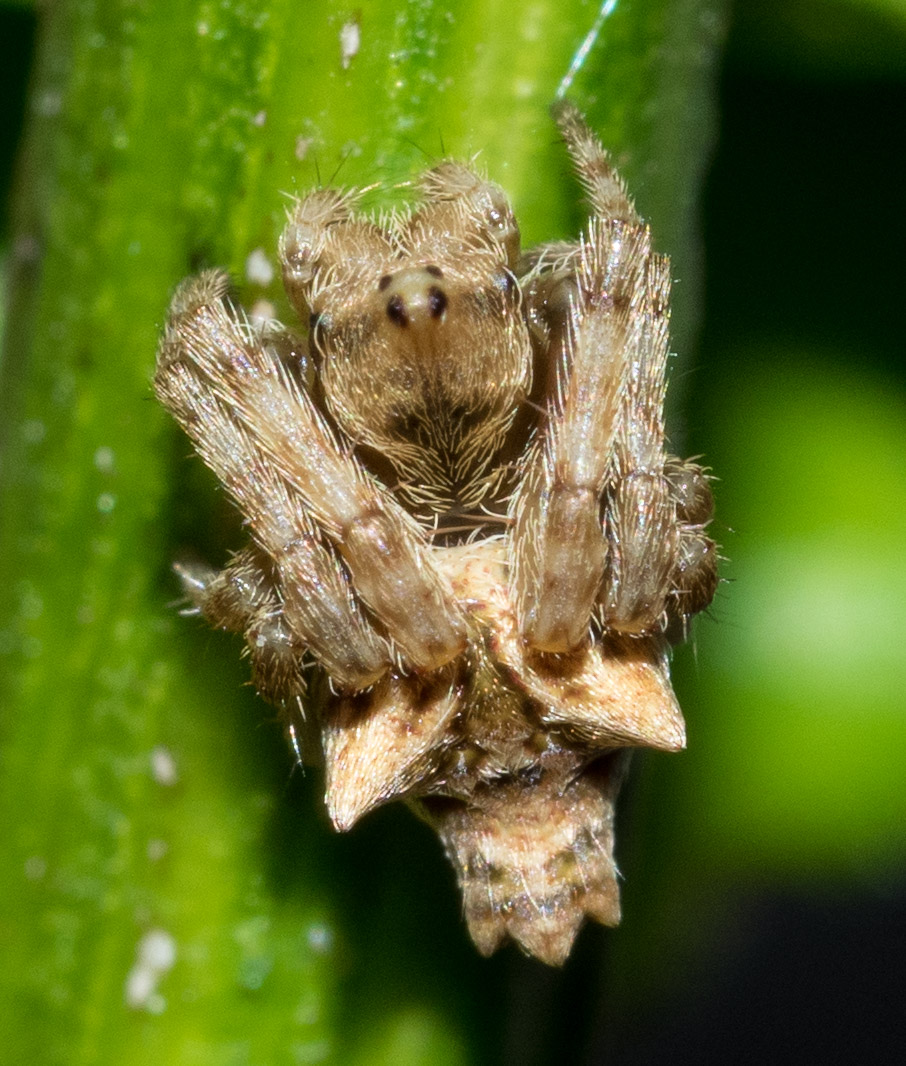
Tailed Orb-weaver or Knobbed Orb-weaver
Araneus senicaudatus or Eriophora pustulosa ... ?
These mid-sized orb weavers can be so tricky to identify. In general, they hide in the bushes during the day, building their orb webs afresh each night.
Order: Araneae; Family: Araneidae (Orb-weavers); sub-group: Araneinae (classic orb-weavers)
Photo taken in November

Union-Jack Wolf spider
Tasmanicosa sp.
Now for a group that are REALLY tricky to identify to the genus or species level.
Wander through the bush at night and you quickly realise that wolf spiders are everywhere! They are nocturnal hunters, seeking and capturing their prey on the ground. They have a distinctive eye pattern, and their eyes are highly reflective in torchlight - making them ridiculously easy to find.
Order: Araneae; Family: Lycosidae (wolf spiders)
Photo taken in February
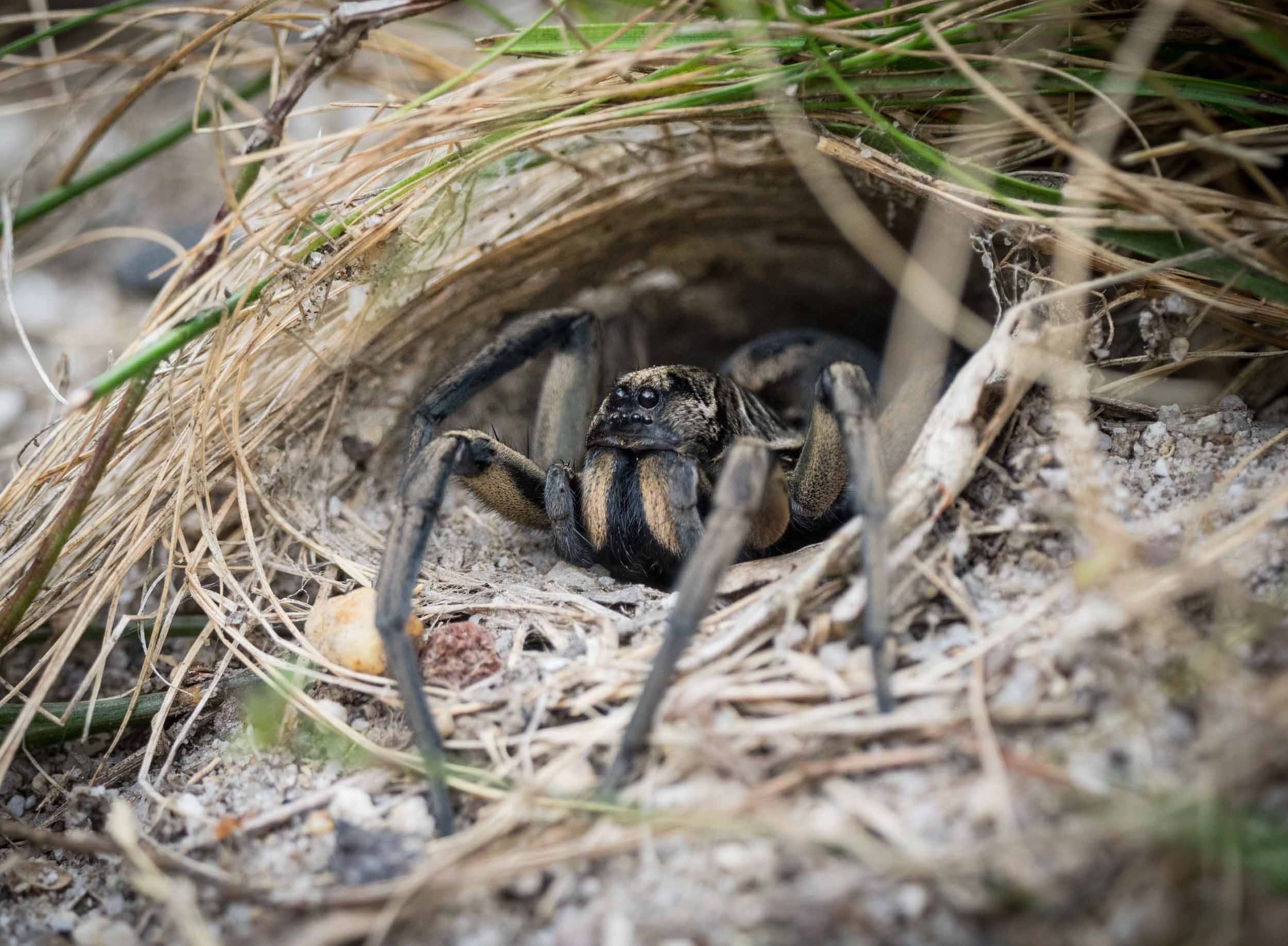
Union-jack Wolf spider
Tasmanicosa sp.
At least some of the local wolf spiders build burrows in the sandy soil. Vegetation is often used to line the entrance, and sometimes to obscure the burrow. The spider disappears in backwards if disturbed but will otherwise peer from the doorway. They can be coaxed to pounce on a teasing grass blade, no doubt demonstrating the technique they use to attack passing prey.
Order: Araneae; Family: Lycosidae (wolf spiders)
Photo taken in January
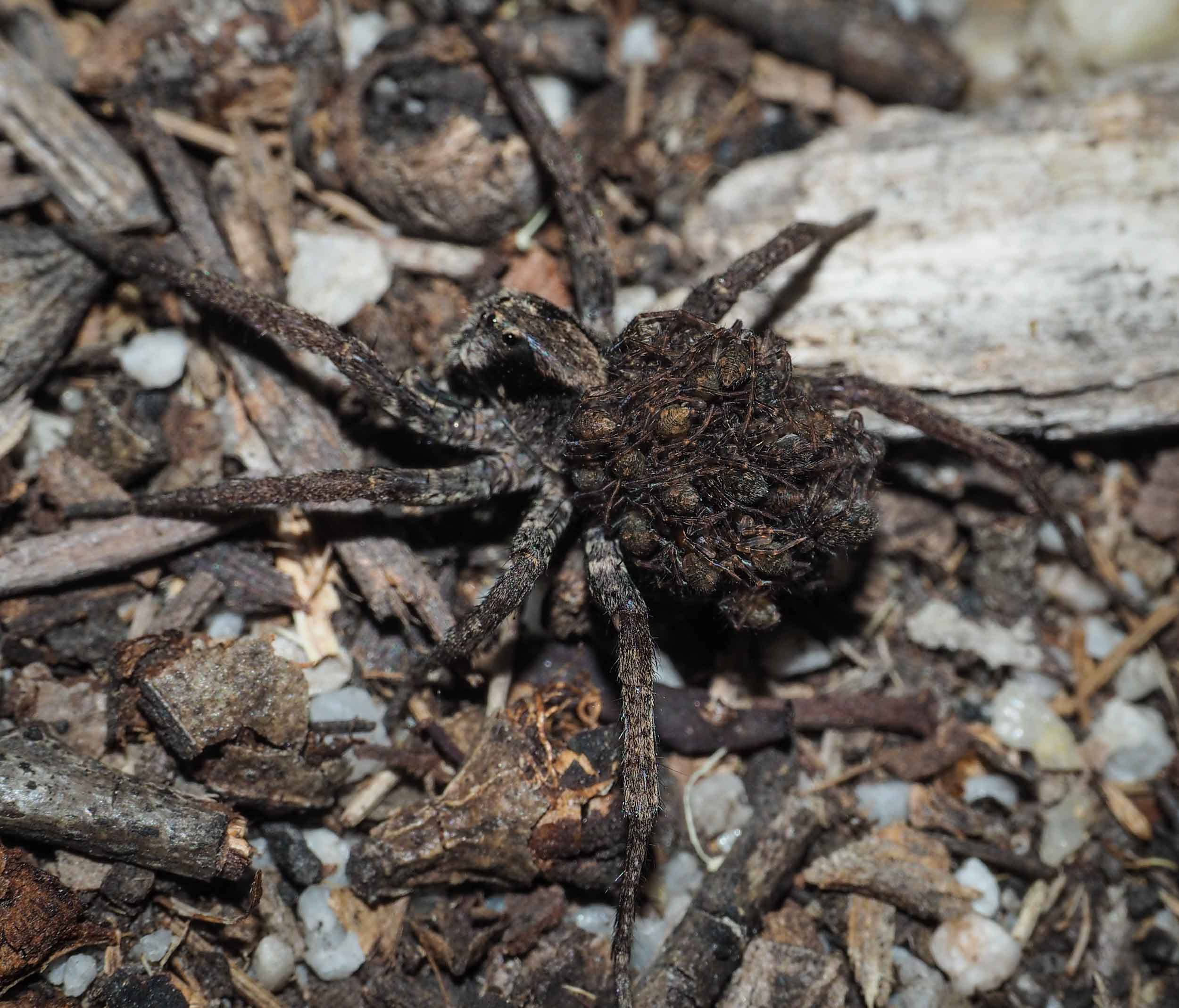
Wolf Spider
Hogna sp. (perhaps)
And this is what wolf spiders are particularly famous for!
In many species, the female will carry around a silken egg sac until it hatches - and then she carries all the little spiderlings safely about on her back.
Order: Araneae; Family: Lycosidae (wolf spiders)
Photo taken in January

Wolf Spider
Hogna sp. (perhaps)
A close up ... just in case you missed it!
Order: Araneae; Family: Lycosidae (wolf spiders)
Photo taken in January
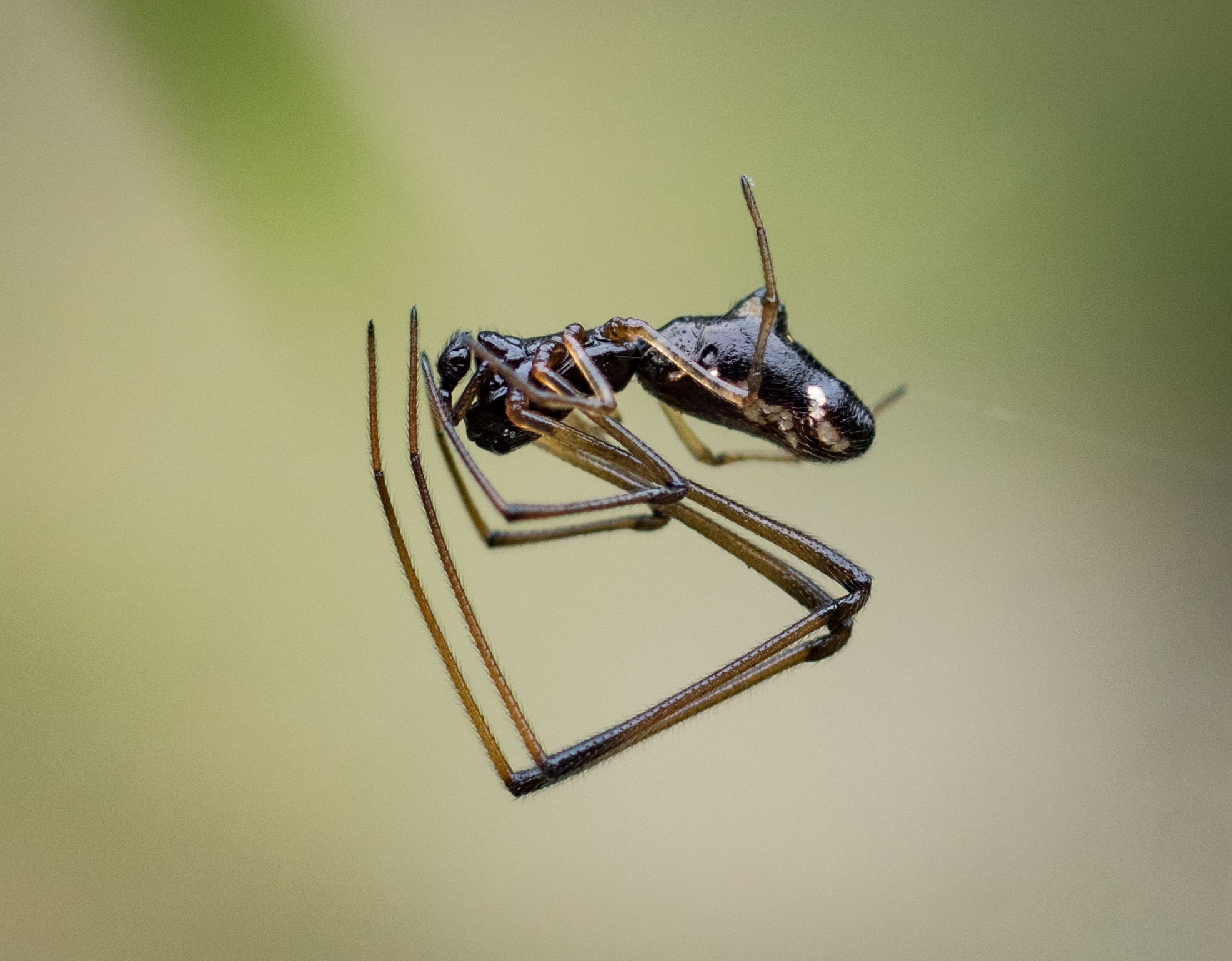
Rainbow's Dew-drop Spider
Argyrodes rainbowi
The silver patches on this species are eye-catching. It is otherwise an easily overlooked spider. Argyrodes are tiny. They usually inhabit the webs of other spiders, 'stealing' from the larger spiders' catch or, perhaps, collecting the scraps.
We found this individual in the web of a leaf-curling spider (Phonognatha graeffei). The related Dew-drop Spider, Argyrodels antipodianus, we reliably find wherever a Nephila spins her large golden web.
Order: Araneae; Family: Theridiidae (comb-footed spiders)
Photo taken in February
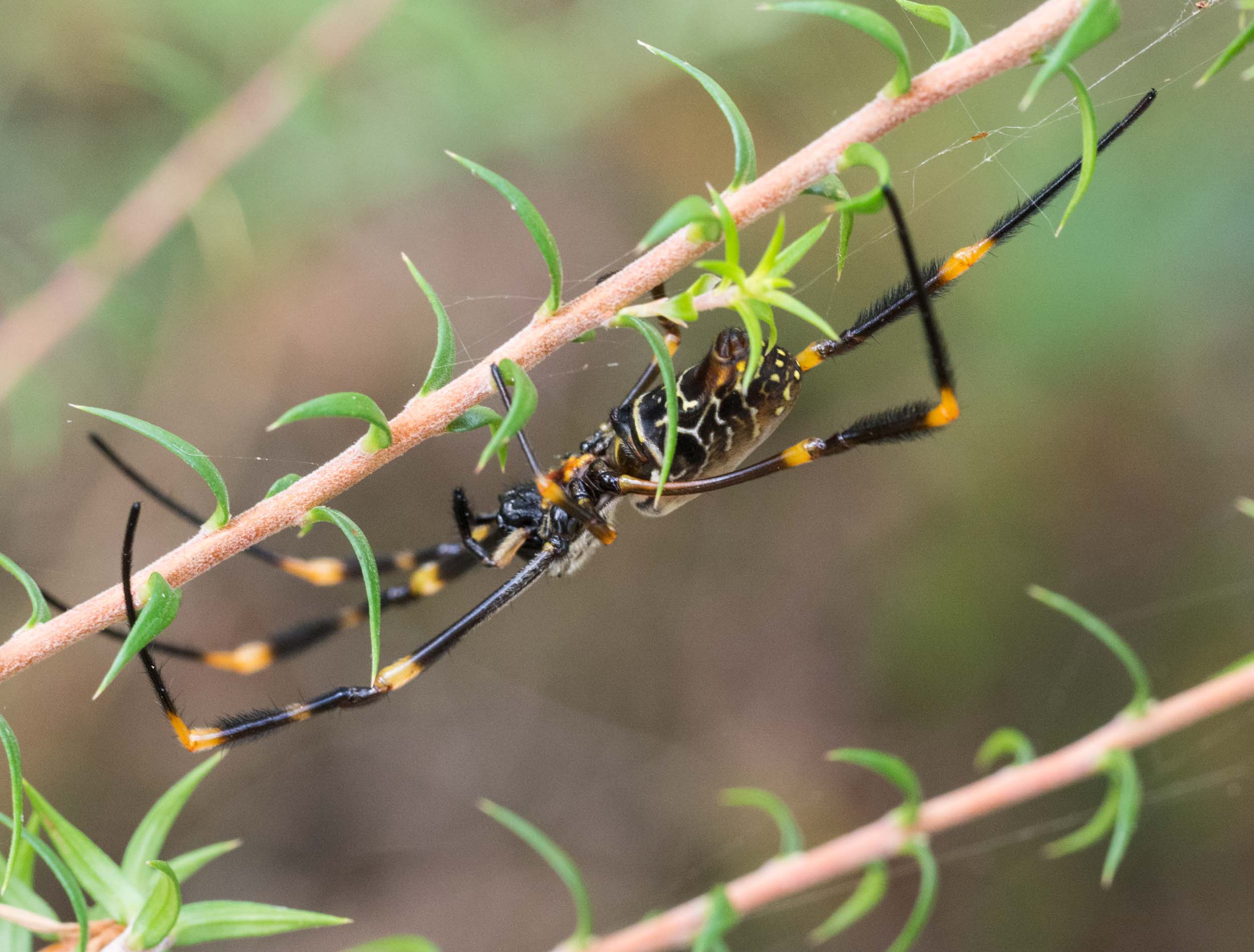
Eastern Golden Orb-weaver
Nephila plumipes
Each Summer we see only one or two of these large, distinctive and well-known orb-weavers here in the forest environment. Once established, an individual female may occupy the same site for many weeks. The female is the obvious spider. The males are tiny in comparison.
The golden silk of the webs is strong and the webs are often large - several metres across. Despite the strength of the silk, however, they do suffer damage from errant birds and large, trapped insects. The webs become progressively untidy, 'patched', and filled with old prey, until what was once a gleaming work of art is really quite a tatty 'mess'.
Order: Araneae; Family: Araneidae (orb-weavers); subfamily: Nephilinae (golden orb-weavers)
Photo taken in March
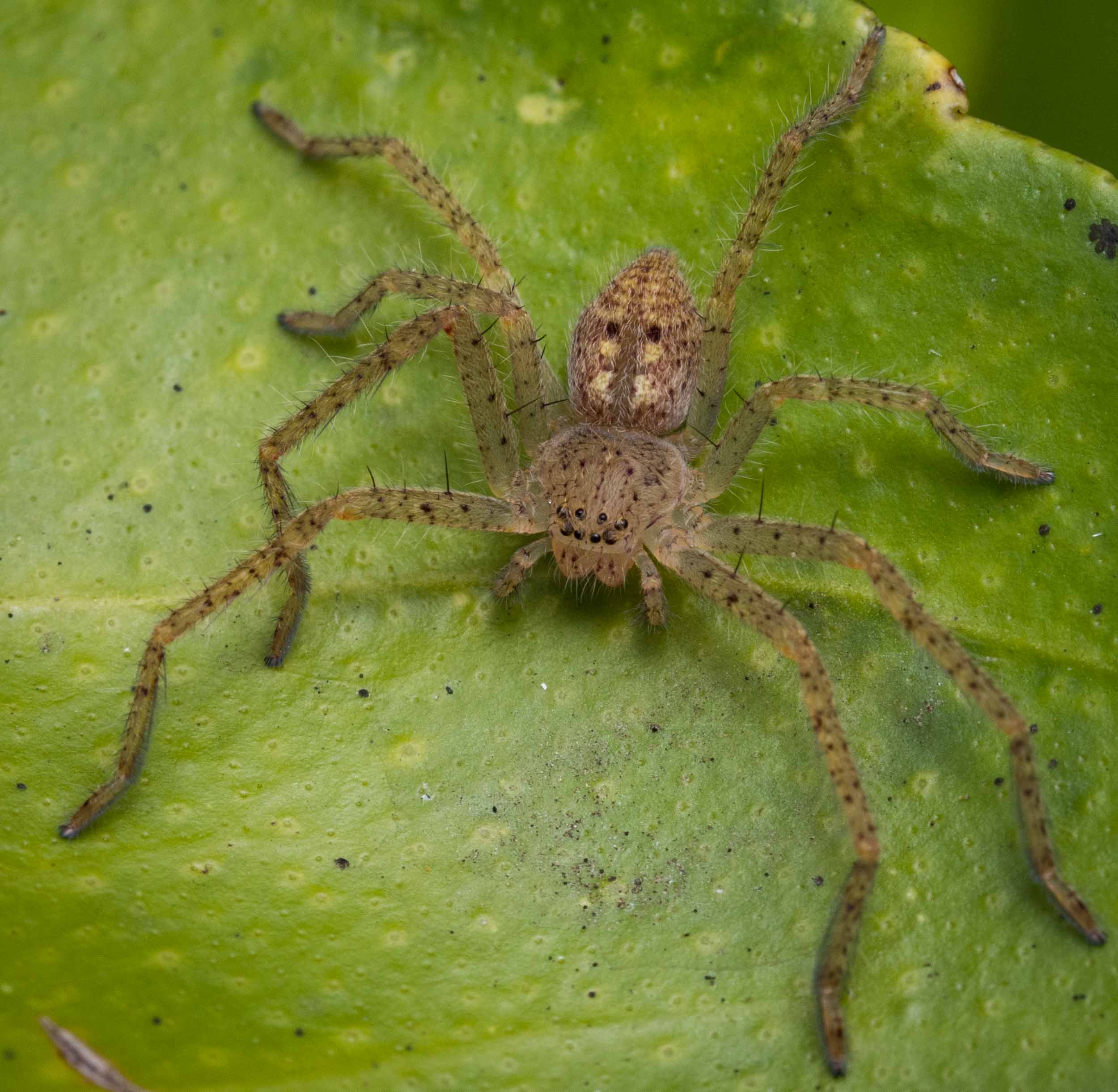
Huntsman
Neosparassus sp. (perhaps)
Huntsman of all sizes and many species are a feature of Summer. Some become quite large, others are small and fragile. This one may even be a juvenile.
They are active, nocturnal hunters and it is common to find them in the morning, consuming moths.
Order: Araneae: Family: Sparassidae (huntsman spiders)
Photo taken in January
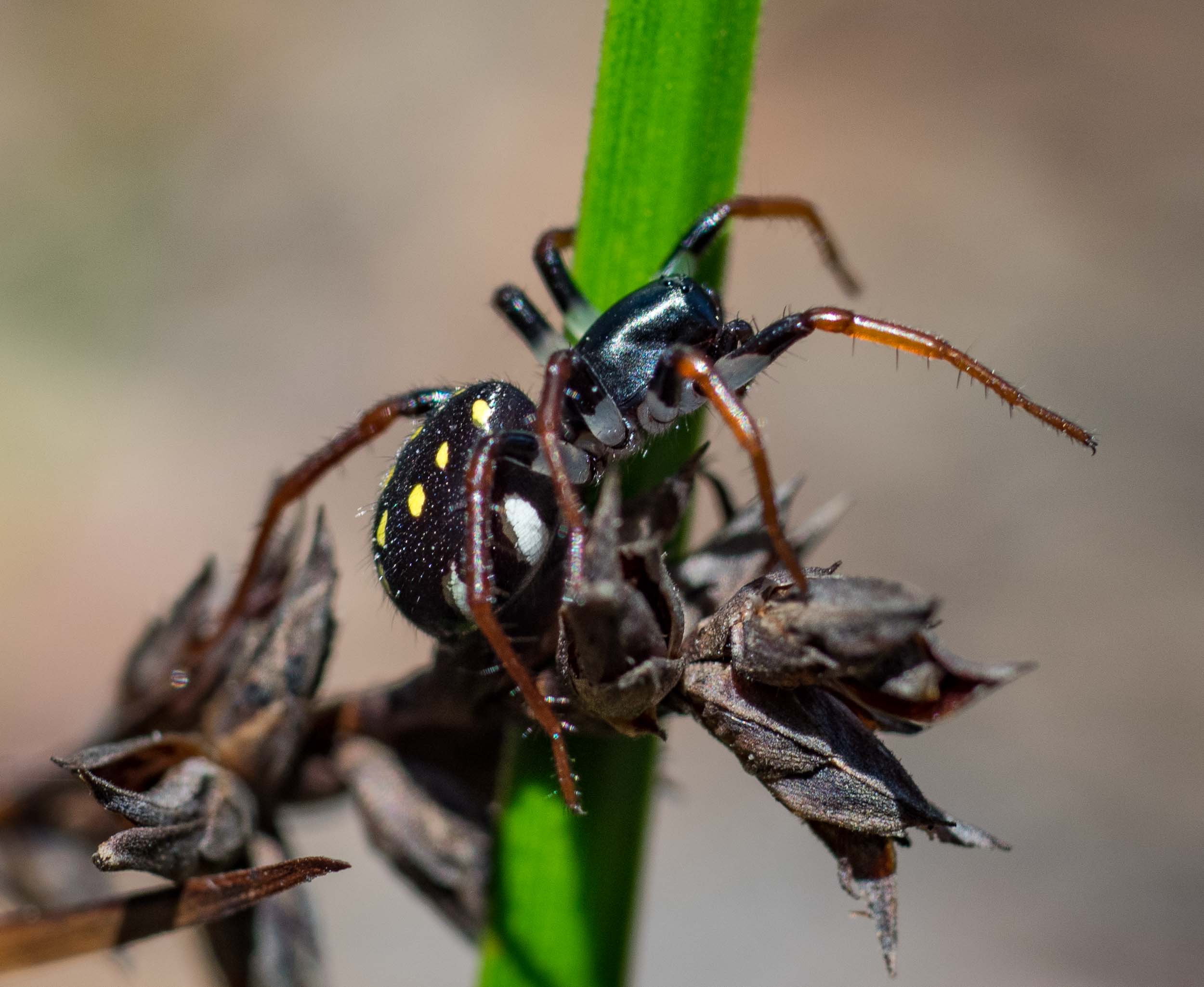
Ant-eating Spider
Habronestes sp.
This pretty, ant-eating spider is displaying its characteristic ant-mimicking stance: the front legs mimic antennae. We often see them moving about the ground cover, no doubt on the hunt.
Order: Araneae; Family: Zodariidae (ant-eating spiders)
Photo taken in December
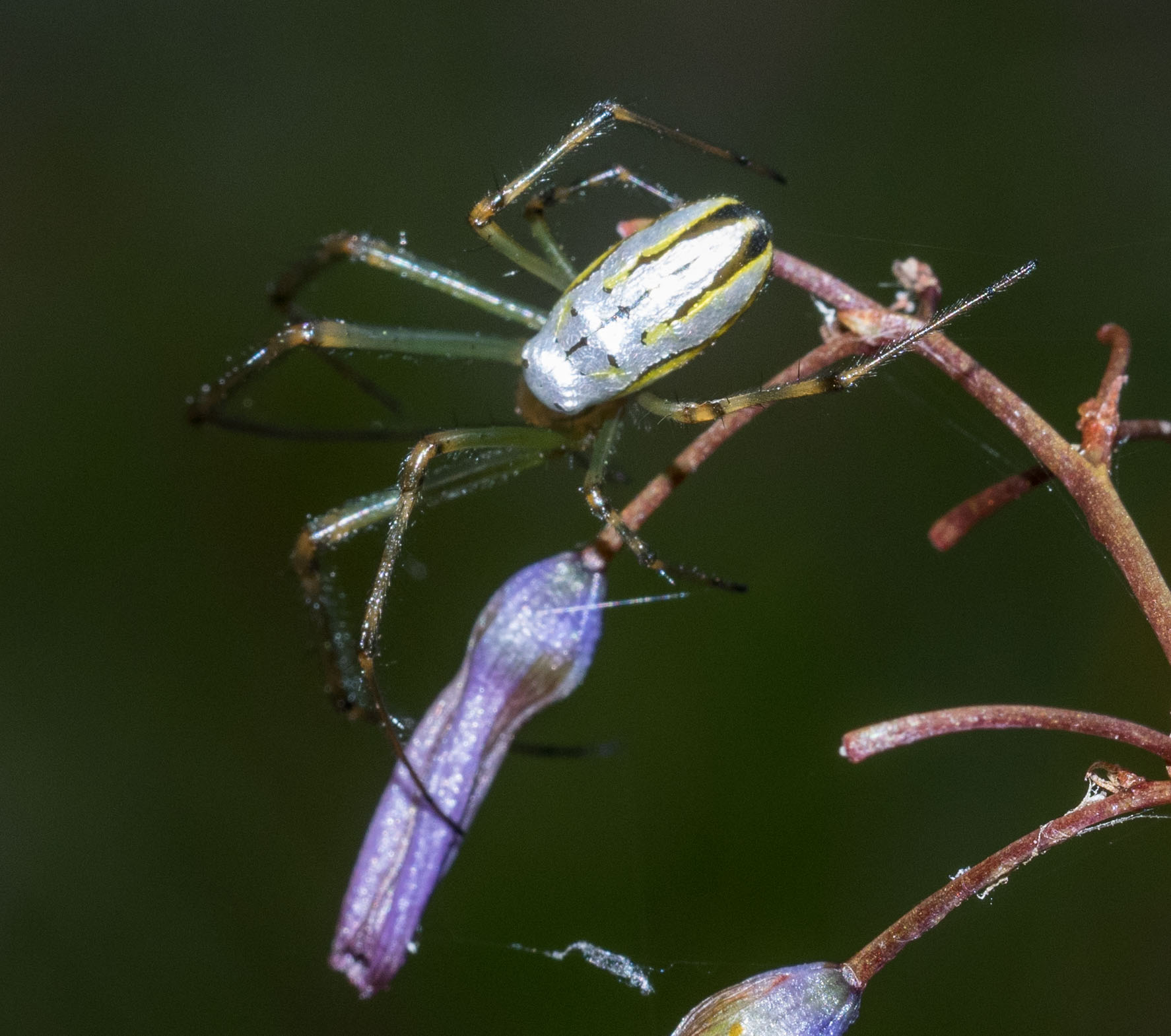
Silver Orb-weaver
Leucauge sp.
We don't really know a lot about this spider. I am tentatively identifying it as a Tetragnathidae (long-jawed spider), but need to make more observations - and images. Such a pretty thing!
Order: Araneae; Family: Tetragnathidae (Long-jawed Spiders)
Photo taken in November
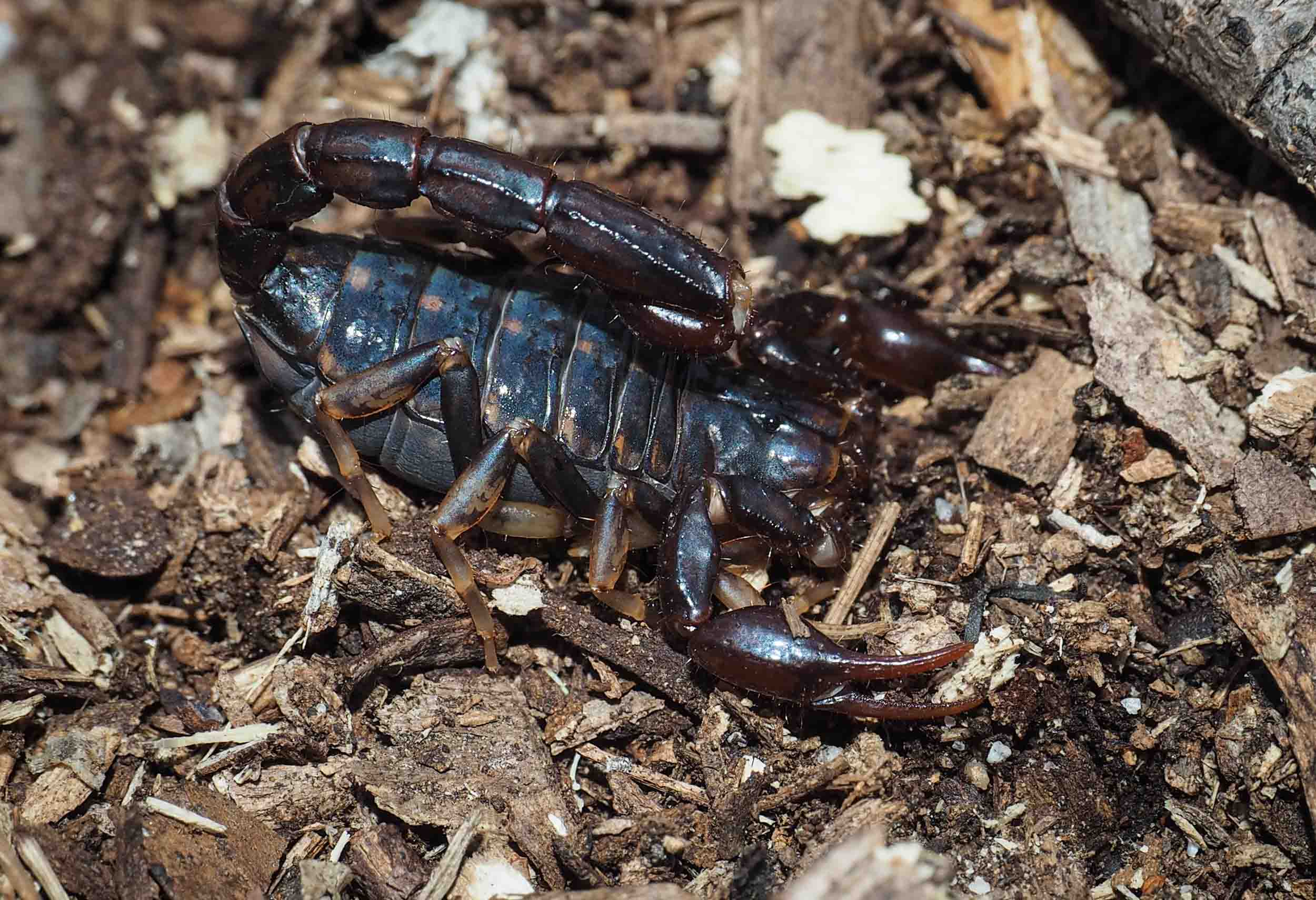
Forest Scorpion
Cercophonius squama
This is where we leave the spiders, but not the arachnids. Scorpions belong to a distinct order within the class Arachnida.
This rather fearsome looking predator is quite small - just 30mm long (not counting the impressive 'tail'). We often find them under wood and bark. They apparently feed on any invertebrates they come across, such as beetles, cockroaches, and millipedes.
The family Urodacidae contains just this single genus, 21 species, and is only found in Australia.
Order: Scorpiones; Family: Urodacidae (Australian burrowing scorpions)
Photo taken in October

Forest Scorpion
Cercophonius squama
This individual is no doubt feeling a bit unhappy at being disturbed. The outstretched tail is ready to strike. The white, feathery structures seen protruding between the second and third pair of legs contain specialised vibration receptors which help the scorpion detect nearby prey.
I have been stung by one, once. It hurts, but not for long. I didn't see the scorpion while I was digging in the garden - no gloves! - and obviously managed to dig through its burrow. No wonder it got cross.
Order: Scorpiones; Family: Bothruiridae
Photo taken in April
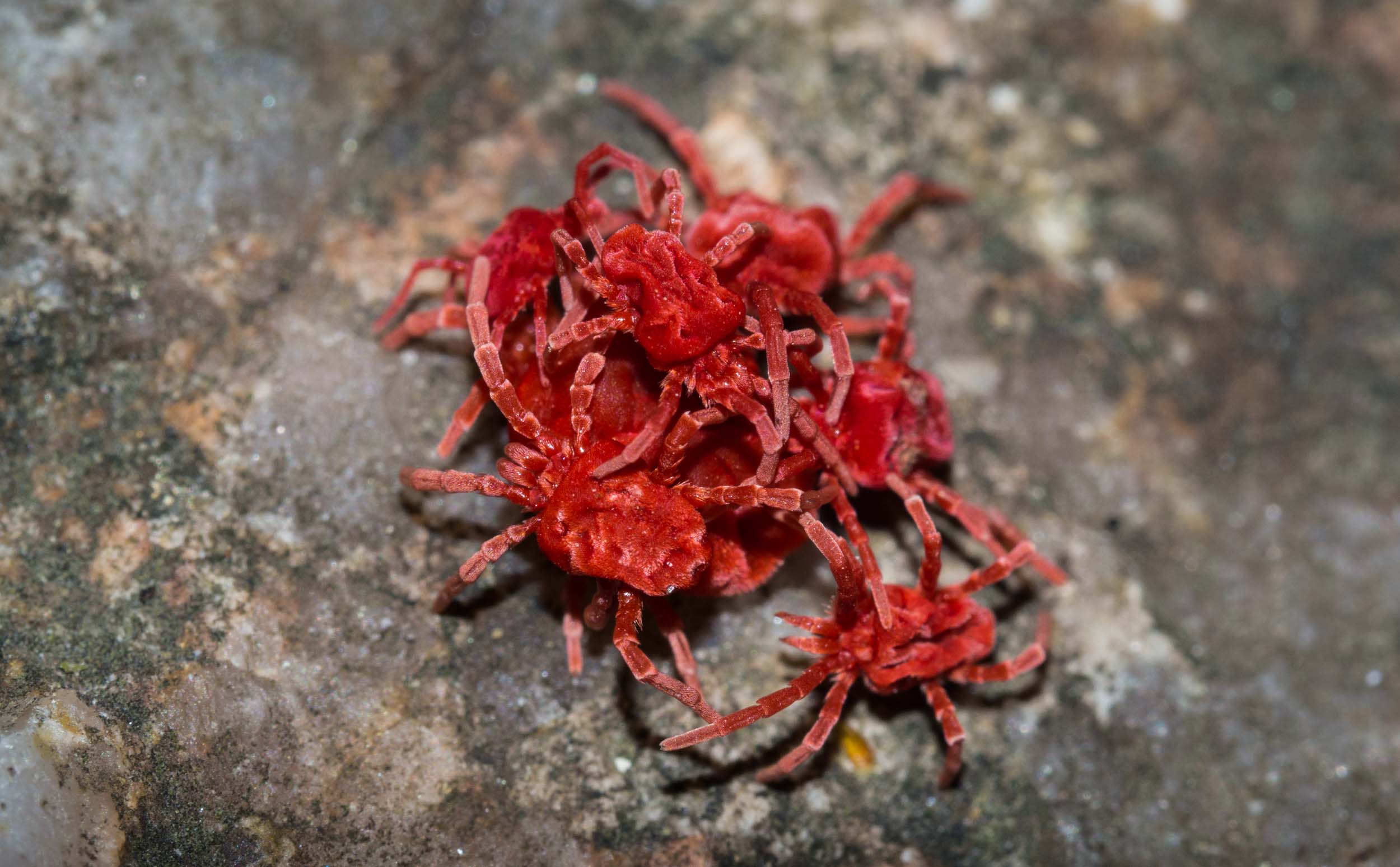
Red Velvet Mite
Trombidium sp.
Yet another arachnid that is not a spider.
We often find these mites crawling around the surface of the soil in Autumn. This image shows a larger mite - 4.5mm long - surrounded by a cluster of smaller individuals - 1.5mm long - which we presume to be males trying to mate with a single female. Adult mites eat insect eggs.
Order: Trombidiformes; Family: Trombidiidae (red velvet mites or rain bugs)
Photo taken April
